Behavioral Science – Workshop 1 (Successful Planning)
The Appleton Greene Corporate Training Program (CTP) for Behavioral Science is provided by Dr. Heft Certified Learning Provider (CLP). Program Specifications: Monthly cost USD$2,500.00; Monthly Workshops 6 hours; Monthly Support 4 hours; Program Duration 12 months; Program orders subject to ongoing availability.
If you would like to view the Client Information Hub (CIH) for this program, please Click Here
Learning Provider Profile
Dr. Heft is Behavioral Scientist and Psychologist dedicated to helping people and organizations become more successful. Understanding that we, as humans, are surprisingly unaware of why we do what we do and what influences our decisions, she is committed to leveraging the power of behavioral science to improve lives. Dr. Heft delivers science-based solutions that drive higher performance through consulting, training, and coaching. She has over 25 years of experience in Fortune 500 companies as an internal consultant. Her educational background includes a Bachelor of Science degree in Business Administration, a Master’s in Psychology, and a Ph.D. in Industrial/Organizational Psychology. Dr. Heft started a Behavioral Science function at a large financial services firm, where she applied the insights of Behavioral Science to the table to solve a wide range of challenges. One of the larger scale projects included conducting a multi-year research project to align behavioral science research related to motivation, reward, and recognition systems to drive performance. In addition, recognizing individual differences in motivation, they segmented the sales group to tailor solutions and drive performance. Today, she continues to consult with them on major projects and conducts research to leverage behavioral science principles to get better results. Since she worked as an internal consultant, Dr. Heft has a deep understanding of the opportunities and challenges facing you. This background helped her build a Behavioral Science program that is extremely practical and focused on helping you navigate your organization to deliver better results every day.
MOST Analysis
Mission Statement
The first module, Successful Planning, guides participants in taking the necessary steps to establish a successful project. Planning is often an overlooked but extremely critical part of a BS project. During the workshop, participants will gain an understanding of their role as the process leader, the roles of other stakeholders, and best practices for engaging with their stakeholders. In order to effectively prepare, they’ll be introduced to several key planning tools. More importantly, they’ll be provided with a foundation for the basic components of data collection, analysis, and reporting. Getting a head start on data collection is a vital ingredient for facilitating a successful project.
Objectives
01. Start Planning: Identify the critical factors involved in embedding the BS Process in your organization. Prepare the BS Process Leader for a Successful Launch.
02. Process Leader: Gain a deep understanding of the various roles and responsibilities of the BS Process Leader in order to successfully lead the project.
03. Define Problem: Too often, projects encounter issues when the problem is poorly defined or understood.
04. Identify Stakeholders: The BSPL identifies and describes several key stakeholder roles that are essential to the project’s success so they can find the best candidates for those positions on the team.
05. Current Evidence: The lynchpin of the BS process is based on the ability to compile evidence to make decisions.
06. Attitudes Matter: Provide an understanding of the importance of understanding the customer/employee’s perspective in the BS process and how to collect that information.
07. Research Agenda: The primary object of this session is to help the BSPL set a research agenda for the project by prioritizing data needs.
08. Collecting Evidence: This manual provides important information about several of the key data collection methods available for collecting qualitative data (observation, interviews, and focus groups) in order to help the BSPL pick the best method for the project.
09. Analyze Insights: Prepare the BSPL for effective analysis of data and reporting. In addition, it introduces the most popular and highly impactful tool – the survey.
10. Engage Stakeholders: Since stakeholders are very busy and have various different needs, interests, and motivations, the BSPL needs to understand how to keep them engaged with the project.
11. Selling Science: Prepare BSPL to introduce and describe the BS Process in a compelling and influential way.
12. Synthesize Plans: Help the BSPL put the project in perspective by pulling up after working through the various phases of planning and allowing them to reflect on their own attitudes about the process.
Strategies
01. Clarify several important elements of planning (e.g., risk assessment, communication methods and tools, and gaining an understanding of what has worked best in the past).
02. Review each of the seven core responsibilities of the BSPL in detail to clarify the expectations of the BSPL.
03. This section clarifies the importance of BSPL’s role in understanding the problem. We provide a process for defining the problem, along with sample problem statements. The BSPL will take the first shot at defining the problem statement. It also provides instructions on how to carry out the task.
04. We describe each key role, along with the knowledge and skills required. We also provide some alternative team member options. Finally, a tool for clarifying roles and responsibilities is offered as a best practice.
05. This manual identifies and describes evidence the BSPL needs to collect. It also provides information about the value of quantitative and qualitative data in the BS process.
06. Outlines a process for collecting qualitative data about target audience’s behaviors, interests, needs, perspectives and intentions.
07. Introduce a process to capture and then systematically rate the research needs of the project in order to prioritize the most critical. In addition, learn how to identify the characteristic of the sample of the target audience.
08. The pros, cons, and best practices for three key qualitative data collections methods (observation, interviewing, and focus groups) are outlined. In addition, recommendations for procedural best practices are provided to prepare the BSPL and team.
09. Outline the pros, cons, and best practices for surveys to help BSPLs validate assumptions and data collected with small sample using other tools. Also provides instruction on analyzing and reporting on research.
10. Outlines best practices and BS principles that will increase engagement of stakeholders. This starts in the planning phase and first contact.
11. Strategies for introducing BS to stakeholders are reviewed as well as BS principles that will support stakeholder commitment to the project.
12. Also acknowledge 2 BS principles that may apply to the BSPL personally and address.
Tasks
01. Identify key milestones. Build the first draft of a project plan.
02. Identify strengths and opportunities for development related to the key responsibilities. Identify stakeholders who can complement your skills where there may be gaps.
03. Collect preliminary, existing data related to the problem.
04. Develop the first draft of the problem statement.
05. Fill the key stakeholder jobs. Clarify responsibilities for each of the stakeholders.
06. Collect, record, and track evidence relevant to the challenge. Similarly, compile and log unanswered questions.
07. Determine a preliminary plan for collecting data. Develop a recruiting message for collecting data from customers and employees.
08. Select a data collection methodology. Establish the research agenda by prioritizing the research needs.
09. Finalize decisions on data collection methods and draft survey questions as needed.
10. Draft the initial invitation for stakeholders to meet to discuss the project. Draft the agenda for the initial meeting.
11. Develop messaging, definitions, and a story for discussing BS with stakeholders.
12. Create a to do list, work with other BSPLs in the company to develop some of the information and tools needed to proceed. Land on a project.
Introduction
The first module in the Behavioral Science Corporate program is called Successful Planning. It focuses on helping the BSPL set the stage and prepare for leading a project that delivers extraordinary results. This module will assist the BSPL in establishing a solid foundation and successfully initiating the project.
This introduction will cover the following topics:
1. What do we mean by planning?
2. What’s the current state of planning, and why is it so important?
3. Why it’s important to focus on planning in the BS approach
4. Why planning is important
5. What BS has to offer that makes planning more effective
6. What does the planning module cover?
7. BS cases around planning

Planning simply involves considering the necessary tasks and organizing them before beginning the actual work. It involves considering the end goal, determining the steps needed to reach the goal, diagnosing the problem, identifying the resources needed to complete the steps (e.g., time, people, tools, and data), the enablers to the process (e.g., communication methods, team processes, and dynamics), barriers to success, and then creating a framework to enable the process to work as effectively as possible.
This is where you cross the T’s and dot the I’s. It’s where the scope of the project is laid out, where the timeline, costs, deliverables, and details are ironed out. We set expectations and identify assumptions at this stage. Before roles are assigned and the team starts working on the plan, project planning entails a thorough mapping and arrangement of the project’s objectives, tasks, schedules, and resources. As you can see, there is some complexity and discipline involved in this kind of work.
Before we get into the specifics of the connection between BS and planning, it would be helpful to share some information on the abysmal current state of planning in general.
Current Position
• According to the Project Management Institute, organizations were wasting an average of $97 million for every $1 billion invested due to poor project performance.
• Thirty-seven percent of projects fail because leaders don’t define project objectives and milestones clearly.
(Source: Click Here)
• 80% of organizations report that they spend at least half their time on rework. (Source: Geneca)
• When team leads don’t effectively manage requirements, 47 percent of projects fail to hit their targets.
(Source: Click Here)
• 38% of companies believe that the greatest barriers to success are confusion about team roles and responsibilities. (Source: Geneca)
The first point of connection to BS pertains to the type of work involved in planning. Planning requires us to take time to stop and think, to look ahead, to anticipate obstacles, to consider needs, different paths to get work done, potential skills, and people who might be able to help. It requires us to make some estimates about needs and resources, align resources to those needs, and organize all of that information in a way that is easy to understand and follow. Just making that list feels like a lot of work.
As humans, most of us resist this type of complex thinking involved in planning. We prefer fast, action-oriented, and easy-to-do work. For most people, the kind of work we can do automatically without thinking is preferred over work that requires consideration, contemplation, and deliberation.
However, implementing a BS process in your company will require you to move the organization toward a deeper way of thinking, a different way of operating, a new way of tackling problems, and developing solutions. This begins with planning. In fact, you can think of planning as a kind of microcosm of BS.
As you get started on your projects, one of the first things the BSPL must do is create a plan. Now for those of you who are familiar with planning may think that this is pretty basic, right? If you are already a skilled planner, great, you’ll have a jump start on applying your knowledge and experience with planning to the BS process. However, even those who are expert planners, will learn about planning is applied somewhat differently in the BS process. The following paragraphs will describe more about that. Now this may not seem like the most exciting content, but there’s more than meets the eye in this section.

BS is a different animal:
On many other kinds of projects, building a good project plan can be quick and easy. However, in the BS process, the job of planning will be much more complex and more of a drawn-out process. This is because the challenges you will tackle in the BS realm are likely to be deeper and more multi-faceted. Consider the name BS, science is not something that evolves quickly. Scientists think about what factors impact outcomes, they do research to test hypotheses, and they analyze results. When they don’t get the results they expected, they go back to the drawing board. There is nothing fast about science.
Keep in mind that as a BSPL, you are leveraging real science. Understanding and influencing human behavior is not fast or easy, but it will yield extraordinary results. The diagnosis process will be more comprehensive, the identification of barriers and potential solutions will all be broader and more complex. Because BS is different, we can’t overstate enough the importance of planning.
You are introducing a new process.
Because BS is more complex, the process involved is more involved and requires a more disciplined approach to solve these meaty challenges. As humans we all resist change, and as was mentioned earlier, we also resist complex thinking. Since resistance to any new process is naturally higher, it makes the stakes involved in getting it right even more important.
Great results are the payoff. As you are aware, you are leveraging BS as a way to get superior results. So, you want the process to be as beneficial as possible and deliver on the promise of achieving a different kind of outcome. As the leader of the project, you have a significant stake in making sure it is effective and delivers great results for your company. Following the BS process is crucial for your success. Like any process, there are many places where the work can go off the rails, so to speak. Planning is one of the key factors in ensuring a successful project. It may not be the most enjoyable component of managing projects, but it is the most vital part of reducing risk and failure rates.
Accelerate adoption of BS. The BS process will likely continue to be considered “new” for a long time after you get many projects completed. Change takes time, and your organization will need time to acclimate to the new process. This process will most likely be much different from your company’s typical method of solving problems. The company’s acceptance of the process will be faster if stakeholders like it and see positive results from its use. Planning is a key factor in ensuring the project goes well. As the BS advocate in your company, you’ll want the stakeholders involved in the project to be excited about how it works and about the different results that come from the BS process. In order to have the BS approach gain a foothold in your company, and be in demand, you’ll want the best results possible, which will only be possible with careful and thorough planning.
The BSPL’s success. As the BSPL, you will be in the spotlight, working on applying the Behavioral Science approach to your projects. If the project is successful, it will be personally rewarding and will reflect well on you as a leader. Team members will appreciate being a part of a well-organized and well-led process. They will be more helpful during the process and will want to work with you again on future projects. Of course, this could have a positive impact on your job performance and future career prospects.
As the BSPL, you’ll learn about the various roles you have in leading this important work. It will take some time to build knowledge, experience, and confidence. Careful planning can help you feel more confident faster. It allows you to think ahead to each phase in the process and mentally rehearse and prepare for what is ahead to avoid surprises. This is especially critical as you are learning and growing your BS acumen.
Applying the BS approach to planning: The Successful Planning Module
The first module, Successful Planning, guides participants through the whys and hows needed to take the necessary steps to establish a successful project. Planning is often an overlooked but extremely critical part of a BS project.
Roles and Stakeholders: During this workshop, participants will gain an understanding of their role as the process leader, the roles of other stakeholders, and best practices for engaging with their stakeholders. As was mentioned previously, there is great benefit from having an effective working team and from them having a positive experience. This module’s sections and tools will greatly assist you in guiding them through the process and ensuring their successful engagement.
Planning Tools: In order to effectively prepare, the module will introduce several key planning tools. Even if you are a skilled planner, you’ll hear about how these tools apply specifically to the BS process. These tools include, for example, an insight collection template, a data collection prioritization tool, RASCI charts, and sample timelines.
Evidence-Based: More importantly, this module provides a foundation for the basic components of data collection, analysis, and reporting. Getting a head start on data collection is a vital ingredient for facilitating a successful project. In addition, the planning process includes several sections on data and experimentation. The BS approach plays a crucial role in 1) data-based decision-making, 2) learning through testing, and 3) experimenting. In fact, these are core elements of every BS process. This module includes a strong grounding in the core principles of data collection and lays a foundation for setting a research agenda for the project. This work is critical to begin in the planning phase because data collection often takes time. Having the data collected, analyzed, and available to help make decisions in later phases of the project will be important.

BS Acumen: Additionally, the BSPL will gain an understanding of eight BS principles to utilize during the planning process. This will help the BSPL start building the BS subject matter expertise needed to lead others in the organization. This module also includes twelve case studies to help understand how other companies have used the BS principles to get better results and to help participants apply the principles they are learning.
Intro to Benefits and BS
Below are some of the basic benefits of planning. After considering the list, you may wonder why so many organizations fail at planning or why they rush through this important step. That is where BS comes in to help understand what isn’t working. As the leader of the BS process, it will be critical that you don’t fall victim to some of these challenges.
Why is planning so important?
1. Performance increases with planning.
With careful project preparation, you can prevent the issues that cause projects to fail. Without this vital step, it is almost certain things will fall through the cracks, and a project team is bound to miss crucial details, deadlines, and eventually deliverables. Planning, when done well, lowers expenses, conserves resources, and enhances workplace morale and company culture. A successful project will be your reward if your planning process is accurate and focused. Process leaders, project owners, teams, sponsors, and stakeholders all greatly benefit from project planning. Planning is necessary to determine desired outcomes, prevent missing deadlines, and eventually deliver the agreed-upon good, service, or outcome.
2. Reduces risk
Risk is always lurking in the background, whether at a micro or macro level. What may seem like a minor risk to a task could pose a larger threat later during project execution. Proper planning allows teams to ensure that risks can be mitigated and that smaller tasks roll up into milestones that meet the larger goals of the project, reducing potential risks.
 2. Planning is cost-effective
2. Planning is cost-effective
Project failures can be costly. Even when a business completes a project successfully, they may still spend a significant amount of additional money that wasn’t necessary due to poor planning. Unexpected problems, scope creep, and delays are common in poorly designed projects. A project that steadily expands in scope (and expense) as a result of unanticipated events or modifications is known as scope creep. Project planning helps to avoid inefficient practices and activities by giving the execution stage structure and foresight. For this reason, businesses that adhere to sound project management procedures waste less time and money than those that do not.
3. It enhances group communication
Effective communication is critical to the successful completion of any project, regardless of scale or nature. Project stakeholders need to have excellent communication skills to ensure they complete project duties accurately and on schedule. Planning for effective communications between all stakeholders (leaders, team members, and those outside of the team) is essential, especially when a project includes numerous employees, teams, outsourced suppliers, and possibly even staff members in different regions or time zones. A good project plan considers the ways in which the team will communicate and identifies the best means of doing so, including chat, email, virtual meetings, shared documents, online tools, and more.
 4. It ensures optimal resource utilization
4. It ensures optimal resource utilization
The BSPL is responsible for securing the resources needed for the project, including the right people with the right skills and knowledge as well as their time. Resource planning is one of the most important aspects of project planning. The utilization of resources, such as personnel, tools, funds, office space, and time, forms the foundation of every project. Ensuring that a company allocates and uses resources in the most appropriate and cost-effective manner is practically impossible without competent planning. BSPL needs to consider throughout the project how effectively to allocate not only their own time but that of others because several projects frequently compete for the same resources.
4. It helps keep all stakeholders aligned
In the BS process teamwork is essential. It is essential that all team members are aware of and understand their duties and responsibilities, how their contribution fits into the larger picture, and how their actions affect the productivity of other team members. In order to do this, the BSPL must set clear expectations for them both individually and collectively. A well-crafted plan gives all involved parties an official point of reference. In this way, everyone will agree and remain informed about duties, deadlines, expectations, and work processes. It’s even simpler for all partners to access and view the project plan at any time when you utilize project management software.
Reducing project failure rates
You may wonder why people resist planning when there are so many benefits. Or what is more likely is that people give lip service to planning, taking significant short-cuts to put only the bare minimum plans in place. There are several reasons.
1. Unrealistic time pressures. Unrealistic expectations have plagued many project managers. The pressure to complete a project in a specified amount of time can create situations where people skip or rush through the planning process.
2. Negative emotion. As was mentioned earlier, the planning work is difficult, and many find it unpleasant. In addition, some people may feel less confident in their planning abilities, so move out of this phase as quickly as possible.
3. Not rewarded. Organizations often reward results rather than planning. So people are motivated to move quickly toward results. However, BSPL should be encouraged to go slow at first and go faster later. Spending more time up front will pay off with significant, high-quality results at the end of a project. If you doubt that this is true, look at the statistics at the beginning of the introduction.
4. Impatience. This can play a significant role in why BSPLs gloss over the planning phase and jump right into execution. This desire to skip over the most critical project management phase will likely result in regret and rework, at the very least.
5. Lack of understanding. Not understanding how planning affects the successful execution of projects may be one of the biggest reasons planning is ignored.
There are several BS principles that align with some planning best practices. For example, breaking things down to make them more achievable is a BS principle. Best practices in planning include breaking projects into major steps or milestones.
Tips for increasing your value and effectiveness
To become an expert at planning, work on anticipating all aspects of a project that will either create a win or risk the outcome. First, determine if the project aligns with broader business objectives. If not, a more thorough review of the project is necessary. There will be situations where a project is still required in order to address an isolated problem that may not necessarily be part of the bigger strategic picture.
Future State
Can BS really make a difference in the world? If history is a reliable indicator of the future, yes, it can. Due to its enormous potential to make significant advancements and improvements in a wide variety of situations in a vast number of important ways, interest in it has increased significantly in the past decade. In response, organizations all around the world—including governments, corporations, and healthcare organizations—have set up behavioral science departments.

In the field of BS, our approach to problem-solving is both incredibly effective, and yet presents a significant challenge. Today, we rely on existing data to diagnose and understand behavioral challenges. While the emphasis on rigorous evidence-based diagnosis and solutions is great, it may also result in an over-reliance on the past. Behavioral scientists should be particularly sensitive to the proliferation of artificial intelligence in this regard. While this can be an incredibly powerful tool, we need to heed the warning about depending too heavily on evidence and data that reflect our history, not our future.
Today, BS is used to “fix” products, services, and tools that aren’t working. We are asked to help “nudge” people in the right direction to overcome barriers or shortcomings in the systems. However, a better approach is for BS to get involved in the forefront of building the products, tools, and systems without noise or obstacles to behavior rather than “nudging” behavior in the right direction after the fact.
Research has shown that brief, focused treatments can effectively modify behavior. Simple solutions can be attractive, but there are risks involved if we can’t balance them with the complexity of the real world. These solutions may become ineffective or less successful than anticipated when settings change quickly. We need to build muscle, tools, and processes to support solving more complex problems with BS solutions.
The global COVID-19 pandemic is a good example of the complexity of challenges we have not faced in the past. Countless challenges emerged during that timeframe, with really important consequences. For example, how do we encourage people to wash their hands and wear masks, how do we slow the rapid expansion of misinformation and encourage people to think critically about that information, and how do we help people work collaboratively remotely? Behavioral Science is well positioned to offer solutions but has not been tested for answering these types of complex problems. While the field did not solve these issues in a significant way, there is hope for the future. The BS process included in this program will move closer to answering fairly complex problems in your organization.
In order to be successful handling these mega problems, it will be necessary to challenge our assumptions about how interventions and solutions function inside of larger systems. It has been suggested by some experts that part of the answer to moving BS forward is to leverage some of the very planning tools we have been talking about in this introduction. For example, a process for behavioral planning could be used to test hypotheses about how people would behave in different environments and situations, and leverage scenario testing to gain insights about what happens. This could be accomplished by looking at several future state scenarios to see how interventions might play out in a corporate environment or in various customer situations. This research could offer guideposts and direction for building more stable, more scalable, longer-term solutions to more complex problems.
Behavioral designers need to be able to identify changes over time, navigate complicated system dynamics, and move away from oversimplified conceptions of success. Below are two case studies that accentuate the power of planning in the BS process.

Case Study 1
Source: Click Here
Part 1
Plan-making has also been shown to alter important health behaviors. Consider two large-scale plan-making field experiments conducted in collaboration with Evive Health, a company that sends the employees of its client corporations reminder mailings when they are due to receive immunizations and medical exams.
The first experiment involved encouraging employees to receive flu shots (Milkman, Beshears, Choi, Laibson, & Madrian, 2011). Seasonal influenza leads to more than 30,000 hospitalizations and more than 25,000 deaths in the United States each year (Thompson et al., 2004; Thompson et al., 2009). However, the frequency of these adverse incidents could be greatly reduced by increasing influenza vaccination rates – flu shots are widely available, inexpensive, and effective.
Thousands of employees from a Mid- western company received mailings encouraging them to receive free flu shots, which were offered at a variety of on-site work clinics. Each mailing provided details about the date(s), time(s) and location of the clinic relevant to the employee to whom it was addressed.
Employees were randomly assigned to one of two experimental conditions. Those in a control condition received a mailing with only the personalized clinic information described above; those in the plan-making condition also received a prompt to make a plan by writing down the date and time when they intended to attend a clinic – in a box printed on the mailing.
Clinic attendance sheets were used to track the receipt of flu shots.
This subtle plan-making prompt costlessly increased flu shot uptake from 33 percent of targets in the control condition to 37 percent in the plan- making condition.
Further analysis revealed that the prompt was most effective for the subset of employees whose on-site flu shot clinics were only open for a single day, as opposed to three or five days. For this population there was little margin for error – the window of opportunity to receive a flu shot was fleeting, making failure to follow through especially costly. In this subpopulation, the planning prompt increased flu shot take-up from 30% to 38%, suggesting that plan-making interventions may be most potent when there is a narrow window of opportunity for achieving a given goal.
Part 2
In the second experiment with Evive, thousands of employees overdue for a colonoscopy received a mailing encouraging them to receive this procedure (Beshears, Choi, Laibson, Madrian, & Milkman, 2011). Colon cancer is the second leading cause of cancer death in the United States, resulting in approximately 50,000 fatalities per year, and 38% of these deaths could be prevented each year if all those advised to receive colonoscopies complied.
The mailings provided personalized details about the cost of a colonoscopy and how to schedule an appointment. They also included a yellow sticky note affixed to the top right-hand corner, which recipients were prompted to use as a reminder to schedule and keep their colonoscopy appointment. For those randomly assigned to the plan-making condition, this yellow note also included a plan-making prompt with blank lines on which employees could write down when and with whom their colonoscopy appointment would take place.
Those randomly assigned to a control condition, the yellow note was blank. Approximately seven months after these reminders were mailed,
6.2% of employees who received the control mailing had received a colonoscopy, while 7.2% of employees who received the plan-making mailing had received a colonoscopy.
Increasing colonoscopy take-up from 6.2% to 7.2% would be expected to save 271 life-years for every 100,000 people who national guidelines indicate should receive a colonoscopy (Zauber et al., 2008). Further, the plan-making mailer’s impact was most potent among the sub-populations predicted to be the most at risk of forgetfulness, populations like older adults and those who did not comply with previous reminders.

Case Study 2
Source: Want Safer Prescribing? Provide Doctors with a Plan for Helping Patients in Pain
By USC Schaeffer Center. January 12, 2024
Physicians who are notified that a patient has died of a drug overdose are more judicious in issuing controlled substances if the notification includes a plan for what to do during subsequent patient visits, according to a study published today in Nature Communications.
Compared to a letter with demonstrated effectiveness at improving prescribing safety, physicians who received notifications with additional planning guidance reduced prescriptions of opioids by nearly 13%. They also reduced prescriptions of the anxiety medications benzodiazepines by more than 8%. Together these drugs constitute the bulk of prescription drug overdoses.
The results suggest that the guidance, known as if/when planning prompts, may lower risks to patients by reducing the intensity and frequency of these prescriptions. The findings also indicate that letters notifying a physician that a patient has fatally overdosed are more effective when they include the guidance prompts.
The letter with planning prompts asked the doctor to carry out a specific plan: “When your next patient presents with pain, keep… [these] … recommendations close at hand to assist with their safe care. Also, be comfortable voicing your concern about prescribing safety with them so that they are also aware of the dangers associated with scheduled drugs.”
“Providing physicians a simple plan that will guide them at a patient visit appears to help temper their use of these drugs,” said Jason Doctor, lead author of the study and co-director of the Behavioral Sciences Program at the USC Schaeffer Center for Health Policy and Economics.
“This represents a promising approach to reducing fatal drug overdoses, one that is both affordable and scalable.”
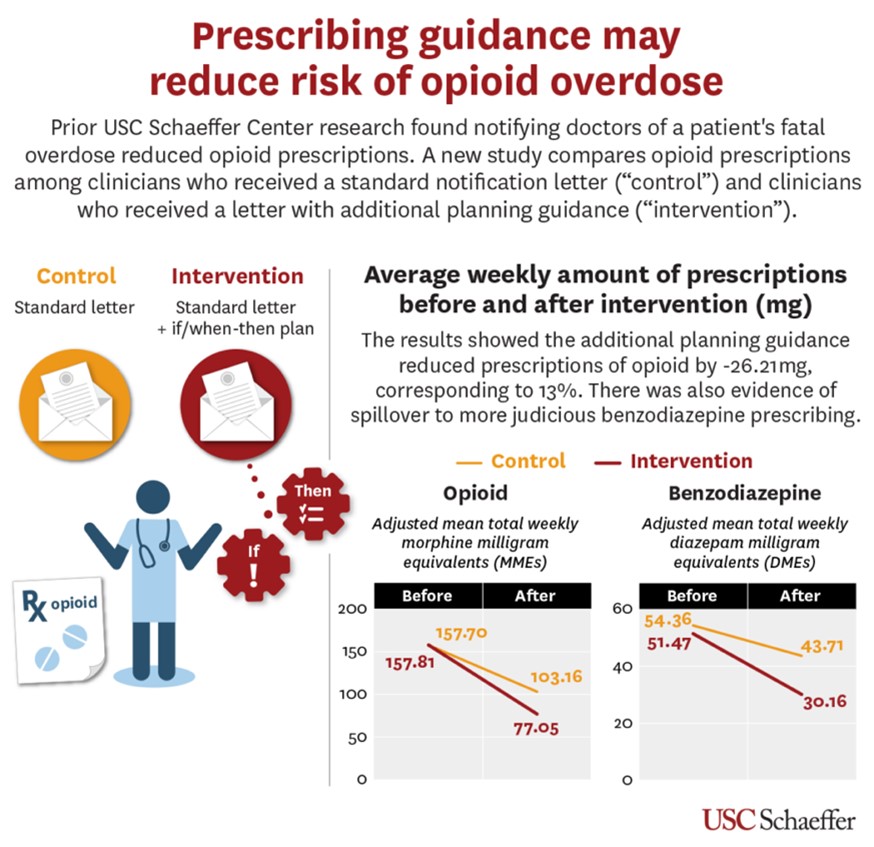
The study builds on two previous ones conducted by Doctor and his colleagues. The first one found that physicians reduced opioid prescriptions by 10% in the three months following notification of a fatal overdose. A second study found that physicians reduced opioid prescriptions by 7% one year after receiving notification. The letter used in these previous studies served as the control in this study.
“This latest study is part of an evolution toward better understanding how to enact behavior change among physicians whose patients have suffered negative consequences from care by the medical community,” said Doctor, who is also chair of the Department of Health Policy and Management at the USC Sol Price School of Public Policy.
The latest randomized study involved sending letters to 541 clinicians in Los Angeles County: 284 received a standard letter notifying them that a patient had died of an overdose; 257 received a letter with the additional guidance.
Executive Summary

Chapter 1: Start Planning
Planning for the success of your project is a critically important step to fully leverage the benefits of the BS process, and this manual will guide you through some initial stages of the process. You’ll learn about how the BS approach can be applied to virtually all of the human-centered challenges in your organization. In this section, you’ll gain a better understanding of how to create a repeatable BS process in your organization.
This section will provide guidance on key success factors, such as identifying risks and being flexible. You’ll also get some practical examples around major milestones, typical timreframes, and establishing a timeline for your project. Considerations will also include alignment with other parts of your organization’s eco-system (e.g., budgeting, strategic planning, information technology enhancements, R&D cycles, etc.). This section will equip you with the necessary foundation to initiate a successful program!

Chapter 2: Process Leader
As the owner of the BS process, the BSPL has a critical role to play and will assume multiple responsibilities. They will be the BS subject matter expert, project leader, facilitator, resource coordinator, research crusader, and advocate for the process. The work of each of these roles and their responsibilities will be highlighted.
This chapter will include a discussion of the knowledge and skills needed for success as a BS PL. Additional considerations, such as leveraging a co-leader and sharing responsibility with the business area for outcomes and results, will also be covered.

Chapter 3: Define Problem
In the BS process, the project leader is responsible for defining the problem. While the problem may seem straightforward, it is rarely as simple as it looks. As the project leader, you’ll need to gain a fairly thorough understanding of the problem, context, history, current results, user experience, and the business’ perspectives on what is not working as expected. At this stage in the process, data will be broadly defined to include not only traditional types of numeric data such as revenue, sales projections, call volume, or statistical analyses, but also more anecdotal data such as stakeholder beliefs about what is needed, what is working, and what isn’t working. There will be opportunities later in the process to test these assumptions, but at this point, it’s critically important to get these perceptions on the table.
In this section, you’ll be introduced to tools to help with the problem definition process as well as a framework for writing a problem statement. In addition, you’ll have access to examples of problem statements and have a chance to try out the process of writing a problem statement of your own.

Chapter 4: Identify Stakeholders
The Behavioral Science process and methodology work best in a collaborative manner. This chapter will dive into explaining why others are needed to make the process work effectively, how to identify the appropriate stakeholders, and determining the ideal set of roles needed for the project. Since every organization and every BS project are different, you’ll learn how to put the right team together for each project.
In this process, there is room for stakeholders to have different levels of involvement in different phases. This section outlines different roles and options to meet the needs of the stakeholders and process. This section will review best practices such as how to assemble the best teams, plan for the appropriate team size, and match stakeholders to specific parts of the project.

Chapter 5: Current Evidence
Collecting data for evidence-based decision making is a fundamental part of the BS process. As the BS project leader, you will informally collect some readily available data to develop the Problem Statement. You’ll learn about best practices for collecting and tracking this data.
However, at this point in the process, you will need to get serious about collecting data around important questions that remain unanswered. This section will assist you in starting to record crucial questions that require data-driven answers. For example, it is highly likely that you will need to collect some specific user experience data (if it doesn’t already exist).

Chapter 6: Attitudes Matter
While quantitative data is vital to helping us understand our business challenges, in the realm of BS, understanding “softer” data (e.g., people’s thoughts, emotions, attitudes, and reactions) is a primary focus. These are places we can influence desired behavior with BS tactics.
This section will discuss the importance of deeply understanding your customers and employees. This section will cover some of the primary methods of data collection and analysis. This section will also introduce you to some best practices and standardized methods for recruiting customers and employees to participate in your research studies.

Chapter 7: Research Agenda
As you begin your project, you’ll identify many important questions you and your team want to know in order to effectively diagnose your challenge. In most cases, you’ll have more questions than you can practically collect data for. This section will help you prioritize those questions so you can begin to develop a research agenda (i.e., a plan and schedule for research efforts). This is included in the planning phase of the projects, so you can launch these studies to have data available for later steps in the process.
This chapter will also help you learn to identify the appropriate target audience for the research (i.e., your sample). We will review research concepts like oversampling, representative samples, and randomization to provide you with the necessary information to collaborate with the data scientists and researchers involved in your project.

Chapter 8: Collect Insights
In this section, you’ll learn about the various tools for collecting insights (e.g., focus groups, interviews, and observations). These methods are outlined in detail, including the pros, cons, and best practices, in order to support your ability to start collecting insights from your target audience.
You’ll also be guided through the specific steps and tips needed to help you systematically and objectively better understand your customers and employees.

Chapter 9: Analyze Insights
This manual will focus on one of the most important data collection tools: the survey. We will cover best practices, risks, and recommendations for overcoming survey problems, such as survey fatigue and response bias. You’ll also be introduced to important concepts, such as pilot testing, prior to launching a large-scale survey.
The second part of this manual will cover analyzing the data collected. Depending on the type of analysis needed and the resources available in your organization, you may need to coordinate some of the data collection with other groups. You’ll be introduced to some best practices for this type of collaboration. Finally, the section will wrap up with recommendations for presenting and communicating the results of the data in a compelling and informative way.

Chapter 10: Engage Stakeholders
A large part of the project leader’s role is to create conditions and an environment where the project team and stakeholders will thrive. Your stakeholders are busy people with competing perspectives, interests, and agendas. Your ability to garner their support will be critical to the project. Fortunately, many of the BS principles can help influence strong engagement from the players involved.
The section will include strategies to influence stakeholders, considerations for diversity and inclusion, and how to deal with situations such as conflict and stakeholders exiting and entering projects. While this step is primarily about engaging stakeholders and garnering support, it is also a great opportunity to collect information from stakeholders, and understand their interests, motivations, and agendas.

Chapter 11: Selling Science
As a new process in your organization, you’ll need to lay the groundwork for introducing the BS concept, process, and approach to your stakeholders. Given the size and scope of the BS field, explaining it to your stakeholders will not be easy. For example, some of your stakeholders will want to know about the business case and hear about proven results from other companies. Others will be interested in the data and experimentation aspects. Still, others will want to hear about the innovative solutions. In addition, just like any new process, you’ll encounter some skeptics and resistance to change. This section will provide ideas and recommendations for handling objections. This section will walk you through suggestions for talking about BS in a way that is compelling, will pique their interest, and will garner their interest.

Chapter 12: Next Steps
The last section in the module helps to bring the planning phase into focus by stepping back and looking at each of the pieces as a whole. We will briefly review each of the module’s covered areas and include a list of follow-up items to complete before the next session. The session will also help participants identify a great project to start with if they haven’t already done so.
At this point in the process, the BSPLs may find themselves subject to a couple of BS principles (fight-flight and overconfidence). These principles provide an excellent opportunity to demonstrate BS in real time with real examples. Finally, recommendations are offered to maintain a mindset of resilience and flexibility as the process proceeds.
Curriculum
Behavioral Science – Workshop 1 – Successful Planning
- Start Planning
- Process Leader
- Define Problem
- Identify Stakeholders
- Current Evidence
- Attitudes Matter
- Research Agenda
- Collect Insights
- Analyze Insights
- Engage Stakeholders
- Selling Science
- Next Steps
Distance Learning
Introduction
Welcome to Appleton Greene and thank you for enrolling on the Behavioral Science corporate training program. You will be learning through our unique facilitation via distance-learning method, which will enable you to practically implement everything that you learn academically. The methods and materials used in your program have been designed and developed to ensure that you derive the maximum benefits and enjoyment possible. We hope that you find the program challenging and fun to do. However, if you have never been a distance-learner before, you may be experiencing some trepidation at the task before you. So we will get you started by giving you some basic information and guidance on how you can make the best use of the modules, how you should manage the materials and what you should be doing as you work through them. This guide is designed to point you in the right direction and help you to become an effective distance-learner. Take a few hours or so to study this guide and your guide to tutorial support for students, while making notes, before you start to study in earnest.
Study environment
You will need to locate a quiet and private place to study, preferably a room where you can easily be isolated from external disturbances or distractions. Make sure the room is well-lit and incorporates a relaxed, pleasant feel. If you can spoil yourself within your study environment, you will have much more of a chance to ensure that you are always in the right frame of mind when you do devote time to study. For example, a nice fire, the ability to play soft soothing background music, soft but effective lighting, perhaps a nice view if possible and a good size desk with a comfortable chair. Make sure that your family know when you are studying and understand your study rules. Your study environment is very important. The ideal situation, if at all possible, is to have a separate study, which can be devoted to you. If this is not possible then you will need to pay a lot more attention to developing and managing your study schedule, because it will affect other people as well as yourself. The better your study environment, the more productive you will be.
Study tools & rules
Try and make sure that your study tools are sufficient and in good working order. You will need to have access to a computer, scanner and printer, with access to the internet. You will need a very comfortable chair, which supports your lower back, and you will need a good filing system. It can be very frustrating if you are spending valuable study time trying to fix study tools that are unreliable, or unsuitable for the task. Make sure that your study tools are up to date. You will also need to consider some study rules. Some of these rules will apply to you and will be intended to help you to be more disciplined about when and how you study. This distance-learning guide will help you and after you have read it you can put some thought into what your study rules should be. You will also need to negotiate some study rules for your family, friends or anyone who lives with you. They too will need to be disciplined in order to ensure that they can support you while you study. It is important to ensure that your family and friends are an integral part of your study team. Having their support and encouragement can prove to be a crucial contribution to your successful completion of the program. Involve them in as much as you can.
Successful distance-learning
Distance-learners are freed from the necessity of attending regular classes or workshops, since they can study in their own way, at their own pace and for their own purposes. But unlike traditional internal training courses, it is the student’s responsibility, with a distance-learning program, to ensure that they manage their own study contribution. This requires strong self-discipline and self-motivation skills and there must be a clear will to succeed. Those students who are used to managing themselves, are good at managing others and who enjoy working in isolation, are more likely to be good distance-learners. It is also important to be aware of the main reasons why you are studying and of the main objectives that you are hoping to achieve as a result. You will need to remind yourself of these objectives at times when you need to motivate yourself. Never lose sight of your long-term goals and your short-term objectives. There is nobody available here to pamper you, or to look after you, or to spoon-feed you with information, so you will need to find ways to encourage and appreciate yourself while you are studying. Make sure that you chart your study progress, so that you can be sure of your achievements and re-evaluate your goals and objectives regularly.
Self-assessment
Appleton Greene training programs are in all cases post-graduate programs. Consequently, you should already have obtained a business-related degree and be an experienced learner. You should therefore already be aware of your study strengths and weaknesses. For example, which time of the day are you at your most productive? Are you a lark or an owl? What study methods do you respond to the most? Are you a consistent learner? How do you discipline yourself? How do you ensure that you enjoy yourself while studying? It is important to understand yourself as a learner and so some self-assessment early on will be necessary if you are to apply yourself correctly. Perform a SWOT analysis on yourself as a student. List your internal strengths and weaknesses as a student and your external opportunities and threats. This will help you later on when you are creating a study plan. You can then incorporate features within your study plan that can ensure that you are playing to your strengths, while compensating for your weaknesses. You can also ensure that you make the most of your opportunities, while avoiding the potential threats to your success.
Accepting responsibility as a student
Training programs invariably require a significant investment, both in terms of what they cost and in the time that you need to contribute to study and the responsibility for successful completion of training programs rests entirely with the student. This is never more apparent than when a student is learning via distance-learning. Accepting responsibility as a student is an important step towards ensuring that you can successfully complete your training program. It is easy to instantly blame other people or factors when things go wrong. But the fact of the matter is that if a failure is your failure, then you have the power to do something about it, it is entirely in your own hands. If it is always someone else’s failure, then you are powerless to do anything about it. All students study in entirely different ways, this is because we are all individuals and what is right for one student, is not necessarily right for another. In order to succeed, you will have to accept personal responsibility for finding a way to plan, implement and manage a personal study plan that works for you. If you do not succeed, you only have yourself to blame.
Planning
By far the most critical contribution to stress, is the feeling of not being in control. In the absence of planning we tend to be reactive and can stumble from pillar to post in the hope that things will turn out fine in the end. Invariably they don’t! In order to be in control, we need to have firm ideas about how and when we want to do things. We also need to consider as many possible eventualities as we can, so that we are prepared for them when they happen. Prescriptive Change, is far easier to manage and control, than Emergent Change. The same is true with distance-learning. It is much easier and much more enjoyable, if you feel that you are in control and that things are going to plan. Even when things do go wrong, you are prepared for them and can act accordingly without any unnecessary stress. It is important therefore that you do take time to plan your studies properly.
Management
Once you have developed a clear study plan, it is of equal importance to ensure that you manage the implementation of it. Most of us usually enjoy planning, but it is usually during implementation when things go wrong. Targets are not met and we do not understand why. Sometimes we do not even know if targets are being met. It is not enough for us to conclude that the study plan just failed. If it is failing, you will need to understand what you can do about it. Similarly if your study plan is succeeding, it is still important to understand why, so that you can improve upon your success. You therefore need to have guidelines for self-assessment so that you can be consistent with performance improvement throughout the program. If you manage things correctly, then your performance should constantly improve throughout the program.
Study objectives & tasks
The first place to start is developing your program objectives. These should feature your reasons for undertaking the training program in order of priority. Keep them succinct and to the point in order to avoid confusion. Do not just write the first things that come into your head because they are likely to be too similar to each other. Make a list of possible departmental headings, such as: Customer Service; E-business; Finance; Globalization; Human Resources; Technology; Legal; Management; Marketing and Production. Then brainstorm for ideas by listing as many things that you want to achieve under each heading and later re-arrange these things in order of priority. Finally, select the top item from each department heading and choose these as your program objectives. Try and restrict yourself to five because it will enable you to focus clearly. It is likely that the other things that you listed will be achieved if each of the top objectives are achieved. If this does not prove to be the case, then simply work through the process again.
Study forecast
As a guide, the Appleton Greene Behavioral Science corporate training program should take 12-18 months to complete, depending upon your availability and current commitments. The reason why there is such a variance in time estimates is because every student is an individual, with differing productivity levels and different commitments. These differentiations are then exaggerated by the fact that this is a distance-learning program, which incorporates the practical integration of academic theory as an as a part of the training program. Consequently all of the project studies are real, which means that important decisions and compromises need to be made. You will want to get things right and will need to be patient with your expectations in order to ensure that they are. We would always recommend that you are prudent with your own task and time forecasts, but you still need to develop them and have a clear indication of what are realistic expectations in your case. With reference to your time planning: consider the time that you can realistically dedicate towards study with the program every week; calculate how long it should take you to complete the program, using the guidelines featured here; then break the program down into logical modules and allocate a suitable proportion of time to each of them, these will be your milestones; you can create a time plan by using a spreadsheet on your computer, or a personal organizer such as MS Outlook, you could also use a financial forecasting software; break your time forecasts down into manageable chunks of time, the more specific you can be, the more productive and accurate your time management will be; finally, use formulas where possible to do your time calculations for you, because this will help later on when your forecasts need to change in line with actual performance. With reference to your task planning: refer to your list of tasks that need to be undertaken in order to achieve your program objectives; with reference to your time plan, calculate when each task should be implemented; remember that you are not estimating when your objectives will be achieved, but when you will need to focus upon implementing the corresponding tasks; you also need to ensure that each task is implemented in conjunction with the associated training modules which are relevant; then break each single task down into a list of specific to do’s, say approximately ten to do’s for each task and enter these into your study plan; once again you could use MS Outlook to incorporate both your time and task planning and this could constitute your study plan; you could also use a project management software like MS Project. You should now have a clear and realistic forecast detailing when you can expect to be able to do something about undertaking the tasks to achieve your program objectives.
Performance management
It is one thing to develop your study forecast, it is quite another to monitor your progress. Ultimately it is less important whether you achieve your original study forecast and more important that you update it so that it constantly remains realistic in line with your performance. As you begin to work through the program, you will begin to have more of an idea about your own personal performance and productivity levels as a distance-learner. Once you have completed your first study module, you should re-evaluate your study forecast for both time and tasks, so that they reflect your actual performance level achieved. In order to achieve this you must first time yourself while training by using an alarm clock. Set the alarm for hourly intervals and make a note of how far you have come within that time. You can then make a note of your actual performance on your study plan and then compare your performance against your forecast. Then consider the reasons that have contributed towards your performance level, whether they are positive or negative and make a considered adjustment to your future forecasts as a result. Given time, you should start achieving your forecasts regularly.
With reference to time management: time yourself while you are studying and make a note of the actual time taken in your study plan; consider your successes with time-efficiency and the reasons for the success in each case and take this into consideration when reviewing future time planning; consider your failures with time-efficiency and the reasons for the failures in each case and take this into consideration when reviewing future time planning; re-evaluate your study forecast in relation to time planning for the remainder of your training program to ensure that you continue to be realistic about your time expectations. You need to be consistent with your time management, otherwise you will never complete your studies. This will either be because you are not contributing enough time to your studies, or you will become less efficient with the time that you do allocate to your studies. Remember, if you are not in control of your studies, they can just become yet another cause of stress for you.
With reference to your task management: time yourself while you are studying and make a note of the actual tasks that you have undertaken in your study plan; consider your successes with task-efficiency and the reasons for the success in each case; take this into consideration when reviewing future task planning; consider your failures with task-efficiency and the reasons for the failures in each case and take this into consideration when reviewing future task planning; re-evaluate your study forecast in relation to task planning for the remainder of your training program to ensure that you continue to be realistic about your task expectations. You need to be consistent with your task management, otherwise you will never know whether you are achieving your program objectives or not.
Keeping in touch
You will have access to qualified and experienced professors and tutors who are responsible for providing tutorial support for your particular training program. So don’t be shy about letting them know how you are getting on. We keep electronic records of all tutorial support emails so that professors and tutors can review previous correspondence before considering an individual response. It also means that there is a record of all communications between you and your professors and tutors and this helps to avoid any unnecessary duplication, misunderstanding, or misinterpretation. If you have a problem relating to the program, share it with them via email. It is likely that they have come across the same problem before and are usually able to make helpful suggestions and steer you in the right direction. To learn more about when and how to use tutorial support, please refer to the Tutorial Support section of this student information guide. This will help you to ensure that you are making the most of tutorial support that is available to you and will ultimately contribute towards your success and enjoyment with your training program.
Work colleagues and family
You should certainly discuss your program study progress with your colleagues, friends and your family. Appleton Greene training programs are very practical. They require you to seek information from other people, to plan, develop and implement processes with other people and to achieve feedback from other people in relation to viability and productivity. You will therefore have plenty of opportunities to test your ideas and enlist the views of others. People tend to be sympathetic towards distance-learners, so don’t bottle it all up in yourself. Get out there and share it! It is also likely that your family and colleagues are going to benefit from your labors with the program, so they are likely to be much more interested in being involved than you might think. Be bold about delegating work to those who might benefit themselves. This is a great way to achieve understanding and commitment from people who you may later rely upon for process implementation. Share your experiences with your friends and family.
Making it relevant
The key to successful learning is to make it relevant to your own individual circumstances. At all times you should be trying to make bridges between the content of the program and your own situation. Whether you achieve this through quiet reflection or through interactive discussion with your colleagues, client partners or your family, remember that it is the most important and rewarding aspect of translating your studies into real self-improvement. You should be clear about how you want the program to benefit you. This involves setting clear study objectives in relation to the content of the course in terms of understanding, concepts, completing research or reviewing activities and relating the content of the modules to your own situation. Your objectives may understandably change as you work through the program, in which case you should enter the revised objectives on your study plan so that you have a permanent reminder of what you are trying to achieve, when and why.
Distance-learning check-list
Prepare your study environment, your study tools and rules.
Undertake detailed self-assessment in terms of your ability as a learner.
Create a format for your study plan.
Consider your study objectives and tasks.
Create a study forecast.
Assess your study performance.
Re-evaluate your study forecast.
Be consistent when managing your study plan.
Use your Appleton Greene Certified Learning Provider (CLP) for tutorial support.
Make sure you keep in touch with those around you.

Tutorial Support
Programs
Appleton Greene uses standard and bespoke corporate training programs as vessels to transfer business process improvement knowledge into the heart of our clients’ organizations. Each individual program focuses upon the implementation of a specific business process, which enables clients to easily quantify their return on investment. There are hundreds of established Appleton Greene corporate training products now available to clients within customer services, e-business, finance, globalization, human resources, information technology, legal, management, marketing and production. It does not matter whether a client’s employees are located within one office, or an unlimited number of international offices, we can still bring them together to learn and implement specific business processes collectively. Our approach to global localization enables us to provide clients with a truly international service with that all important personal touch. Appleton Greene corporate training programs can be provided virtually or locally and they are all unique in that they individually focus upon a specific business function. They are implemented over a sustainable period of time and professional support is consistently provided by qualified learning providers and specialist consultants.
Support available
You will have a designated Certified Learning Provider (CLP) and an Accredited Consultant and we encourage you to communicate with them as much as possible. In all cases tutorial support is provided online because we can then keep a record of all communications to ensure that tutorial support remains consistent. You would also be forwarding your work to the tutorial support unit for evaluation and assessment. You will receive individual feedback on all of the work that you undertake on a one-to-one basis, together with specific recommendations for anything that may need to be changed in order to achieve a pass with merit or a pass with distinction and you then have as many opportunities as you may need to re-submit project studies until they meet with the required standard. Consequently the only reason that you should really fail (CLP) is if you do not do the work. It makes no difference to us whether a student takes 12 months or 18 months to complete the program, what matters is that in all cases the same quality standard will have been achieved.
Support Process
Please forward all of your future emails to the designated (CLP) Tutorial Support Unit email address that has been provided and please do not duplicate or copy your emails to other AGC email accounts as this will just cause unnecessary administration. Please note that emails are always answered as quickly as possible but you will need to allow a period of up to 20 business days for responses to general tutorial support emails during busy periods, because emails are answered strictly within the order in which they are received. You will also need to allow a period of up to 30 business days for the evaluation and assessment of project studies. This does not include weekends or public holidays. Please therefore kindly allow for this within your time planning. All communications are managed online via email because it enables tutorial service support managers to review other communications which have been received before responding and it ensures that there is a copy of all communications retained on file for future reference. All communications will be stored within your personal (CLP) study file here at Appleton Greene throughout your designated study period. If you need any assistance or clarification at any time, please do not hesitate to contact us by forwarding an email and remember that we are here to help. If you have any questions, please list and number your questions succinctly and you can then be sure of receiving specific answers to each and every query.
Time Management
It takes approximately 1 Year to complete the Behavioral Science corporate training program, incorporating 12 x 6-hour monthly workshops. Each student will also need to contribute approximately 4 hours per week over 1 Year of their personal time. Students can study from home or work at their own pace and are responsible for managing their own study plan. There are no formal examinations and students are evaluated and assessed based upon their project study submissions, together with the quality of their internal analysis and supporting documents. They can contribute more time towards study when they have the time to do so and can contribute less time when they are busy. All students tend to be in full time employment while studying and the Behavioral Science program is purposely designed to accommodate this, so there is plenty of flexibility in terms of time management. It makes no difference to us at Appleton Greene, whether individuals take 12-18 months to complete this program. What matters is that in all cases the same standard of quality will have been achieved with the standard and bespoke programs that have been developed.
Distance Learning Guide
The distance learning guide should be your first port of call when starting your training program. It will help you when you are planning how and when to study, how to create the right environment and how to establish the right frame of mind. If you can lay the foundations properly during the planning stage, then it will contribute to your enjoyment and productivity while training later. The guide helps to change your lifestyle in order to accommodate time for study and to cultivate good study habits. It helps you to chart your progress so that you can measure your performance and achieve your goals. It explains the tools that you will need for study and how to make them work. It also explains how to translate academic theory into practical reality. Spend some time now working through your distance learning guide and make sure that you have firm foundations in place so that you can make the most of your distance learning program. There is no requirement for you to attend training workshops or classes at Appleton Greene offices. The entire program is undertaken online, program course manuals and project studies are administered via the Appleton Greene web site and via email, so you are able to study at your own pace and in the comfort of your own home or office as long as you have a computer and access to the internet.
How To Study
The how to study guide provides students with a clear understanding of the Appleton Greene facilitation via distance learning training methods and enables students to obtain a clear overview of the training program content. It enables students to understand the step-by-step training methods used by Appleton Greene and how course manuals are integrated with project studies. It explains the research and development that is required and the need to provide evidence and references to support your statements. It also enables students to understand precisely what will be required of them in order to achieve a pass with merit and a pass with distinction for individual project studies and provides useful guidance on how to be innovative and creative when developing your Unique Program Proposition (UPP).
Tutorial Support
Tutorial support for the Appleton Greene Behavioral Science corporate training program is provided online either through the Appleton Greene Client Support Portal (CSP), or via email. All tutorial support requests are facilitated by a designated Program Administration Manager (PAM). They are responsible for deciding which professor or tutor is the most appropriate option relating to the support required and then the tutorial support request is forwarded onto them. Once the professor or tutor has completed the tutorial support request and answered any questions that have been asked, this communication is then returned to the student via email by the designated Program Administration Manager (PAM). This enables all tutorial support, between students, professors and tutors, to be facilitated by the designated Program Administration Manager (PAM) efficiently and securely through the email account. You will therefore need to allow a period of up to 20 business days for responses to general support queries and up to 30 business days for the evaluation and assessment of project studies, because all tutorial support requests are answered strictly within the order in which they are received. This does not include weekends or public holidays. Consequently you need to put some thought into the management of your tutorial support procedure in order to ensure that your study plan is feasible and to obtain the maximum possible benefit from tutorial support during your period of study. Please retain copies of your tutorial support emails for future reference. Please ensure that ALL of your tutorial support emails are set out using the format as suggested within your guide to tutorial support. Your tutorial support emails need to be referenced clearly to the specific part of the course manual or project study which you are working on at any given time. You also need to list and number any questions that you would like to ask, up to a maximum of five questions within each tutorial support email. Remember the more specific you can be with your questions the more specific your answers will be too and this will help you to avoid any unnecessary misunderstanding, misinterpretation, or duplication. The guide to tutorial support is intended to help you to understand how and when to use support in order to ensure that you get the most out of your training program. Appleton Greene training programs are designed to enable you to do things for yourself. They provide you with a structure or a framework and we use tutorial support to facilitate students while they practically implement what they learn. In other words, we are enabling students to do things for themselves. The benefits of distance learning via facilitation are considerable and are much more sustainable in the long-term than traditional short-term knowledge sharing programs. Consequently you should learn how and when to use tutorial support so that you can maximize the benefits from your learning experience with Appleton Greene. This guide describes the purpose of each training function and how to use them and how to use tutorial support in relation to each aspect of the training program. It also provides useful tips and guidance with regard to best practice.
Tutorial Support Tips
Students are often unsure about how and when to use tutorial support with Appleton Greene. This Tip List will help you to understand more about how to achieve the most from using tutorial support. Refer to it regularly to ensure that you are continuing to use the service properly. Tutorial support is critical to the success of your training experience, but it is important to understand when and how to use it in order to maximize the benefit that you receive. It is no coincidence that those students who succeed are those that learn how to be positive, proactive and productive when using tutorial support.
Be positive and friendly with your tutorial support emails
Remember that if you forward an email to the tutorial support unit, you are dealing with real people. “Do unto others as you would expect others to do unto you”. If you are positive, complimentary and generally friendly in your emails, you will generate a similar response in return. This will be more enjoyable, productive and rewarding for you in the long-term.
Think about the impression that you want to create
Every time that you communicate, you create an impression, which can be either positive or negative, so put some thought into the impression that you want to create. Remember that copies of all tutorial support emails are stored electronically and tutors will always refer to prior correspondence before responding to any current emails. Over a period of time, a general opinion will be arrived at in relation to your character, attitude and ability. Try to manage your own frustrations, mood swings and temperament professionally, without involving the tutorial support team. Demonstrating frustration or a lack of patience is a weakness and will be interpreted as such. The good thing about communicating in writing, is that you will have the time to consider your content carefully, you can review it and proof-read it before sending your email to Appleton Greene and this should help you to communicate more professionally, consistently and to avoid any unnecessary knee-jerk reactions to individual situations as and when they may arise. Please also remember that the CLP Tutorial Support Unit will not just be responsible for evaluating and assessing the quality of your work, they will also be responsible for providing recommendations to other learning providers and to client contacts within the Appleton Greene global client network, so do be in control of your own emotions and try to create a good impression.
Remember that quality is preferred to quantity
Please remember that when you send an email to the tutorial support team, you are not using Twitter or Text Messaging. Try not to forward an email every time that you have a thought. This will not prove to be productive either for you or for the tutorial support team. Take time to prepare your communications properly, as if you were writing a professional letter to a business colleague and make a list of queries that you are likely to have and then incorporate them within one email, say once every month, so that the tutorial support team can understand more about context, application and your methodology for study. Get yourself into a consistent routine with your tutorial support requests and use the tutorial support template provided with ALL of your emails. The (CLP) Tutorial Support Unit will not spoon-feed you with information. They need to be able to evaluate and assess your tutorial support requests carefully and professionally.
Be specific about your questions in order to receive specific answers
Try not to write essays by thinking as you are writing tutorial support emails. The tutorial support unit can be unclear about what in fact you are asking, or what you are looking to achieve. Be specific about asking questions that you want answers to. Number your questions. You will then receive specific answers to each and every question. This is the main purpose of tutorial support via email.
Keep a record of your tutorial support emails
It is important that you keep a record of all tutorial support emails that are forwarded to you. You can then refer to them when necessary and it avoids any unnecessary duplication, misunderstanding, or misinterpretation.
Individual training workshops or telephone support
Please be advised that Appleton Greene does not provide separate or individual tutorial support meetings, workshops, or provide telephone support for individual students. Appleton Greene is an equal opportunities learning and service provider and we are therefore understandably bound to treat all students equally. We cannot therefore broker special financial or study arrangements with individual students regardless of the circumstances. All tutorial support is provided online and this enables Appleton Greene to keep a record of all communications between students, professors and tutors on file for future reference, in accordance with our quality management procedure and your terms and conditions of enrolment. All tutorial support is provided online via email because it enables us to have time to consider support content carefully, it ensures that you receive a considered and detailed response to your queries. You can number questions that you would like to ask, which relate to things that you do not understand or where clarification may be required. You can then be sure of receiving specific answers to each individual query. You will also then have a record of these communications and of all tutorial support, which has been provided to you. This makes tutorial support administration more productive by avoiding any unnecessary duplication, misunderstanding, or misinterpretation.
Tutorial Support Email Format
You should use this tutorial support format if you need to request clarification or assistance while studying with your training program. Please note that ALL of your tutorial support request emails should use the same format. You should therefore set up a standard email template, which you can then use as and when you need to. Emails that are forwarded to Appleton Greene, which do not use the following format, may be rejected and returned to you by the (CLP) Program Administration Manager. A detailed response will then be forwarded to you via email usually within 20 business days of receipt for general support queries and 30 business days for the evaluation and assessment of project studies. This does not include weekends or public holidays. Your tutorial support request, together with the corresponding TSU reply, will then be saved and stored within your electronic TSU file at Appleton Greene for future reference.
Subject line of your email
Please insert: Appleton Greene (CLP) Tutorial Support Request: (Your Full Name) (Date), within the subject line of your email.
Main body of your email
Please insert:
1. Appleton Greene Certified Learning Provider (CLP) Tutorial Support Request
2. Your Full Name
3. Date of TS request
4. Preferred email address
5. Backup email address
6. Course manual page name or number (reference)
7. Project study page name or number (reference)
Subject of enquiry
Please insert a maximum of 50 words (please be succinct)
Briefly outline the subject matter of your inquiry, or what your questions relate to.
Question 1
Maximum of 50 words (please be succinct)
Maximum of 50 words (please be succinct)
Question 3
Maximum of 50 words (please be succinct)
Question 4
Maximum of 50 words (please be succinct)
Question 5
Maximum of 50 words (please be succinct)
Please note that a maximum of 5 questions is permitted with each individual tutorial support request email.
Procedure
* List the questions that you want to ask first, then re-arrange them in order of priority. Make sure that you reference them, where necessary, to the course manuals or project studies.
* Make sure that you are specific about your questions and number them. Try to plan the content within your emails to make sure that it is relevant.
* Make sure that your tutorial support emails are set out correctly, using the Tutorial Support Email Format provided here.
* Save a copy of your email and incorporate the date sent after the subject title. Keep your tutorial support emails within the same file and in date order for easy reference.
* Allow up to 20 business days for a response to general tutorial support emails and up to 30 business days for the evaluation and assessment of project studies, because detailed individual responses will be made in all cases and tutorial support emails are answered strictly within the order in which they are received.
* Emails can and do get lost. So if you have not received a reply within the appropriate time, forward another copy or a reminder to the tutorial support unit to be sure that it has been received but do not forward reminders unless the appropriate time has elapsed.
* When you receive a reply, save it immediately featuring the date of receipt after the subject heading for easy reference. In most cases the tutorial support unit replies to your questions individually, so you will have a record of the questions that you asked as well as the answers offered. With project studies however, separate emails are usually forwarded by the tutorial support unit, so do keep a record of your own original emails as well.
* Remember to be positive and friendly in your emails. You are dealing with real people who will respond to the same things that you respond to.
* Try not to repeat questions that have already been asked in previous emails. If this happens the tutorial support unit will probably just refer you to the appropriate answers that have already been provided within previous emails.
* If you lose your tutorial support email records you can write to Appleton Greene to receive a copy of your tutorial support file, but a separate administration charge may be levied for this service.

How To Study
Your Certified Learning Provider (CLP) and Accredited Consultant can help you to plan a task list for getting started so that you can be clear about your direction and your priorities in relation to your training program. It is also a good way to introduce yourself to the tutorial support team.
Planning your study environment
Your study conditions are of great importance and will have a direct effect on how much you enjoy your training program. Consider how much space you will have, whether it is comfortable and private and whether you are likely to be disturbed. The study tools and facilities at your disposal are also important to the success of your distance-learning experience. Your tutorial support unit can help with useful tips and guidance, regardless of your starting position. It is important to get this right before you start working on your training program.
Planning your program objectives
It is important that you have a clear list of study objectives, in order of priority, before you start working on your training program. Your tutorial support unit can offer assistance here to ensure that your study objectives have been afforded due consideration and priority.
Planning how and when to study
Distance-learners are freed from the necessity of attending regular classes, since they can study in their own way, at their own pace and for their own purposes. This approach is designed to let you study efficiently away from the traditional classroom environment. It is important however, that you plan how and when to study, so that you are making the most of your natural attributes, strengths and opportunities. Your tutorial support unit can offer assistance and useful tips to ensure that you are playing to your strengths.
Planning your study tasks
You should have a clear understanding of the study tasks that you should be undertaking and the priority associated with each task. These tasks should also be integrated with your program objectives. The distance learning guide and the guide to tutorial support for students should help you here, but if you need any clarification or assistance, please contact your tutorial support unit.
Planning your time
You will need to allocate specific times during your calendar when you intend to study if you are to have a realistic chance of completing your program on time. You are responsible for planning and managing your own study time, so it is important that you are successful with this. Your tutorial support unit can help you with this if your time plan is not working.
Keeping in touch
Consistency is the key here. If you communicate too frequently in short bursts, or too infrequently with no pattern, then your management ability with your studies will be questioned, both by you and by your tutorial support unit. It is obvious when a student is in control and when one is not and this will depend how able you are at sticking with your study plan. Inconsistency invariably leads to in-completion.
Charting your progress
Your tutorial support team can help you to chart your own study progress. Refer to your distance learning guide for further details.
Making it work
To succeed, all that you will need to do is apply yourself to undertaking your training program and interpreting it correctly. Success or failure lies in your hands and your hands alone, so be sure that you have a strategy for making it work. Your Certified Learning Provider (CLP) and Accredited Consultant can guide you through the process of program planning, development and implementation.
Reading methods
Interpretation is often unique to the individual but it can be improved and even quantified by implementing consistent interpretation methods. Interpretation can be affected by outside interference such as family members, TV, or the Internet, or simply by other thoughts which are demanding priority in our minds. One thing that can improve our productivity is using recognized reading methods. This helps us to focus and to be more structured when reading information for reasons of importance, rather than relaxation.
Speed reading
When reading through course manuals for the first time, subconsciously set your reading speed to be just fast enough that you cannot dwell on individual words or tables. With practice, you should be able to read an A4 sheet of paper in one minute. You will not achieve much in the way of a detailed understanding, but your brain will retain a useful overview. This overview will be important later on and will enable you to keep individual issues in perspective with a more generic picture because speed reading appeals to the memory part of the brain. Do not worry about what you do or do not remember at this stage.
Content reading
Once you have speed read everything, you can then start work in earnest. You now need to read a particular section of your course manual thoroughly, by making detailed notes while you read. This process is called Content Reading and it will help to consolidate your understanding and interpretation of the information that has been provided.
Making structured notes on the course manuals
When you are content reading, you should be making detailed notes, which are both structured and informative. Make these notes in a MS Word document on your computer, because you can then amend and update these as and when you deem it to be necessary. List your notes under three headings: 1. Interpretation – 2. Questions – 3. Tasks. The purpose of the 1st section is to clarify your interpretation by writing it down. The purpose of the 2nd section is to list any questions that the issue raises for you. The purpose of the 3rd section is to list any tasks that you should undertake as a result. Anyone who has graduated with a business-related degree should already be familiar with this process.
Organizing structured notes separately
You should then transfer your notes to a separate study notebook, preferably one that enables easy referencing, such as a MS Word Document, a MS Excel Spreadsheet, a MS Access Database, or a personal organizer on your cell phone. Transferring your notes allows you to have the opportunity of cross-checking and verifying them, which assists considerably with understanding and interpretation. You will also find that the better you are at doing this, the more chance you will have of ensuring that you achieve your study objectives.
Question your understanding
Do challenge your understanding. Explain things to yourself in your own words by writing things down.
Clarifying your understanding
If you are at all unsure, forward an email to your tutorial support unit and they will help to clarify your understanding.
Question your interpretation
Do challenge your interpretation. Qualify your interpretation by writing it down.
Clarifying your interpretation
If you are at all unsure, forward an email to your tutorial support unit and they will help to clarify your interpretation.
Qualification Requirements
The student will need to successfully complete the project study and all of the exercises relating to the Behavioral Science corporate training program, achieving a pass with merit or distinction in each case, in order to qualify as an Accredited Behavioral Science Specialist (APTS). All monthly workshops need to be tried and tested within your company. These project studies can be completed in your own time and at your own pace and in the comfort of your own home or office. There are no formal examinations, assessment is based upon the successful completion of the project studies. They are called project studies because, unlike case studies, these projects are not theoretical, they incorporate real program processes that need to be properly researched and developed. The project studies assist us in measuring your understanding and interpretation of the training program and enable us to assess qualification merits. All of the project studies are based entirely upon the content within the training program and they enable you to integrate what you have learnt into your corporate training practice.
Behavioral Science – Grading Contribution
Project Study – Grading Contribution
Customer Service – 10%
E-business – 05%
Finance – 10%
Globalization – 10%
Human Resources – 10%
Information Technology – 10%
Legal – 05%
Management – 10%
Marketing – 10%
Production – 10%
Education – 05%
Logistics – 05%
TOTAL GRADING – 100%
Qualification grades
A mark of 90% = Pass with Distinction.
A mark of 75% = Pass with Merit.
A mark of less than 75% = Fail.
If you fail to achieve a mark of 75% with a project study, you will receive detailed feedback from the Certified Learning Provider (CLP) and/or Accredited Consultant, together with a list of tasks which you will need to complete, in order to ensure that your project study meets with the minimum quality standard that is required by Appleton Greene. You can then re-submit your project study for further evaluation and assessment. Indeed you can re-submit as many drafts of your project studies as you need to, until such a time as they eventually meet with the required standard by Appleton Greene, so you need not worry about this, it is all part of the learning process.
When marking project studies, Appleton Greene is looking for sufficient evidence of the following:
Pass with merit
A satisfactory level of program understanding
A satisfactory level of program interpretation
A satisfactory level of project study content presentation
A satisfactory level of Unique Program Proposition (UPP) quality
A satisfactory level of the practical integration of academic theory
Pass with distinction
An exceptional level of program understanding
An exceptional level of program interpretation
An exceptional level of project study content presentation
An exceptional level of Unique Program Proposition (UPP) quality
An exceptional level of the practical integration of academic theory
Preliminary Analysis
First, welcome to the fascinating world of Behavioral Science! You are really going to enjoy learning about the ways we operate as humans and how to influence the behavior of others.
Great news! No pre-work is required for this module! However, if you want to get ahead and do some preliminary analysis work, some ideas are provided below. Taking some of the steps below will give you a head start and may help you feel well prepared for your workshop.
Before you begin the BS program, it will be helpful to be familiar with your company’s existing processes for designing products, fixing problems, or working on continuous improvement efforts. As you know, the BS approach will be different from your company’s typical ways of working. Becoming more knowledgeable about the ways your organization identifies and defines problems, how they work to resolve those problems, and how to put solutions in place will help you better be able to see where there are gaps in the current process and how the BS approach can fill those gaps.
You may find that your company doesn’t have a formal process, or it may have different processes for different types of work (e.g., product design, continuous improvement, and software testing). There are some formal processes with related goals that may be relevant, such as design thinking, usability labs/testing, or Six Sigma. You may discover that different areas of your company have different processes. You may have some parts of the organization that do similar types of work as the BS process (e.g., change management, insights, continuous improvement, operational effectiveness, organizational design).
Investigating these approaches will allow you to become more intimately aware of the differences between your company’s processes and the BS process. This information will help you be able to articulate the value of the BS process and how it can help your stakeholders get different results.
One way to accomplish this would be to spend some time talking to people across your organization. You can ask them about what products they designed, processes they improved, problems they recently tried to solve, or obstacles they worked to overcome. Most people are willing to talk to you about their challenges. A secondary benefit of having these conversations is that you learn about any deficiencies in the current process. For example, you can ask about where they struggled in the process, what they wish would have been different, and whether they felt their process was effective. Again, all of this information can arm you with the ammunition you’ll need later to talk to people about the benefits of the BS approach and the differences between it and the current state.
Finally, during these conversations, you may identify the perfect challenge to bring to the BS process. You’ll need a good challenge to work through the process.
Here are some resources that can be helpful if you want to work ahead to become more familiar with the materials in this first module on Successful Planning.
Start Planning
Process Leader
Define Problem
Identify Stakeholders
Current Evidence
Attitude Matters
Research Agenda
Collect Insights
Analyze Insights
Engage Stakeholders
Selling Science
Synthesize Plans
Course Manuals 1-12

Course Manual 1: Start Planning
Introduction
Congratulations on beginning this exciting program!
The program is designed to help you set up a process in your organization to tackle and solve all kinds of organizational challenges using a Behavioral Science methodology. This approach will take you further than you’ve been able to go with other well-established problem-solving techniques because it leverages a powerful understanding of the mysteries of human behavior. In this program, you’ll learn about how as humans, our decisions and actions are impacted by our beliefs, desires, emotions, attention capacity, other people, and the external environment. And you’ll be able to harness that information to develop impactful solutions that address many of the difficult challenges your organization has been struggling with.
The BS process will allow you to understand challenges, formulate designs, and create solutions in new ways that are optimized to meet and exceed your desired business goals, and it’s backed by data and science. Plus, using this process will provide you with the reasons why your solutions are effective. Your company will be able to evolve from making well-intended assumptions to leading your company to results based on science and data. Just to give you an idea of the types of challenges you can tackle, a small number of examples of the various ways BS has been used are listed below.

Understanding Social Comparison: As humans, we like to find information that helps us to make decisions. In general, we trust other peoples’ opinions to provide us with that information. This is the case whether we know the other person or not. In general, the more with think the people are similar to us, the more likely we are to trust them. For example, consider the power of a 5-star review as we pick a vacation hotel or make an on-line purchase. Another example is the way we prefer someone who is referred by a friend for a job opening over a someone who applies on-line. All of the examples below demonstrate ways humans compare themselves to others, and in doing so, it influences their behavior.
These are all related to the principle of social comparison.
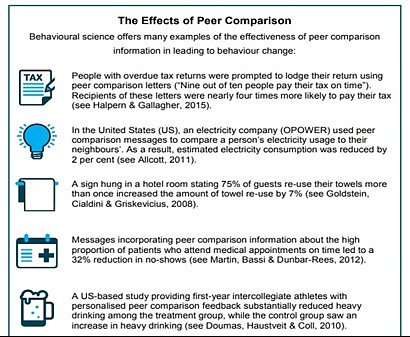
What Kind of Challenges Can You Take On?
Working with the BS approach can seem like a little bit of “magic.” With the BS process, you’ll be able to readily tackle normal, everyday problems with well-researched answers and solutions. In addition, the BS process can also help you solve extremely difficult, “wicked” problems – the ones that have been plaguing your company for months or even years. Some of these challenges are so big and complex, it’s hard to understand or describe what the true obstacles are, and the typical traditional problem-solving techniques just haven’t been getting the job done.
This approach can be used for almost any challenge you encounter at work that involves people, including new product design (or redesign), tool enhancements, or increasing adoption of new initiatives by employees. There are also many ways to use BS to encourage customer behaviors, such as upgrading to a more advanced product, leveraging automated support services, taking customer surveys, or showing up for appointments on time. Basically, Behavioral Science can help you address any problem or opportunity involving humans. The wonderful thing is that this approach can help you begin to examine these challenges in different ways and apply science to solve them in new and sometimes surprisingly simple ways. For ease of language, we’ll primarily refer to a BS project as developing a new product/tool/service, but understand that it can apply to communications, policies, or really any behavior your organization wants to drive.
How to Imbed This Process in Your Organization
This program will help you establish a repeatable process so you can apply this methodology to develop solutions to a myriad of challenges in various areas of an organization. You may be considering imbedding the process for use by an individual imbedded in a functional area (e.g., the expert in Advertising, Research and Development, or Human Resources). Alternatively, some organizations have added an internal BS group to departments such as Marketing, Customer Experience, Product Development, Information Technology, or a Data Science function. Another way to imbed this work in your organization could be to “stand up” a consulting area to apply this process to other areas (e.g., as a center of excellence). This could operate in a manner similar to a change management, strategy, or design thinking group that supports multiple functional areas (e.g., Information Technology, Sales, Customer Service, Research and Development).
Planning for the Project
As you are initiating a new project, it’s a good idea to examine previous projects that your company or the primary business area has completed to learn about what has worked well and what has not worked well in the past. These lessons can help shape your plans for the project. Consider researching previous projects by talking to a manager of another project because they might explain details of the challenges they faced.
BS Process Project Plan
The first step in the process is to develop a plan for the Behavioral Science engagement. Planning for the project is a critical, but often overlooked and under resourced step. In this section, the specific steps and pre-work needed to setup the project will be addressed.
The Importance of Flexibility
While the recommended process steps are provided for you in the program, often projects do not enter the process in an ideal way or may change mid-course. Being flexible can help you handle all the changes that are likely to occur throughout your project. For instance, the client might revise their requirements based on new information after your team begins work on their project. Instead of strictly adhering to the original plan, being flexible means, you can adjust your process to meet the client’s requests. For example, sometimes your stakeholders may change, and you need to add new team members or change assigned roles on the team. Some problems may have very tight timeframes for deliverables, and you may need to adapt the process to take some shortcuts. While this is not the desired state, being able to leverage the process in an accelerated manner or combining steps may be a better option than turning down the project all together.
Communication

One of the biggest challenges of managing large projects is fostering good communication. It is a good idea to understand how the stakeholders in your business area typically communicate best and leverage the collaboration tools your stakeholders are familiar with (e.g., Slack, Trello, Mural, Microsoft teams, etc.). Many teams rely on direct messaging platforms to facilitate real-time conversations and scheduling systems to sync their calendars.
Identifying Risks
Almost every project comes with some level of risk. Priorities change, people get reassigned to different work, customer requirements change, or deadlines move. For each project, you can give some thought to potential risks and build some flexibility into your plans. This may include creating formal or informal contingency plans. This can help you circumvent problems when they occur and help you keep progressing toward your goal without too much stress.
Establishing a timeline
Prior to initiating the project, you’ll need to establish a preliminary timeline for the critical steps in the process, identifying and planning for key milestones. Considerations range from any constraints or conflicts with other time-critical deadlines in the business area (e.g., tax season for a financial planning software company) to your time and availability to lead the process, and the availability if critical stakeholders. As you prepare the schedule, keep in mind that you will often need time to do work between meetings (e.g., summarizing working sessions, updating stakeholders, preparing pre-work). You’ll learn more about the exact components of scheduling as we move through the process. Basically, the main sessions you want to include are the kick-off meeting, setting a future vision, identifying barriers, and identifying strategies and solutions (see below).
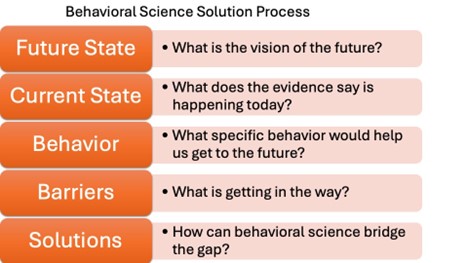
Other considerations include asking what other groups, processes, and systems your organization has that require alignment or coordination. For example, does your company have a strategic planning committee that needs to approve your project before resourcing it? Will your planned timeline deliver proposed solutions in time for the company’s budgeting/procurement process to secure funding? Will potential technology enhancements align with the company’s digital tool prioritization process? Will we need time to collect additional data and evidence to help us fully understand the barriers? If this is the case, you’ll want to build in additional time for research.
The timeframe will need to be discussed with stakeholders for their input and ability to meet their expectations. If you prepare a realistic timeframe, more than likely, one of the biggest concerns in the business area relating to timelines will be how much time it takes. Most business areas apply pressure for the process to move faster. As the project leader, you can shorten the timeframe by accelerating the process, however, often the biggest barrier to moving fast is the availability of the busy team members. If this is the case, you have several choices. You can try to convince them that the plan you put forth is realistic and very much worth the time and effort. You can try to adapt and consolidate steps, take some short cuts, accelerate the timeframe, and hope for the best. In many cases, once the stakeholders begin the process and see the value, they will be likely to want to invest the time needed to finish out the process in the originally prescribed manner. So, one approach is to show them the ideal timeline, adapt it to shorten the time, and then have them ask for more as the project progresses and they see the value. Below is a sample of a typical timeline for a small and large project. As you can see the time estimates vary widely and there are many considerations for how to time the various steps. Many of these variations will become clearer as you are introduced to more detail around the steps. So this topic will be revisited later in the program.
Typical Behavioral Science Project Timeframe

Once you have the buy-in from the stakeholders on key dates and milestones, it is helpful to get the meetings scheduled well in advance to give you the best opportunity to secure time and not run into delays due to the lack of availability from key stakeholders down the line. We’ll revisit the timeframe and planning again in subsequent chapters when you’ll be able to make more accurate estimates based on your project.

Case Study 1 – Google: The Challenge
Irrational Labs: Click Here
Google AdWords users face the same problem as many dieters. No, they aren’t all trying to lose weight (we know that) – rather, they don’t see immediate results from their efforts. As with any form of advertising, a user designs an ad, posts it, then waits to see how it performs. Will people click on it? Or will it be a dud? It’s not immediately obvious if they created a successful, engaging ad or a boring ad that people will skip over.
Getting good at creating ads often takes trial and error. A new user isn’t an ad-creating prodigy the first time they make an ad. That’s normal! Their first ad may not see great success, but if they learn from it they can start making their ads progressively better. Whether in a week or a month, they can create consistently compelling ads if they keep at it.
However, it’s hard to do something difficult and not see any immediate result from your work – whether it’s dieting or advertising. Without seeing immediate, positive ad results, some new AdWords users were churning in their first two months using the product. Irrational Labs jumped in to help explore solutions.
Hypothesis
We needed to close the intention-action gap – the difference between what people say they want to do and what they actually do. Humans naturally have limited attention spans. We want to make successful ads, but if we don’t see good results quickly, we get discouraged. We hypothesized that converting AdWords customers from a short-time mindset (I need to see results ASAP!) to a long-term mindset (I am investing to get a great return in the future) would lead to a higher retention rate.
Process
We tested this hypothesis within Google’s call center. When new AdWords customers called for the first time, we randomly assigned them into one of two groups. One group was business as usual – they were the control group. The other half of the new callers – the treatment group – was told they got to participate in a special plan. They were part of “My 3 Month AdWord Expert Access Plan.”
We specifically chose three months to create a long-term mindset at the beginning of the callers’ AdWords experience. Instead of expecting a perfect first ad, now they would have a mental benchmark that advertising requires time to learn. Over time, they could figure out which value propositions, keywords, and creative content work best.
During the call for those in the treatment group, AdWords representatives repeated the “three months” phrase often and asked customers about their long-term advertising goals. The expert then set up a series of five future calls that would be used to help the customer optimize their account for free. On the first call, the customer pre-committed to these future dates, further cementing the idea that this was a product that deserved a longer-term approach.
Results
Success! The group that had the three-month program stuck around longer. Retention rates for AdWords users in the “3-Month Expert Access Program” group increased by 14 percent.
Case Analysis Questions:
1. How was the BS approach different from the way problems may have been solved before?
2. How was the solution different from the typical way of solving problems?
3. What kind of problems could the BS approach solve in your company?

Exercise: Two truths and a lie
1. Give each participant a few minutes to write down 3 things about themselves that they are comfortable sharing with the group. 2 of the things should be true and on should be a lie (or false).
2. Each person takes a turn sharing their three things and asks the group to guess which of the three is the lie. The winner gets the most lies correct.

Course Manual 2: Process Leader
Your Roles as the BS Process Leader
Lead the Process
As the BS process leader your primary responsibility will be to help guide your co-workers and their projects through the process in a way that helps them most effectively reach their goals. More specifically, the BSPL owns the successful administration of the process, leadership of the team, the infusion of BS throughout the process, and presentation of high-quality, impactful BS recommendations to meet the project’s needs.
The BSPL carries broad responsibility for the project, and they wears many different hats to navigate successfully through the process. At times, they will be a project planner; at other times, they will be a meeting facilitator, and still other times, they will be the subject matter expert for BS. The following paragraphs describe each of these roles to help you prepare for the work ahead.
Behavioral Science Subject Matter Expert
The BS process leader(s) are considered the resident experts and key resources for BS in your organization. They will be the “go-to” person for all things behavior. A key part of the work is the ability to apply that knowledge to business objectives. While there is a lot to learn, this program will provide the foundational knowledge and tools to work effectively in this role. We’ll introduce BS principles throughout to increase your knowledge and confidence in the process and core principles.
By the end of this program, you can expect to be able to apply insights from BS, take a problem from your business, and walk through the process of defining the behavioral problem. You should also be able to map possible diagnoses and solutions. Success will come from knowing how to clearly identify a behavioral problem, understand the barriers to change, and develop and assess potential solutions using your knowledge, tools, and solutions.
Note: Since the field of BS is constantly evolving, even the experts with the highest academic credentials are constantly updating their knowledge. BS process leaders are encouraged to continue their learning to stay current. You have an opportunity to keep your finger on the pulse of the latest developments by simply listening to new podcasts or reading newsletters. Some recommended options for continuous learning will be provided.

Project Manager
Each of your behavioral interventions will be a project, and they will need to be managed as such. This includes typical project management responsibilities such as establishing timelines, identifying risks, scoping the work, planning, and scheduling meetings, and communicating with and managing stakeholders. In addition, the BS process leader will likely also be involved with collecting data and running experiments, which also require project management skills.
Meeting Facilitator
Many of the key steps in the BS process involve group work and decision-making. In order for those processes to work effectively, the BS process leader will need to facilitate meetings. The work as a facilitator includes communicating with stakeholders; structuring meetings and exercises to keep participants engaged; soliciting input from quieter members; appropriately managing overzealous members; minimizing boredom; protecting participants’ time as much as possible; and helping groups reach effective decisions. Fortunately, there are many BS principles that can be applied to help increase your ability to be a successful facilitator.
Resource Coordinator
The BS process often requires support from many groups across the organization. In every project, you’ll work closely with one or more business area subject matter experts. Depending on the goals and scope of the behavioral projects, you may also need the support of enablement functions such as the research group, data science area, change management, communications, legal, human capital, or customer experience group.
Coordination can involve securing resources, negotiating timelines, and sharing information periodically throughout the project. In some cases, representatives from these areas may need to take a primary role on the team throughout the project, and other times they may just consult at different stages in the process.
BS Advocate
If BS is a new concept to your organization, you may also need to be the educator, advocate, and sponsor for the process. While the importance of using the process may be obvious to you, it may not be to others. As with any change, you will likely experience some challenges and detractors in creating this process in your organization. Some detractors may say the process takes too long or may want to see the results from other projects before being willing to participate. As an advocate, you should plan for resistance but not get discouraged. This process will demonstrate its value over time as it yields successful results and new solutions emerge for long-standing problems. As a leader, you can be resilient and hold the course.
Data Analysis Promoter
The BSPL has responsibility for bringing BS perspective and solutions to the process of solving problems. This is accomplished by leading a rigorous and comprehensive data-driven process to define the problem, identify future goals, understand gaps between current state and what is needed. Then the BSPL also helps the team identify barriers and brings BS strategies to the table that are designed to overcome those barriers. All of this is accomplished by using a scientific and experimental approach in the process.
Research Crusader
Doing BS in your company isn’t just an academic exercise. The BS process will very likely include some testing. It may require you to design and interpret some basic or more complex experiments. While there is a great benefit to understanding the BS insights you’ll introduce to your company, you’ll need to do research to test them internally to prove them out in your firm’s context. For example, since your customers are different from the customers from another business, you’ll need to test your solutions to determine what works and what doesn’t in your own company. Before implementing your recommended solutions on a large scale, you may also want to pilot test with a smaller group of customers. Running experiments is the fundamental value-add of the BS process.
While this program will give a basic understanding of experimental process and techniques, you may need to partner with someone in your organization who has a more in-depth knowledge and experience with experimental design and testing. More information about these stakeholders is provided in the next section.
Where the BSPL’s Work Ends

The BSPL’s responsibility stops when it comes to the actual outcome of the project. Instead, it is the business area project owner who owns the decisions made about how to move forward with implementation, and therefore the ultimate results. Therefore, at the end of the process once decisions are made about which strategies and tactics to implement, the BSPL’s work may end or drop off. At that point, you may be able to hand-off the execution work of building the solution to another team and move on to the next project.
However, more than likely, the BSPL will need to continue consulting on the development of the solution to help the team responsible for implementation to fully leverage BS principles. The need to continue through implementation will likely depend on the solutions selected. Some solutions can readily be designed by others in the organization, but other solutions will need the close involvement of the BSPL. Since, the need for the BSPL’s involvement beyond strategy/tactic selection can’t be determined until the last part of the process, it’s important to build in flexibility in planning for the BSPL’s time and commitment to the work.
Depending on the project, you may have some degree of shared ownership with the business area for overall project results. The scope of the BSPL’s role can be discussed and negotiated in the planning phase of the project. The conversation should include the BSPL, project owner and the BSPL’s boss.
Additional Considerations
It is highly recommended that you consider co-leading the project with someone from the primary business area who will also have responsibility for the success of the project. While you would obviously take responsibility for the lion’s share of the work and administration of the BS process, this person’s support and understanding of the intricacies of the project business area could be instrumental. For example, they could meet with you regularly to help in advising what might work best for next steps, sharing information about the project context, helping engage the right stakeholders, and keeping those stakeholders updated. In addition, during a longer-term project, they can keep you appraised of any relevant changes in the department or area, potential risks, or any other opportunities you would not be aware of because you are not included in the everyday business of the area. Having a partner from the business area who has “skin in the game” can help ensure project success.
An additional consideration would be to have a colleague or second person who is steeped in the BS approach paired up to partner with you. There are many decisions that need to be made throughout the process, and having a partner familiar with the tools and processes can help steer the project in the right direction when those opportunities arise. This approach would be especially important as new people begin leading the process. At a minimum, a second BS leader could take on the role of consultant for the primary BS process leader behind the scenes. This would be helpful to have a sounding board for any sticky situations that arise while leading this process.
Finally, depending on the scope and size of the specific project you are tackling, you may want to identify someone in your organization who can help you with some of these responsibilities. For example, with a large-scale, longer-term project, it may be wise to recruit someone to the team who can serve as a full-time, dedicated project manager. If you are leading a particularly large team, having a co-facilitator in meetings is also very helpful. If your meetings are conducted using online tools, having a person to help with technology or available to take notes are options the leader should consider.

Case Study 2 – New Product Creation – Blue Apron
How Behavioral Science Can Be Good for Business.
Erik Johnson
May 24, 2017
Delicious, perfectly portioned, and ready-to-cook meals delivered to your doorstep. It only took Blue Apron about three years to join the ranks of the rarefied, so-called “unicorns”—startups valued at over a billion dollars. Driving this success is a simple, smart business idea: send people everything they need to cook tasty, healthy recipes right to their doorsteps (even pre-portion out the salt and pepper). The reason this is such a smart idea is because it answers the age-old behavioral conundrum that humans often don’t do what they know they ought to do. In this case, cook at home rather eat out.
The vast majority of millennials–80 percent—think cooking meals at home is “a good way to live.” And yet they eat out more than previous generations. Why? Cooking can be intimidating, hard to plan, and it can just feel like too much work after a long day. Whatever the obstacle, millennials have a hard time turning their good intentions into, say, fontina-stuffed pork chops with potatoes and pizzaiola sauce. By making cooking easy to do, Blue Apron makes cooking at home an easy intention to follow through on.
Another behavioral insight baked into the Blue Apron business model is that it removes the temptation to eat out by nudging its subscribers to plan ahead. You subscribe to Blue Apron when you are motivated to follow through on your intentions. Groceries arrive when your motivation to shop may have been waning: when you get home from work, tired and hungry.
What kind of obstacles may have existed for a group launching an innovative concept like this one? As an advocate for the BS process, how would you tackle the opponents of this approach?

Exercise
1. Take 5 minutes to think about and jot down any knowledge and skills you have, and experiences you’ve had that could apply to the work as the BS process leader.
2. Take turns going round robin in the group with each person mentioning 1 thing they know or have done that has prepared them for this work.
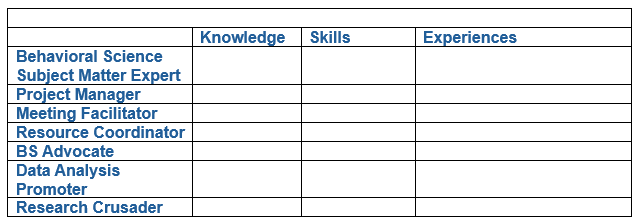

Course Manual 3: Define Problem
This section of the manual describes the significance of accurately defining the problem the BS process is designed to resolve. The work results in a problem statement written to reflect a thorough understanding of the underlying issues surrounding the problem. This manual explains how to define the problem in more detail, goes over problem definition techniques, gives examples, and provides advice and best practices for the problem definition process.
What is Problem Definition?
Your stakeholders will be going through the BS process in order to solve some kind of problem.
There are many types of challenges you may be helping to solve. It could be a challenge associated with the need to change an existing system, product, or service, or it might be the need to develop a new product or tool. Some examples could include problems with:
• Websites, systems, or processes that aren’t working as well as expected
• Inefficient practices
• Low employee compliance with a new policy
• The client experience with in-store customer service
• Development of a new product or tool
A key part of solving this problem will be to clearly define the actual problem. Many say that accurately defining the problem is more important than actually solving the problem itself. In the BS process, having a good understanding of the problem is essential to the success of the project. There are several reasons an accurate problem definition is so important:
1. A well-defined problem statement gets everyone on the same page.
2. By fully comprehending the nature of the problem, the team can work together more collaboratively to find solutions.
3. Correctly defining the problem is likely to make solving the problem down the road much easier, faster, and more successful.

BS Process Leader Role
Since defining the problem is a foundational part of the BS process, the initial problem statement is drafted in the planning phase of the process. The responsibility for writing the statement rests with the BS Process Leader.
There are several reasons for this. First, as the BS project lead, you will need to get a good grip on the problem that needs to be solved. While the BS process leader is an expert in the BS process, they most likely won’t be the subject matter expert on all things related to the business challenge. There is often a great deal of complexity and contextual detail surrounding some of these challenges. Digging in and getting a solid working knowledge of the problem will be incredibly helpful. It will also help you gain a better understanding of the business area’s policies, practices, people, and challenges, which will help you navigate all phases of the process. In addition, you bring an outside perspective to the challenge. This allows you to ask unbiased questions and see the problem from an objective point of view, which is important for having an accurate problem statement.
Lastly, as the leader of the process, you’ll need to be the primary voice of the project. You have responsibility for creating an engaging story for the project, starting with the problem statement. A good problem definition is a key part of the story. This is true even if someone else shares in the role of co-leader (e.g., a co-leader from the business area). As an outcome of the preparation work, the BS PL will need to present a solid draft of a problem statement to the stakeholders. A credible and well-drafted problem statement will help to get the stakeholders on board with the process.
How it’s Used
The BSPL can begin to use the problem definition in the preparation phase to recruit stakeholders and collect additional data. It will then be used in the kick-off and throughout the process to ensure the stakeholders keep focused on solving the right problem. It will be instrumental in explaining the problem clearly and concisely to stakeholders (especially those who have varying degrees of familiarity with the problem). At the end of the project, the team refers to the statement to see if the proposed solution helped solve the problem. In the post-project phase, it also ensures that the same problem does not happen again in the future.
How to Define the Problem
Getting Started
Defining the problem starts with capturing the basic information about what is currently known about the challenge, situation, and context.
In order to develop a problem statement, you will need to find information. There are many sources of information that will vary greatly depending on your company. Keep in mind that there will be more extensive data collection efforts later in the process, so your focus in this step is to gain preliminary information that is readily available to you. In fact, you’ll want to collect as much information behind the scenes as possible. Some possible static sources may be your company’s internal website, newsletters, system or policy manuals, shared data, etc. If the challenge is related to your customers or competitors, you may want to do an external web search for information.

Another primary source of information will come from engaging with some stakeholders who can provide you with the background and basic information you need. This information will likely come from the primary business area and its supporting functions. However, at this point, it is not necessary or recommended to pull in a large group of stakeholders during the planning phase of the project. In fact, you will likely want to keep your search under the radar to some extent so you don’t draw too much attention to the project before you are ready to launch it. If you can create the preliminary problem statement on your own, it’s not a bad idea. This should not create too much concern because the problem statement will be validated and refined as a part of the process later, when the full group is engaged. Whether you’re defining a problem on your own or as part of a team, you may want to consider asking for at least one colleague or business area subject matter expert’s input.
Considerations for Collecting Data from Subject Matter Experts
As you begin talking to stakeholders, they may begin to suggest ideas about establishing features, functions, and other elements to solve the problem at hand. It’s important to avoid moving too quickly to solutions, but it’s also important to let your stakeholders know you appreciate their suggestions and have heard them. It is a best practice to begin logging and capturing these ideas in a “parking lot.”
In addition, keep in mind that sometimes people closest to the work can be biased by their perceptions.

Understanding Bias: Our brains are very powerful, but they also have limitations. Today, we are so busy and bombarded daily with far more stimuli than we can consider and interpret. The brain creates shortcuts, or rules of thumb, to help us process that information quickly. The result is that we develop biases as our brains filter what needs attention and what can be ignored. These biases serve a very important purpose: to help us focus and sift through an overwhelming amount of data. However, many of these shortcuts can be harmful because they cause us to selectively focus on what we expect vs. looking for alternative explanations, thus locking down on false conclusions.
Often, an outside perspective and data are needed to shed some light on these preliminary assumptions and beliefs. This is just a cautionary note, so you should not take all of the perceptions, judgments, and conclusions from the stakeholders as facts. Another best practice is to check in with others to gain different perspectives or test these assumptions if you suspect bias.
While it is important to work through the problem definition process, this is not something to spend weeks on. Remember, it is a preliminary version that helps you and the team get started. It will be validated or refined later in the process. Your search doesn’t have to be exhaustive right now, but you’ll need to gain enough information to define the problem and write a preliminary problem statement in a way that has credibility with your stakeholders.
One final area of data you will want to collect is related to the history of the problem. It will be helpful to know what has been tried before. Why didn’t those solutions work?
Methodology
While you are collecting and reviewing the readily available data, you can begin to ask the questions: what, who, why, when, and where?
Below is a framework that can be useful in understanding the purpose of your challenge. This ultimately boils down to these questions.
• What is the product/tool/service?
• Who are the target users or audience?
• Why does the product exist? Why was it created? Why is it needed (for new product development)?
• How does it (or will it) achieve “the why”?
• When are the target audience or users engaged with it or using it?
• Where is it happening or supposed to be happening?
Gap analysis:
• What isn’t happening today that needs to?
• What is the gap between what is needed and what is happening today?
It may not sound incredibly difficult, but it can be challenging to stay curious and keep asking the right questions. For example, you can expect to find multiple answers to each of the questions depending on who you ask. The next section describes a method you can use to help dig deeper into the “why” questions (i.e., why the product/tool/service exists and why it isn’t working?).
The Five Why Questions Exercise
Ask ‘why’ questions to identify and gain an in-depth understanding of the issue. The Five Whys exercise is a straightforward and easy-to-use problem-solving technique that can help you identify the root cause of a problem. The simple framework includes asking a series of five consecutive “why” questions. Each time an answer is given, proceed to the next “why.”

For example, when thinking about your challenge, ask why it exists. The Business Department at a university may ask, “Why are our graduates having a hard time finding jobs?” With a question like this, there may be more than one answer, which is okay. It’s important to base all answers on facts when data is available. An answer like the labor market is 10% tighter this year than a year ago is much more useful than the opinion that it’s a tough labor market.
Next, continue asking why until you identify the root of the issue. The deeper you go, the more likely you are to reach a cause that’s actionable and within your control to change. In the student job seeker example, you might arrive at a root cause, such as our student needing internships to compete for jobs. In some cases, you may need to ask more than five questions to get to the root cause.
The process allows you dig beneath the surface of a problem. If you can identify the root cause of a problem, you can prevent it from happening again. Knowing the underlying cause enables developing solutions to address the source of a problem, not just its effects.
The Problem Statement
After collecting information to define the problem, you’ll need to give some thought about how to put the pieces of the puzzle together to write a problem statement. A problem statement describes out the current state of the specific challenge you want to address. It describes a gap between the current and the desired state of performance.
Having a clearly defined problem ensures everyone understands the issue they’re addressing. It will be used throughout the process to help the team stay focused on the specific challenge. While this may seem obvious, as projects progress and evolve, teams can easily get off track from the original intent of a project. It also provides a grounding in the project’s purpose, as new stakeholders may be added to the team periodically. Finally, the problem statement can also be used to gain approval from senior leaders to continue going forward with the project.
Since the statement is so important, it’s also important to get it right. It has to be clearly and accurately written. The problem statement format may vary in terms of what makes sense to include depending on the project, but typically includes the background, presenting problem, impact, why it’s happening, and the actual problem statement.
In some cases, writing the problem statement will be fairly straightforward, but in other cases, it will be much more challenging. If these problems were easy to understand and fix, they probably would have been resolved before and wouldn’t have required the help of the BS process. Writing the problem statement will take some “think time” and may require several iterations to come up with a good representation of the problem you can work with.

Below are some tips to help you write a good problem statement, and an example follows.
Objective: It’s important that the statement be objective, only highlighting the facts of the issue and leaving out any biased opinions. Keep it objective and avoid assigning blame. You bring a great outside perspective and can shed light on areas that need further clarification and data.
Explain the problem in specific terms: To describe a gap, you have to explain how things were supposed to work (e.g., the “what and why” can be helpful here). For example, if a process is not working well, you can explain how the ideal scenario would work if the problem didn’t exist. Next, you can shift to describing the problem. Try to explain the problem in as much detail as needed to make it clear and straightforward. Use language that your stakeholders will understand, remembering that they will have varying degrees of familiarity with the area and work. If relevant, remember to highlight any previous attempts to solve the problem and why they didn’t work.
Back up Your Findings
It’s important to back up your statements with data, if available. In most organizations, there is a preference for quantitative data. Your problem statement might include information about what your problem is costing the company or the cost related to the risk of not solving the problem.
If you claim that the problem is costing your company money, you need to prepare to back up those assertions with proof. Otherwise, it may seem as if you didn’t do your homework, and you and the process can lose credibility with your stakeholders. So, be sure to list your sources along with your findings.
Since you are creating the initial problem statement before doing an exhaustive research effort, it may be necessary to include some subject matter expert statements. If you are including these assumptions, it’s important to state them as such. You can support them by adding a caveat such as “source: data shared from subject matter experts.”
Perspective: Since BS is focused on influencing human behaviors, it will be helpful to consider both the company-centered and human-centered parts of the problem. In fact, it’s ok to define the two different aspects in the problem statements. For example, you could define a problem from the needs of the company: “We need to increase our premium-flavored specialty drink sales in rural coffee shops to increase margin and ensure profitability,” and from the users’ needs: “Data shows customers prefer premium-flavored specialty drinks but are not purchasing them because they do not have experience with the flavors.”
Be concise: Problem statements don’t have to be long to address the problem and solution. It’s important that you keep it as clear and concise as possible, only addressing the important facts. Keep it as short as possible without compromising effectiveness.
Use simple language: When writing a problem statement, it’s important that you remember that you’re writing for a broad group of individuals, not just business area subject matter experts. Use language that is simple to read and understand and is free from acronyms or jargon.
Define any key terms: You may have used terms that will not be familiar to all of your stakeholders or are difficult to understand.
Offer Enough Detail to be Clear
Problem statements should offer enough in-depth content to help your stakeholders understand the problem. Add detailed comments and explanations, where they enhance your statement by clarifying where your problem lies, the constraints contributing to it, or what is causing it.
Example of a good problem statement
Background:
A theme park company that hires 30,000 seasonal workers every summer.
Presenting Problem:
The attrition rate for new seasonal employees is 15% higher than it was three years ago.
Impacts:
• The Human Resources group is backlogged by hiring and onboarding the 50,000 seasonal employees and lacks the capacity to source, screen, and hire another 5000 employees (verbal communication from the Director of Operations).
• The estimated cost of hiring a seasonal employee is $300; the cost of replacing the new employees is approximately $1,500,000.
• The inability to cover the open shifts results in requiring overtime for existing employees, estimated at $900,000 by Finance, and an unsatisfactory experience for the seasonal workers (verbal communication from the Director of Operations).
• When jobs are unfilled, the quality of the guest experience is reduced (guest survey results themes, verbal communication from the Guest Relations Director).
• A further concern is related to external research that shows that a lack of staffing can lead to an increase in safety incidents (Theme Park Thrills Magazine, 2024).
Why is it Happening?
• Exit interview data from the employees leaving indicates the primary reason for leaving is poor treatment by their boss (see exit interview themes from HR).
• The majority of employees who left, were under the supervision of first-time leaders. Training exists for these first-time supervisors, and it is offered within the second month of hiring or promotion to supervisor.
Preliminary Problem Statement:
The 15% increase in turnover by new seasonal workers in their first month has created significant cost overruns, stressed the park operations with positions unfilled, overloaded the HR function, a higher risk for safety incidents, and a lower quality of guest experience.

Case Study – Xerox
Want to Perfect Your Company’s Service? Use Behavioral Science
by Richard B. Chase and Sriram Dasu
Harvard Business Review; From the Magazine (June 2001)
Customers were complaining to the Xerox machine-servicing company that repairs didn’t happen quickly enough. At first, the company considered adding more repair personnel, but upon reflection, it decided to give customers more choice over the schedule. It let them determine the urgency of the problem—service people would arrive faster for a critical failure than for a less urgent one.
As expected, this improved customer satisfaction, but what surprised the company was that fewer repair people were needed. The change also reduced the turnover of customer service reps because there were fewer scheduling conflicts with the customers. Conventional wisdom would say that allowing customers to pick the time would force the company to hire more staff. Here, however, as is often the case, customers actually wanted choice more than they wanted an instantaneous response. As one Midwestern company learned, this principle could both save money and make clients happy.
What was the presenting problem that Xerox was trying to solve?
What can help your company begin to look at problems differently?

Exercise: Define the Problem
1. Take 10-15 minutes to answer the following questions for your company:
• Problem Exploration
• What is the product/tool/service?
• Who are the target users or audience?
• Why does the product exist? Why was it created? Why is it needed (for new product development)?
• How does it (or will it) achieve “the why”?
• When are the target audience or users engaged with or using it?
• Where is it happening or supposed to be happening?
• What isn’t happening today that needs to?
• What is the gap between what is needed and what is happening today?
2. Stakeholder Collaboration Practice:
• What questions do you need help answering?
• Pair up with a partner and take turns practicing asking relevant questions
• Remember to use the Five Whys
3. Now draft your Problem Statement. Remember, it’s ok if you don’t have all of the answers yet. This is just a preliminary statement. It’s not unusual not to have all the answers at this point.
• Problem Statement
• Background
• Presenting Problem
• Impacts
• Why is it Happening?
• Preliminary Problem Statement

Course Manual 4: Identify Stakeholders
The Behavioral Science (BS) process is a collaborative endeavor. While the Behavioral Science Process Leader (BSPL) plays a critical leadership role, the process does not occur in a vacuum. In order to solve a problem and implement a solution in any organization, the BSPL will need to work with a team. One of the first tasks of the BSPL is to identify and secure resources for the project. In fact, this may be one of the most important parts of preparing for the BS process. This section will explain what is meant by the term “stakeholder” and go over several considerations related to the best ways of identifying them for the project. This will include clarifying your role, which is important so you can better understand your responsibilities versus what you need from others. In addition, several typical roles will be outlined to help you determine which roles will be needed on the project and how to identify the best stakeholders. Since every organization and project is different, you’ll need to approach each project from scratch to determine which roles and players are needed for your particular situation.
What is a Stakeholder?
Stakeholders are people who have a “stake” in the outcome of your project. This stake could be defined as an interest, concern, investment, or some level of involvement with the project. Their level and degree of interest can vary greatly. For example, a stakeholder may have a very minor role, such as consulting on potential channels available to communicate about a new product to existing customers. As another example, you may need a stakeholder who is an employee in the information technology area and is responsible for programming your company’s order system. For a large project, you may even have a stakeholder who is in the business area and has been assigned to co-lead the process with you.
For each project, you’ll need to identify stakeholders for the project team to work with and support your process, but you may also identify other stakeholders who are interested parties and just want to be kept informed and updated on your progress. For example, you may be working with an engineering group to design a new product, and although the sales area may not be needed to be on the project team, they are definitely stakeholders. They will be interested in knowing about the progress and outcome of your work so they can be prepared to train their sales team, start previewing the product with customers, and be ready to launch the new product when it is ready. Therefore, they should be included in your stakeholder identification process.
The next section will outline some of the most important roles involved in the process to help you begin to think about how to assemble your team. This can be difficult since you are just getting to know your project and don’t have all of the information you need yet. That’s ok, because you can add people to the team later. Just do your best to assess the needs at the beginning as best you can. This becomes easier as you progress through more and more projects and get to know more of the potential players.
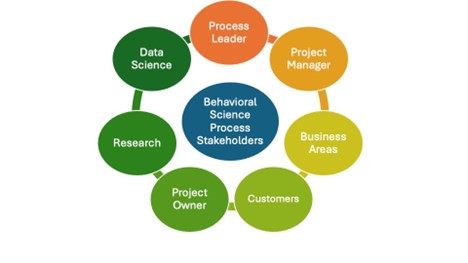
Roles
BSPL
The role of the BSPL was reviewed in detail in Course Manual 2. If you decide to have a co-leader of the project, it would be a good idea to refer back to those sections and identify which co-leader will be responsible for which parts of the process.
Project Owner
The person with the greatest stake in the success of the project is the project owner. They have the ultimate responsibility for the outcome of the project in terms of what gets implemented and the final results (e.g., sales of a new product, increased compliance with a new policy, or increased e-delivery adoption).
The project owner is usually someone who has been formally assigned responsibility for the project and has authority to make decisions related to the project. Depending on how the BS work is organized in your company, the project owner could be you, someone else in your area, or someone in another business area. For ease of explanation, this manual will describe a project owner as someone from a business area or another person from your area, but the principles can apply if you are also the owner of the project yourself.
While the project owner plays a critical role in the success of the BS process, they don’t necessarily have to be completely engaged at every step in the process. Although having the project owner fully engage throughout the entire process is helpful, it is often not practical. Senior leaders often have time constraints on their availability to attend working sessions, which can slow the process significantly. Depending on their level in the organization and the size and scope of the project, senior leaders may assign a trusted employee from their business area to work more closely with the BS process leader through the process. This can be a very effective solution.
If another person (or multiple people) from the project owner’s area is assigned to the project, there are several points where it is still crucial for the project owner to engage personally in the process. For example, it may be important for the project owner to attend the kickoff meeting to set the stage for the team on the importance of the project, their perspective on goals, and what success looks like. They would also need to be engaged at the end of the process when decisions are made regarding recommendations for which strategies to implement. Beyond this point, it may be sufficient for them to stay connected with periodic updates throughout the process. In the planning phase, it’s important for the BSPL to negotiate the best working arrangement with the project owner in terms of their involvement.

Project Managers
Having a project manager’s support in the BS process could be immensely helpful. They can help to schedule the meetings, maintain and adjust the project timeline, ensure meetings have agendas sent out in advance, take notes in meetings, keep the “parking lot” follow-up list, and document decisions. A really good project manager can also help with conflict resolution, risk management, and providing updates to stakeholders. The project manager can be a great partner, and a best practice is to establish a weekly touch base meeting between the BSPL and the project manager. These meetings can be used to review immediate “to-do’s” and look ahead to lay the groundwork for upcoming sessions. Having a project manager oversee every stage of the process is a great advantage.
If you can’t secure a project manager, those responsibilities will fall on the BS project leader. While some of these tasks may seem administrative, staying on top of these many details is critically important and should not be underestimated. The mechanics of managing a project with a good structure and administrative process are critical for getting to the finish line successfully. Since this can be a lot of work, you should try to be creative about getting help. For example, if you can’t get a project manager assigned for the whole project, can you get support from them to help with a few critical points in the process? Does the project owner have administrative help who could schedule meetings? They could manage responses from people who can’t make meetings, reschedule meetings when needed, find meeting rooms, etc., and they are probably more experienced and efficient at doing this work as well.
Data Scientist/Analyst
Having a data scientist or data analyst on the team will be important. In almost every project, there will be multiple points in the process when their skills will be needed. An expert in analyzing data at your company is critical for several reasons. First, gathering, cleaning, and analyzing data is necessary for accurately assessing the problem you are solving and understanding the barriers contributing to the problem. Data analysis is also necessary for conducting experiments as well as evaluating the results at the end of the project when final solutions are implemented.
Second, one of the biggest obstacles to testing in companies is related to the availability and thorough understanding of how the data is coded and warehoused. Unfortunately, many organizations have issues with tracking data over time, such as losing track of where data is stored when analysts leave. These challenges prevent efficient analysis. In addition, the way data is labeled, coded, categorized, and recorded changes over time for various reasons. Someone in your company who knows the irregularities in how the data is organized will be able to navigate those anomalies and piece together what is needed to provide you with accurate data. Without good analysis, you will not be able to make good decisions.
When looking for a data scientist for your project, you may want to request someone who has the capacity to handle and mine medium- to larger-sized datasets and pull from data stored in different areas of the company. Not all analysts understand experimental design, but if they do, that’s a big benefit when you run experiments. Even more important is the ability to communicate clearly with other stakeholders on the team (or at least with the BSPL). A good data analyst can tell the story of the data and its meaning without jargon, and in a way that non-experts can understand.
Finally, we noted earlier that you may be able to outsource some of the functional work needed on the project, but because of the intricacies of knowing your company’s data systems, this role is probably best sourced internally. An exception may be when data is needed from potential customers, which could be collected and analyzed fairly easily externally.
Research/Experimentation/Testing/Surveys
People who have knowledge and experience in research and experimental design are another important role to fill on the project. It may also be helpful to have someone on the team who can help with qualitative research such as conducting observations, interviews, focus groups, or surveys. These tools can be particularly helpful in collecting attitudinal data about barriers to behavior. Employees with these skills may reside in the Data Science area, Human Capital, Insights groups, or a Customer Experience areas, for example. As discussed earlier, this program will provide basic knowledge about this type of work, but more complex projects will likely require partnering with someone with deeper knowledge and experience. Many organizations outsource this work to other companies, which could be an alternative for your projects as well.
Business Area Subject Matter Experts
In addition to the project owner, you’ll likely need additional team members from the primary business area who own or are sponsoring the BS process. These stakeholders are employees with knowledge and experience in the business area. You’ll want to identify and secure people who deeply understand the business situation, market, competitors, internal policies and procedures, systems, customers, employees, and suppliers. They can provide context, help scope your project, and give advice on what is possible (both practically and from a legal perspective). Considering all of these knowledge areas, you will likely need a number of these experts.
Other Stakeholders
Depending on the nature of your project, you will likely need to engage individuals from other groups. For example, you may want to consider including stakeholders who may be involved in developing your solution or communicating it once it is selected. This could include areas such as engineering, information technology, human capital, communications, marketing, etc. The list could be exhaustive and obviously depends on how your company is organized and the kind of project you are supporting.
Customers/End Users
Another potential consideration is the idea of including customers or end users as a part of the project. Having people closest to the problem may be very important in terms of understanding their perspective. However, engaging them through every step of the process may not be a good use of your or their time. Another downside is that since you will likely be discussing both the business and the customer’s perspectives, stakeholders may not feel comfortable saying what they need to say from the business perspective with the customers in the room. For these reasons, this option would not be the preferred path in every situation but might be worth considering in some cases (e.g., new product development). Even if you don’t add end users to the team, you can still get their input through the current state data collection process, or you might want to engage them during very limited sessions, such as future state goal setting or determining solution sessions.
Core Working Team
It’s important to build a core team of stakeholders who will be participating and contributing to the process from beginning to end. The core working team will be responsible for the heavy lifting throughout the project. They will meet more frequently and will do a lot of the work needed between meetings. It’s important to select the right players for the core team. The other stakeholders will also be part of the project, but they don’t attend all of the working sessions and may serve in more of a “plug and play” capacity, entering and leaving the team at various points as needed.
While there is no exact size for a team, a rule of thumb is that somewhere between 6 and12 core team members works best. You should carefully consider who to include on the core team. More details about those considerations will be covered in the next section on engaging stakeholders.

Role Clarity
When all the players understand their part in the process, how they can depend on the others, where the “hand-offs” occur, and how they connect to deliver results, they perform better. Clarifying roles prevents misunderstandings, mistakes, and wasted time. Part of the work of identifying stakeholders is to assign and communicate clear roles.
RASCI
Responsibility charting enables you to identify and clarify decision making responsibility for various components of a project and/or process. The RASCI method can be very helpful in accomplishing this work. The acronym stands for responsible, accountable, supported, consulted, and informed. A RASCI chart looks at all the activities or decisions needed for a project and maps them against the stakeholders, with clear roles assigned for each task. At each activity, someone will be responsible, accountable, consult, support, or be informed about that task or decision.
RASCI Role Definitions

Example of RASCI Matrix for BS Process:
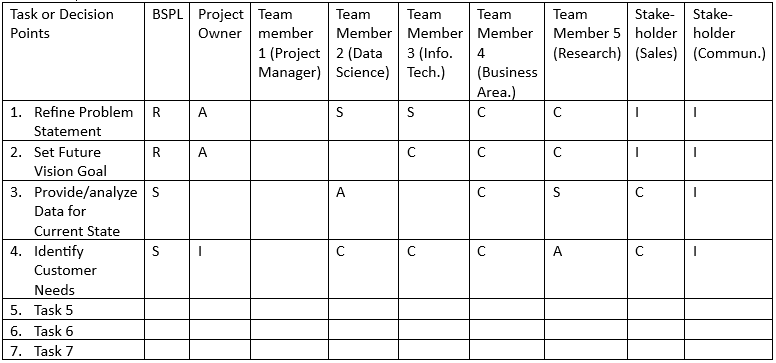

Case Study 4: This case highlights what a good analyst can do for a project. It also introduces the BS principle:
Understanding Finish Strong: that people remember how an engagement ends much more strongly that how it begins or anything in between. This has big implications or designing customer service experiences.
HBR (1-11) Psychology
Want to Perfect Your Company’s Service? Use Behavioral Science
by Richard B. Chase and Sriram Dasu
From the Magazine (June 2001)
A statistician was hired to determine what factors accounted for the sales success of a new video game. The client agreed at the start that the project would be a success if the consultant’s model could explain just 6% of the variability in sales among a dozen competing video games.
The consultant made progress over the first three months of the project, but it wasn’t until the last day of the schedule that the analysis yielded a three-factor combination that explained more than 90% of the variability in sales. (For the gamers out there, these factors were kid testing, advertising, and the number of outlets they could get the game into.)
This positive surprise had far more impact than it would have had at the outset, since the clients’ longer-term involvement had sensitized them to the complexity of the task. Our colleague was lucky to deliver such a clear, better-than-anticipated result; he was luckier still to have done so at the eleventh hour.
1. If the company had this data available, what value did the statistician bring to the process in this case?
2. What made the company value what the statistician did?

Exercise: Stakeholder Identification and Role Clarity Assignment
1. Stakeholders
• Make a list of the key stakeholders and functions you think you might need for your project. Add their names to the top row of the table below. If you don’t have a specific person in mind, you may need to use TBD (to be determined) at this point.
• Include their department/area as well as the reason they were identified (e.g., they need their expertise in analyzing data, or they’ve asked to stay informed).
• In the final column, indicate if you have them earmarked for a role on the core team.
2. Split the group into two teams. Ask for a volunteer in each team to share the roles they identified for their project and why they selected them.
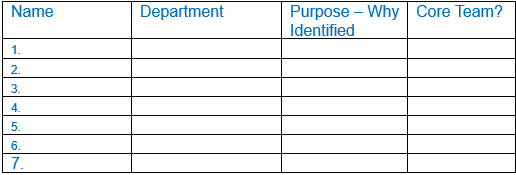
• Ask the team to read the guidelines on the RASCI process below.
• Next ask the groups to jointly discuss filling out the RASCI chart together for the project the individual who volunteered to share in step 2.
• List the roles of anyone involved in the project/process (individual/team/department) across the top row. Expand the columns as needed. The BSPL and Project Owner are included first because they will exist on every project.
• For each decision/process step, assign a code as shown below.

1. Try to focus on critical work and avoid obvious or generic activities (e.g. attend meetings).
2. A Responsible person and an Accountable person must be assigned to every row.
3. Place Accountable (A) and Responsibility (R) at the level closest to the action or knowledge.
4. A best practice is to have only one “Accountable” per activity, except in a matrix, where two managers may share accountability.
5. It is a best practice to begin each decision with an action verb (e.g., evaluate, approve, publish, schedule, conduct, report, write, develop, review, record, update, inspect, determine, collect, train, and determine).
6. When the action verb implies a judgment or a decision (e.g. evaluate, monitor, inspect, review), add a phrase to indicate the primary outcome. Example: “Analyze data to identify the source of delay.”
7. Not every box needs to be filled in, some tasks don’t require the whole team.
8. If time permits, analyze your RASCI matrix
• Is there work to be done, but no one has identified who can do it? Could you outsource it? These are questions you may want to discuss with the project owner.
Example questions:
• Rows– Does every row have an A? and a R? Too many I’s – do these stakeholders really need to know about so many parts of the process?
• Columns – Is there a column that has too many R’s – are they overtaxed? Will they become a bottleneck?

Course Manual 5: Current Evidence
Another important step in the planning process is to analyze the current state and the context around your challenge. The current state will later be compared to the future state goal to better understand the gap you will work to eliminate. It’s important to get the current state right, so getting as much data as you can to accurately understand the extent of the gap will be important. Fortunately, a core tenant of BS is to always use data to make decisions, so in this process, you will be continuously focused on obtaining good evidence and data as you progress.
Remember, in reality, you will likely be collecting data throughout the entire BS process.
As you engage in this process, you’ll discover more and more questions you’d like to answer. Unfortunately, you won’t be able to answer some questions about the current state immediately without additional data collection efforts. In these cases, getting answers may require more time and a more formal process to collect and analyze the data. Therefore, starting in the planning phase can help you deliver on some of the longer-term data collection needs.
Catalog and Track Insights
Once you start collecting existing data, it will be important to inventory the insights you are gaining. This section will also introduce you to the idea of starting a data repository for your project. Your work collecting this information and then bringing it to the group is an essential part of the process. This is important since you’ll likely find that nuggets of information exist in different places across the organization. Since you may find that different people and areas have different parts of the puzzle, no one has the complete picture. It will be critical to find what you need, when you need it, housed in one place. The repository will be helpful as you continue through the process. As you encounter varying opinions and perspectives among your stakeholders, this data repository can become a source of truth to bring people back to the data. It is also critical to have this repository, as new people are added to the project and need to be brought up to speed on the team’s progress. Here are some recommended fields to include in your repository: Topic, Key insight, Source (internal/external), Timeframe, Context, Implications. Of course, you can add whatever columns or structure would work best for your organization or project.
Below is a sample data collection chart from a coffee shop company interested in the drop in sales of specialty coffees.
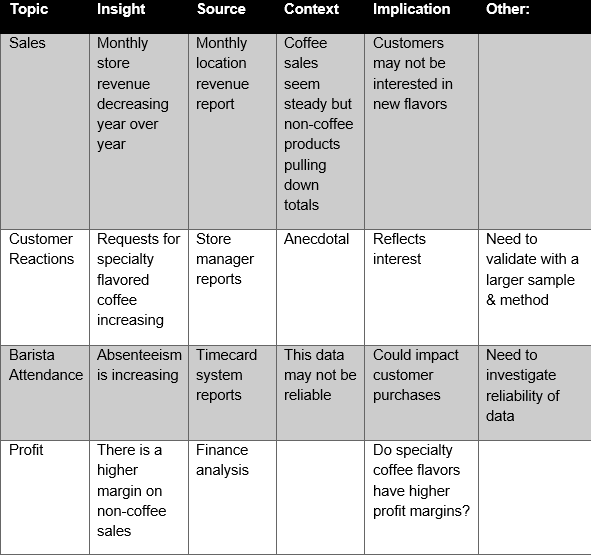
Anything Changed?
As you recall, you initially gathered preliminary data in order to develop a first draft of a problem statement. Now that you have identified and are beginning to engage more with your stakeholders, you can do a more thorough job of collecting data to help you and the team understand the current state. One of the first steps involved in this phase is to review the information you collected when you were developing the problem statement to determine if anything has changed. For example, as you have spoken to more stakeholders and learned more about the challenge, your questions and interpretation of the data may have gotten more precise or changed direction to some extent. This is a natural part of the process and should be expected as you progress through it. Remember, your early attempt to collect data was just a preliminary attempt that you knew would be validated later in the process. In fact, you can continue this refinement as long as you keep adding to the pieces of the puzzle throughout the process.
Compile a List of Questions
There are so many questions you and your stakeholders may have about the challenge. For example, what is current usage, completion rate, sales volume, compliance, error rates, compliance, etc.? How are customers, employees, or other stakeholders feeling about the service, product, or tool? What are their attitudes, desires, level of satisfaction, frustrations, and hidden needs? What is happening with the competition? Are employees satisfied with their training with the system, the tools to support customers, and their level of confidence in advocating for the product?
Each time you talk with another stakeholder, you will likely add to the list. It is helpful to keep a running list of questions that need answers. Below is a list of possible topics that may be helpful as you organize and catalog your questions. Of course, the topic categories for your project and company may be different, but this may help you get started. You can update the list by adding questions as they come up and by taking questions off of the list when you have the data to answer them. You may also want to add a column to identify which stakeholder asked the question so you can refer back to them with updates.
Project Question Log:
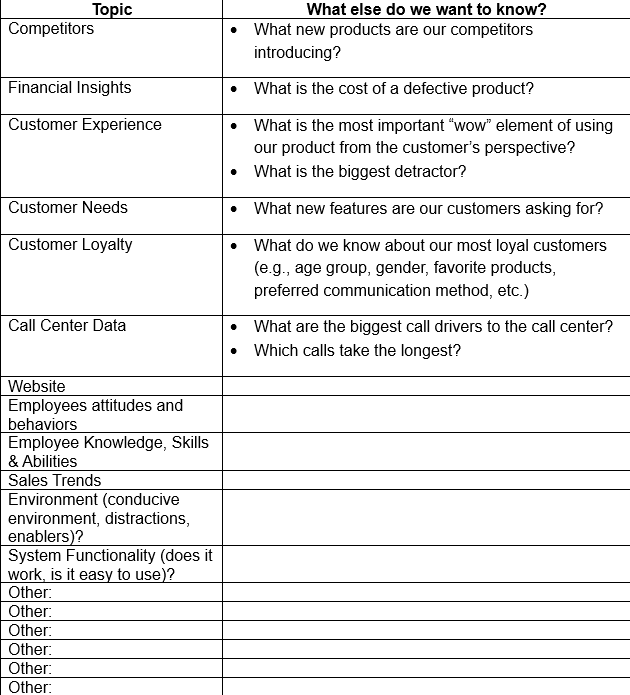
Different Types of Research to Answer these Questions
There are multiple research approaches to help answer the questions you have. In this program, we’ll cover the most likely types of methods you’ll encounter doing this work. It is noted that even if you won’t be designing the research or doing the analyses yourself, having a basic grounding in these methodologies will be vital for the success of your process. This will start with an overview of three core research approaches to help you answer questions.
The first type is called Descriptive, and it “describes” the current state. It answers the question, “What is happening now?” Simple examples include “How much time customers are spending on the website?” and “What is the last page they see before they drop off the site?”
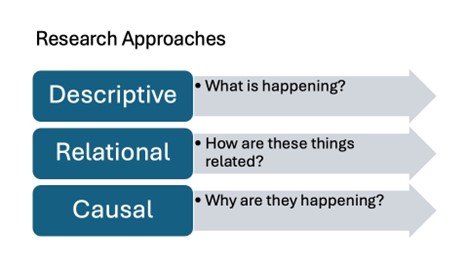
The second type of research is known as Relational because it describes how two things relate to each other. Examples here include looking at the relationship between customers and purchases. You might ask how the existing customers’ online purchasing behavior differs from that of new customers. We would assume that existing customers are buying more when they visit, but is that really the case? You might also want to know who is shopping with coupons, whether they return to the site after purchasing, etc. Relational data might be leveraged for the current evidence phase of the process when you have equations about how two or more variables relate to each other.
The third research approach is known as causal. Here we look at whether one thing “causes” another thing to happen. It tells us whether changing one thing causes a change in behavior. For example, did the price decrease increase sales? We’ll leverage the causal approach toward the end of the BS process to pilot test some potential solutions and measure the impact of the change. Since, at this point in the process, we are interested in the current state, we’ll leverage mostly descriptive research and, in some cases, relational data.
Quantitative vs. Qualitative Data Analyses
When people think about evidence and data, they typically think about quantitative data represented by numbers, dollars, and statistical analyses. Quantitative research is great for collecting numeric/objective information in a short period of time. It is great for answering “what,” “how many,” “how long,” and “when” questions. In order to fully understand the current state, it will also be important to consider qualitative results as well.
Qualitative research is great at helping to tell the story about what is happening. It is used for collecting nuanced, detailed subjective information that is hard to express numerically. This is great for answering “how” and “why” questions. In addition, qualitative studies help us understand the perspectives and attitudes behind the decisions and behaviors and the why behind the numbers (i.e., the quality).
Qualitative data is vital to the BS approach because it answers the why and how questions help identify the barriers we need to overcome.
For example, in qualitative research, we can learn about customers’ feelings about the website. You can answer questions such as “Are the customers able to find what they need? Are they frustrated by long loading times for images on the site? And do they want to see more customer reviews?” These analyses rely on methods such as observations, focus groups, interviews, and surveys. The next course manuals will go into more detail about leveraging these important qualitative methods.
Finally, it is important to note that analyses of the current state will likely include both quantitative and qualitative data.
Sources of Data
The next section will cover where we get data from. Examples to consider will be provided below. In addition to analyses of existing data the next three manuals will delve into how to plan for collecting additional data.

Exploring Data Mining Opportunities
Today, there is more data available than ever before. In fact, many organizations have large amounts of that they have been collecting, but haven’t had the time, resources, or prioritization to mine the data and answer questions. For example, the amount of data and intelligence collected on a company’s website is mind-boggling. Just because there isn’t a published report outlining the information you are interested in, don’t assume it doesn’t exist or would be impossible to obtain. Spending time reviewing your questions with the groups responsible for data and research could be very helpful.
Of course, it would be a mistake to assume that it would be easy to pull the data or that the experts would have time to run your analyses. With the advent of big data and artificial intelligence, many data groups are overwhelmed with requests for data mining and analysis. Your organization may have a “line” you need to join to get your questions answered or a formal process for prioritizing requests. In some companies, leveraging your project owner to navigate the appropriate channels may be the best way to get the support you need.
However, meeting with an analyst or data expert to find out what is possible is a great place to start. They may be able to point you to other helpful data and insights you weren’t aware of. You may also be able to get their help scoping the analysis in terms of their time, effort, and the feasibility of the work, which will help you get your requests approved.
External Data
As you are considering current state evidence, it’s important not to overlook external data. For example, it may be helpful to know what is happening in industry. What data do you have and need regarding competitors (e.g., their products, services, customer preferences, potential weaknesses, and opportunities, etc.)? For example, the podcast team may have a question about how long people stay on their podcasts but may not have access to that data. As an alternative, they may look to external data to inform the average listener’s preferred podcast length and how much time they typically listen.
No Data Available
Stakeholders have often expressed concerns when they fear or claim that no data exists for the problem the team needs to solve. Many times, stakeholders overlook existing data or don’t realize how much they already have because it hasn’t been compiled and documented in a central location. In these cases, it is helpful to ask them how the decision was made to initiate the project. At some point, a leader in the company had some information that a new product was needed, something wasn’t working as well as it could have, or an enhancement was needed. There had to be some data used to make these decisions. This is a great place to start.
Another source of information that shouldn’t be overlooked when other empirical data is scarce is the subject matter expert perspective. While objective data that represents more than one data point is always preferred, subject matter expert observations can be helpful and should not be overlooked. You can strengthen this data by asking other subject matter experts if they have the same observations, or by planning another analysis to validate their assumptions.
As the BSPL, you can help calm the fears of your stakeholders when they claim there is no data by capturing the data you do have, documenting the questions that need to be answered, and considering some non-traditional forms of data. This documentation helps you create a plan of action to begin collecting and analyzing the data needed, and in doing so, gives stakeholders some relief.
Analyze the Competition
You will likely want to do some research to understand what other products are currently available on the market and identify their strengths and weaknesses. This can help identify gaps in the market that the product can fill or opportunities to differentiate the product from its competitors.

Case Study 5 – McKinsey
Give People Rituals, and Stick to Them – McKinsey
Want to Perfect Your Company’s Service? Use Behavioral Science
by Richard B. Chase and Sriram Dasu
From the Magazine (June 2001)
HBR (1-11) Psychology
Most service-encounter designers don’t realize just how ritualistic people are. They find comfort, order, and meaning in repetitive, familiar activities. Rituals are particularly important in longer- term, professional-service encounters: they’re used to mark key moments in the relationship, establish professional credentials, create a feeling of inclusion, flatter customers, set expectations, and get feedback. Common rituals include glowing introductions of staff at the start of an engagement, kickoff dinners, elegant PowerPoint presentations, final celebrations, and formal presentations to the CEO (even though he or she may not have an interest in the project). Many rituals are so small in scale that they’re hard to name. Nonetheless, they play an important part in customers’ perceptions of the experience. When McKinsey consultants listen to clients, for example, they pepper pauses in the conversation with a characteristic, noncommittal “uh-huh, uh-huh” that somebody once labeled the “McKinsey grunt.” Sounds silly, but clients notice when it’s missing.
Behavioral researchers have observed that these rituals provide an implicit standard for evaluating service encounters. Deviation from them is often cited as the cause of a failure—particularly in professional services, where customers have difficulty evaluating precise causes and effects. Check in with customers after something’s gone badly with a service engagement, and you’ll find that this is quite true. “If Henry had covered the ten-step model on the new benefits system like Susan did for the old one, it wouldn’t have flopped.” (The new system didn’t require the ten- step ritual; it failed for a constellation of other reasons.) Or, “The consultant wearing the string tie was off in his forecast by 10%.” (The dress code violation had nothing to do with the consultant’s technical skills.)
It’s easy to laugh at those examples, and more generally to dismiss people’s tendency to focus on deviations from norms and rituals when they’re trying to explain a failure. But make no mistake, behavioral science clearly shows how critical rituals are in long-term relationships. Not getting the weekly call from the consultant on a project, not copying the CEO on a progress report, not returning phone calls immediately—any of these lapses can be blamed after the fact for a failure. They can also, and even more ominously, shift a customer’s perceptions about the quality of the service, the service providers, and the company they represent.
Ultimately, only one thing really matters in a service encounter— the customer’s perceptions of what occurred. Executives who design and oversee service encounters need to focus far more of their attention on the underlying factors affecting those perceptions. We believe that service encounters can be engineered to enhance the customer’s experience during the process and his or her recollection of the process after it is implemented.
1. What was most compelling to you about this case?
2. Do you agree with the author that “It’s easy to laugh at those examples, and more generally to dismiss people’s tendency to focus on deviations from norms and rituals when they’re trying to explain a failure.”
3. What questions would you ask McKinsey’s customers to understand this challenge better?

Exercise: Current Evidence
1. Create an informal Evidence Repository.
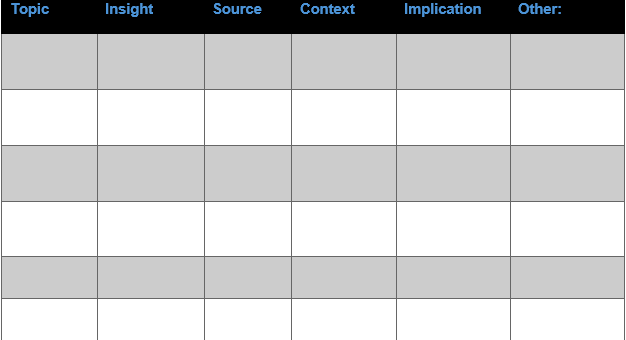
2. Break into small groups (e.g., 3-4) and share 2-3 of the key pieces of data that exist today.
3. Identify additional questions.
4. Leverage your group to identify at least 3 additional questions you want to answer.
5. Complete the following question grid as you consider your challenge. Use the prompts in the left column to think about potential questions. Not all will apply to your situation. In addition, you may have other topic areas that apply to your challenge. These are meant to trigger your thoughts and can be edited. This is meant to help you organize your thoughts about potential questions. Try to ask both qualitative and quantitative questions.
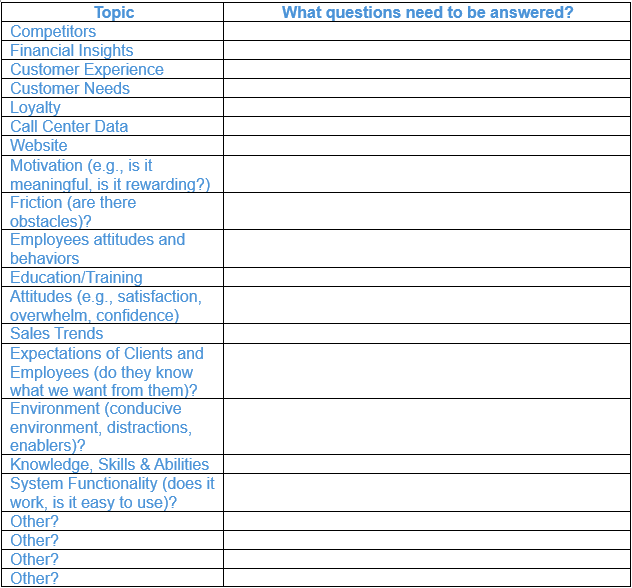

Course Manual 6: Attitudes Matter
This section focuses on collecting qualitative data for your project. Similar to the popular Design Thinking movement, the BS process advocates for deeply understanding customers/employees as humans. As was discussed in the last course manual, qualitative data concerns attitudes, perceptions, thoughts, and intentions. This research methodology is particularly good at understanding and then telling the story about what is happening and why. In addition, qualitative studies help us understand the perspectives and attitudes behind your customers and employees’ decisions and, more importantly, their behaviors. Using this approach, you’ll be able to answer questions about how customers are likely to feel about changes to your product, whether they are frustrated by packaging, or how much they dislike the long wait times for customer service.
It differs from quantitative data in that it is subjective. You may encounter people who are biased toward quantitative data because it is more objective, easier to measure, and easier to interpret. For these reasons, it is often seen as more accurate. However, there is an important place for qualitative data in your work. In fact, you may find that the qualitative data you collect carries at least as much, if not more, weight than the quantitative data in the BS process.
BS fully recognizes that perceptions, attitudes, and intentions are not reality. In fact, an important principle in the field of BS is the idea that perception is not performance. The idea here is that humans may have the best intentions but never get close to carrying out the behaviors they intend to adopt (therefore not performing as expected).
Perceptions are not Performance.
Examples of this abound. Consider anyone who is trying to overcome a bad habit. They have the best intentions but struggle mightily with changing behaviors and struggle for days, weeks, months, or years to make the changes they intend to make. And so, it is understandable that people may not put stock in perceptions and attitudinal measures. However, as a BSPL, you recognize that perceptions, thoughts, and attitudes can absolutely be obstacles to a behavior. As a matter of fact, they can be the most important barrier to getting the results you are looking for.
Hopefully, you can now see the value of qualitative data and can advocate for its importance. That said, we may also acknowledge the inherent flaws in this method of data collection and put safeguards in place to minimize them. After all, the subjectivity of the data is fraught with challenges. As mentioned earlier, since the qualitative data collection is subjective in nature, there are some research methodologies that can make the subjective perspectives more objective.
How is this Approach Different from Design Thinking?
Many of you may be familiar with Design Thinking and are wondering about the differences in the methodologies. It may be helpful at this point to discuss the similarities and differences between the BS process and the popular Design Thinking approach. If you aren’t familiar with Design Thinking, one of the main goals is to identify solutions that take the user’s needs into account in a deeply, human-centered way. While there is a similar focus on humans in BS, it is different. Design Thinking involves building products and services based on customers stated or observed needs and desires.
BS enhances this technique by recognizing that, as humans, we are not always aware of our needs or able to articulate them. More importantly, we aren’t always aware of the things that drive our behavior. In fact, a core premise of the BS approach is that humans are not aware of why we do or don’t do things we want to. For example, as humans, we often don’t do things that line up with our intentions (e.g., think of someone trying to lose weight eating an ice cream sundae). There’s a saying we use that “perception does not equal performance.” So, even though we focus on behavior, starting with a deep understanding of customer needs is a great place to start. However, in the BS world, we don’t stop there. In addition to addressing the needs that the customer has stated, we would create solutions for removing behavioral barriers that the customer has not yet identified. Fortunately, the BS process is a powerful approach to overcoming both real and perceptual barriers to performance.
Considerations for Understanding Your Users
Start this process by reviewing your question list from the previous section. What are the questions you need to answer? Keep this list in front of you as you consider which of the qualitative data collection methods is going to give you the best outcome. Below are some additional questions you might want to consider as you decide what you want to know from your customers and/or employees.
Qualitative Analysis:
The four primary tools of qualitative data collection are observations, interviews, focus groups, and surveys. Each of these methods can help you answer the questions you need to ask, but there are differences between them in terms of the quality of data, type of data, the resources involved (time of the participants and researchers), as well as the cost. These considerations will be outlined in the upcoming sections as each methodology is described.

Before going into each of these methods, you’ll be introduced to some other important aspects of running qualitative research studies that apply across all of these methods. We’ll offer tools and information to help you make this subjective data as objective, reliable, and valid as possible. Practical advice for navigating the context around these methods will also be provided. Laying this groundwork with these considerations will also help you better understand some of the pros and cons of each method and, therefore make a better decision about which approach will work best to answer your questions.

In this manual, we’ll cover how to recruit for the research. In the next manual, we’ll cover who to recruit and how many people will be needed.
While you could learn this in a research methods course at a university, what you’ll learn here are practical tips and advice for ensuring you leverage the best scientific principles to deliver important results working within the practicalities of a real organization.
Recruiting Research Participants
Messaging
There are several important factors to consider in terms of communicating with potential participants. First, your message should be clear, crisp, and easy for them to say yes to. It should have an easy-to-see “call to action” so they know immediately what you want them to do. Examples include “Register Here” in bold letters, set apart from the rest of the message.
You’ll want to set the stage for your research to be the most conducive to getting honest and accurate responses from the respondents. This starts with building trust. To do that, you will want to be forthright and transparent about the purpose and you want and need from them. However, it is also important that you don’t provide so much information that you are “leading” them in a direction. You should be unbiased and appropriately vague about what you expect. Below are some examples:
Customers:
• We are interested in learning more about your reactions to ideas for a new product and want to survey you to learn more.
• We recently made some changes to our website, and we’d like to get your perspective. We’re inviting you into our offices so we can show you the changes in person and observe you using the site.
• We are considering changes in our customer reward program, and we’d like to learn what prizes are most appealing to you. We’d like to invite you to a focus group to get your perspective.
Employees
• Our occurrence of safety incidents has increased this year, and we are concerned about your safety. We are interested in what we can do to improve the environment and keep you safe. Please participate in the interview to learn more.
– Note that this invitation would likely have some sensitivity because some could see the interview as a witch hunt to blame employees or could end in retaliation if they say things that are negative about managers or the company, so you’ll need to build trust and make sure you clarify confidentiality.

Why selected?
Often, people want to know how they were selected. They tend to like it when they are invited because of something special about them. For example, “You were selected because you are in our company’s top 10% of sales.” If there is something particular (and positive) about why you selected them, it may help to include that information in your invitation to encourage them to participate. Hopefully, it’s obvious that you wouldn’t want to mention that someone was invited because they were in the top 10% of accidents at the company. Also, participants don’t particularly like hearing they were selected randomly, so it’s probably best to exclude them from your invitation as well. If they ask after they receive the invitation, it’s important to be honest, and hopefully it won’t deter them from participating.
Communications
How will you reach out to your target audience to invite them? You can send them an invitation through the mail, email, or even call potential participants. All three methods have pros and cons.
Regular mail: Some people like to get mail and feel special when they do. Getting an invitation in the mail could enhance your chances that these people will read the invitation and respond positively. Others, however, may dismiss, overlook, or throw away an invitation received in the mail. In addition, there’s no guarantee the invitation will actually arrive, and there’s a higher cost for large studies (both time, materials, and postage). Even if you use mail to invite participants to the study, you’ll likely want them to register online so you can track participation and send reminders electronically.
Email: There are some definite advantages to using email. First, it’s quick and easy. Many email software packages will also allow you to see who has read the email, track acceptances to the study, and allow the participants to record an appointment on their calendars. You can also imbed a link to register or to obtain more information. Many systems can also help you send those helpful reminders! All of these advantages make email a very attractive option.
Phone calls: Obviously, making phone calls can take the most time, but it can also be one of the most effective methods of convincing people to participate in your research. People know it takes time to pick up the phone, and they are likely to feel special vs. an email that can easily be sent to a large group of people with little effort. A phone call also gives them a chance to ask questions and gives the researcher the opportunity to overcome objections. If you have help making calls, you’ll need a script to make sure everyone gives and gets the same information. In addition, you’ll need to follow-up with an email providing the details and reminding them about the purpose.
Timing
Include an estimate of the time it will take to participate (e.g., a 1-hour focus group or a 20-minute survey). Try to schedule the research within 2 weeks of the invitation or contact. You don’t want to invite them so early that they forget and other things come up. If you make it too close to the invitation, you may have trouble filling your study and need more time to fill slots. It can be very inefficient to run a focus group with two people, for example. In addition, some participants may think the research is not very important if you haven’t planned it with a sufficient lead time.

How Will It Be Used?
This is an important question, and for employees in your company, this is particularly important. They will want to be assured that they will not be retaliated against or embarrassed if their responses are shared with others. Ensuring confidentiality is critical if you are looking for honest responses. When there is a promise of confidentiality, only the researcher or research team will be aware of the specific responses. Language protecting confidentiality might say
Your responses will only be reviewed by the research team. They will be combined with others and will only be shared at the group level for reporting. Your individual responses will remain confidential. After the research is completed, only the group-level reports will be retained.
In particularly sensitive data collection efforts, the participants may or may not trust your statements, but it’s the best you can do to make it safe. If you are particularly concerned, you might want to hire an external firm to collect the data, which provides another layer of confidentiality.
Another option would be to make your research anonymous. Anonymity is a higher standard and means that there won’t be any association between the response and who the responder is. It means that their responses are not able to be tracked back to them. Obviously, this isn’t possible except through the survey methodology. However, there are tradeoffs with making your surveys anonymous. For example, after conducting the study, you may decide that you want to compare the responses between men and women as an afterthought. If the data is anonymous, you can’t do that unless you ask them about their gender in the survey. However, if their responses are associated with a particular employee, you may be able to pull the gender data and append it to your analysis.
A final consideration is the use of verbatim responses in the research. There may be times when you will want to use a particular statement or story shared in the context of the research to drive home a particular point. In these cases, it’s important that you share the quote but not the participant’s name. If the quote could easily be associated with that individual (e.g., due to the particulars of the story), it is better to not use the quote than to risk losing the trust of your research participants.
Administration/Approvals
There are many details related to the research that you should include in your communications. Having this information spelled out in advance is a real time saver and will help to avoid frustration. You’ll need to consider how you will conduct the research (phone, Zoom, or in person), and all of the details and preparations made for a successful study. For example, do you need to reserve rooms, arrange for a note-taker, bring product samples, and know how to lead a Zoom session? Are instructions provided if you or your participants need to reschedule? Will the research sessions be recorded (e.g., for interviews and focus groups)? Do you want to make the session more efficient by providing any pre-work or reading to help the participants prepare?
Finally, you will likely want to get someone in the business area to sign off on your materials as well as someone in the legal group (if that is appropriate in your firm).

Case Study 6 – Messaging
“In the last half of 2015, Louisville had over $1.1 million in parking fees and fines that went unpaid, according to data provided by the city’s Parking Authority (PARC),” the BIT writes in a blog post.
“These unpaid fines are not only an issue for the city, they’re an issue for drivers as well: if drivers ignore their ticket, they’ll be charged a late fee, and their debt will ultimately end up in the hands of a third-party collection agency.”
The city of Louisville was already sending drivers two reminder letters for unpaid parking tickets — one sent seven days after payment was due and another sent 14 days after the payment date. The BIT worked with PARC to design a third letter that would be sent to drivers who still had unpaid parking tickets after 45 days. A sample of 1,831 different drivers were randomly assigned to receive either the standard letter or a new letter designed to increase payment rates.
The new letter included a highly salient “Pay Now” stamp on the front. Additionally, the new letter was also tweaked to make use of social norms, including an accurate statement that “the majority of drivers who receive a parking fine in Louisville pay it within 13 days.”
The results of the experiment were impressive: After one month, the treatment letters had increased payments by 10.5 percentage points. The control group paid their fines at a rate of around 8.1%, but the treatment group paid their fines at a rate of around 18.6%.
With just a couple of simple tweaks, the BIT estimates that utilizing this redesigned letter could help the city of Louisville save an additional $100,000 each year.
1. What factors contributed to the increase in parking fees being paid?
2. Would this be something your company would consider?
3. How can you apply this to your messaging to the people you are inviting to your study?

Exercise
2. Pair up with another person in your group and take turns sharing your message and the rationale. The listener can ask questions, offer feedback, and play the devil’s advocate. Next, reverse roles for sharing and feedback.
3. Share back to the large group with any insights or questions you had about the process.

Course Manual 7: Research Agenda
This section will continue providing the information needed to conduct your research, focusing on identifying your sample. This work will require close collaboration with your data analyst and research areas. Next, recognizing you can’t do it all, you’ll move on to how to prioritize and set the research agenda for the project.
Target Population
You’ll need to work with your data analyst group to get a list of people to invite to the study. They should be able to help you identify the right number of participants and the best way to organize the sample.
Participants
Deciding who to include in your research is an important question. You can start by reviewing your list of questions. What categories of people do you need to include to answer your questions? For example, do you need to understand differences between new and existing customers, different age groups, different genders, online shoppers vs. in-store customers, people who purchased the product in the past two years vs. newer purchasers, or repeat purchases (regular customers) vs. one-time customers vs. people who shopped, but didn’t buy?
Obviously, the list can go on and on. You may not be able to answer all of these questions or include all of these different groups. Unfortunately, the time, resources, and people who conduct these studies are limited. As a reminder, this may be a good place to ask the question of what is nice to know and what is needed to know. You’ll need to decide which are the most meaningful groups or categories of people that make sense to include in your research.
As an example, if you were researching potential changes that would impact the salesforce in your company, you may compare those who are new with the more tenured salespeople, or those who took the new training program with those who haven’t. You might also be interested in the differences between sales professionals and their leaders or whether the sales personnel feel differently depending on which geographic area they are from. In these cases, you would need to pick participants that represent each of those categories, and in proportionate numbers where possible. So if you have twelve geographical areas and you have questions about whether the changes will create different reactions across those areas, you’ll need to make sure you have participants from each of those areas. It’s easy to see that including important categories can increase the size of the sample needed fairly quickly.
Sample Size
Once you identify the groups you need to include to answer your research questions, you’ll want to meet with your data analyst group. In addition to making sure you include people from the important groups you identified, you’ll also need to work with your data analyst to identify the appropriate number of people you’ll need to include in your research.
As a part of their work, they will want to look at the overall averages of your total sample and will need to “cut” the data to make comparisons between groups. These data cuts are really important because they allow you to find out if your female customers have different needs than your male customers or if your new customers are interested in different features than your more traditional customers, for example.
If your analyst will be making statistical comparisons between groups, the analyses will often require much larger samples (e.g., often more than 100 participants). The most practical way to collect qualitative data from groups this large is to leverage a survey. Your data analyst will be invaluable in helping you understand how many participants you’ll need to answer the questions you need to answer.
Oversampling
While you will be able to get estimates of the number of participants you need, you’ll need to increase the number of people you invite because not all of them will accept your invitation. In reality, even if they all accept, things come up and they may not attend the interview or observation meeting. Here again, you’ll want to “oversample” to allow for no shows.
Incenting Participation
If you are having difficulty securing participants, you might consider an incentive for attending. For example, some companies offer a monetary incentive to customers to attend a focus group or interview. Alternatively, you might offer a preview of a new product line or a chance to sample a new product as an incentive to participate in the research. You’ll be surprised at how effective such offers are at influencing people to say yes. It’s based on the BS principle of reciprocity, highlighted below. However, when you offer an incentive, you’ll have to be aware that the research may be biased by the fact that your participants could be influenced by the gift. This bias could take the form of them telling you what they think you want to hear instead of being honest.

Understanding Reciprocity: This principle is based on the finding that people who are given a gift of some kind feel compelled to respond by returning the favor or gift in kind. While most people believe they are immune from such tactics, it is a widespread and robust phenomenon.
Representative Sample
Another important consideration needed to conduct a good research study is the concept of representation. Does the sample of participants in your research represent the population of people you are interested in understanding? For example, if there are 100 salespeople at your company and 70 of them are men and 30 are women, a representative sample in a focus group of 10 people would include seven men and three women.

Another source of potential bias would be if your sample was based on an open invitation for any of your employees or customers to opt into a survey, for example. The reason is that the people who are willing to respond may not represent the rest of the population. For example, people who take the time to fill out a customer service survey may have an axe to grind that the majority of the population doesn’t share or feel as strongly about. Or people who take the survey may be overly representative of retired people who have more time on their hands, which also may not be typical of your average customer. The solution to this is randomization, which is covered in the next section.
Randomization
Whenever possible, it’s important to randomly select your sample from the available population. For example, in the sales example above, if your firm has 500 salespeople, you could use randomization to select the 140 participants needed for the research. This allows you to assume that the participants selected would have as equal a chance of being selected as not. This allows you to ensure that there are no other factors inadvertently biasing who was selected. If you don’t leverage random sampling, you could unintentionally bias your sample.
As you can tell, randomly selecting participants gives you a better chance of casting a wide net across a group of people that are more likely to represent your average customer. However, it is also acknowledged that this method isn’t perfect because even when you randomly select a group of people to invite to a study, they won’t all accept. Therefore, you may have some bias in the people who are invited who say yes to registering for the research. However, it’s better to at least start with a random sample (including representative numbers of the groups you are targeting) in the invitation.
Another factor that could influence whether the people in your target sample agree to participate is whether they have recently been surveyed, interviewed, or participated in a focus group. Today, it seems as if a survey is generated every time we visit a website or make a call. This continuous request for feedback can create a type of survey fatigue that may discourage people from participating in your research.
Since qualitative data is so important, a best practice in your organization would be to implement a tracking system so you could monitor which employees and customers have been recently surveyed. This would be helpful in protecting them from over-surveying and survey fatigue.
Finally, in addition to over-surveying, you’ll need to go beyond simply targeting the right mix of participants in the invitation. You’ll need to monitor the number of people in each group who sign up for the research.
Prioritize Data Needs
Once you have a good list, you will need to consult with some of your stakeholders, in particular in the data, research, customer experience, and business areas, to see which questions can be answered with existing data. Next, you’ll want to go back to that list of questions and prioritize which ones will be the most important to help you move forward with solutions to the project. Often, data analysts and research areas are in high demand, so it will be helpful to apply some rigor in the prioritization process to ensure you are asking for support for the right questions.
There are a couple of things you will want to consider as you prioritize your needs. First, it will be important to sort out what a “need to know” versus a “nice to know” question is. This is not to say that any question is not important, but it may be a matter of relative importance. When it comes to data and questions, it’s easy to pique people’s interests and intellectual curiosity, so it can be helpful to step away from the challenge and try to take an objective look. Which questions are going to be most helpful in understanding and solving the problem at hand? Another tactic could be to add a column related to the purpose and action steps for each question in the table (see column 2 in the Question Prioritization Table below). The idea here would be to ask what you would do if you had this piece of data. How would it help you? What decisions could you make with this data? Understanding the reason and intended action for the question would help with the prioritization process.
Another consideration is related to the impact and effort of collecting additional data to answer these questions. For example, you may have some really important questions that will take a lot of work and an extended timeframe to answer. While you don’t want to disregard a critical piece of data all together, you may want to postpone it or consider if there is a substitute (e.g., external data on customers in general vs. your customers).
Questions Prioritization Table:
You should also leverage your stakeholders to build out the question list and help you prioritize questions for analysis. You’ll need help from the data scientist and research stakeholders to determine the feasibility of answering your questions.
Set the Research Agenda
Once the questions have been developed and prioritized, you can make plans to work with your data analysts and research department stakeholders to set the research agenda. One final step remains, which is determining which method to use (e.g., observations or interviews). This will be covered in the next section.
Finally, remember that collecting evidence is an on-going process. You and your stakeholders will continue to add new questions as you move through the process. You may establish the best practice of setting aside time to update and review the question table on a regular basis.

Case Study 7
For this case, you’ll need information about the BS principle of anchoring.
Understanding Anchoring: The anchoring effect happens when someone’s judgments are influenced by a reference point, or “anchor”, which can be completely irrelevant. For example, an individual may be more likely to purchase a car if it is placed alongside a more expensive model (the anchor). Anchoring is a bias that describes our tendency to rely too heavily on an initial piece of information when making decisions.
Example Experiment: Quickly guess the sum of the multiplication equations.
Estimate of A__? B___?
A: 8x7x6x5x4x3x2x1=?
B: 1x2x3x4x5x6x7x8=?
Findings: Looking more closely, you’ll notice that the two problems are exactly the same but the numbers are presented in reverse order. Were your answers the same? Most people guess a higher number for A than B – an example of the Anchoring bias. Seeing the higher numbers first (e.g., 8, 7, 6) “primes” us to estimate higher.
This effect has been shown to be true in many seemingly random situations. For example, when people were asked to look at the time or record their birthdates before making an estimate, the anchoring effect prevailed. Those seeing lower numbers gave lower estimates than those seeing higher numbers. This is an interesting effect when we consider a simple game, but the anchoring effect is more important when we consider some of the more important purchasing decisions we make in life.
MSRP: The Manufacturers Suggested Retail Price is a price set on new cars which serves as an anchor for comparison with the lower offering price on the sticker. This has the effect of giving the impression that you are getting a better deal.
Investing: For investors, anchoring bias may be at work when they hold onto a security dropping in value too long. This is due to their strong focus on the high price initially paid, rather than its lower current value.
How Ogilvy Used Psychology to Increase Sales of KFC French Fries by 56%
Ogilvy was asked by KFC to help boost sales of one-dollar french fries. The catch was that they weren’t able to change the size or even the price of the fries.They could only change how people saw the offer. So they tested 5 different ways to say one-dollar french fries. For example, one way was based on reciprocity and sounded like this:
“You wanted free french fries, but we’ll meet you halfway with our french fries for $1”
When your customers feel like the deal you are offering is very generous, they will feel like they need to return the favor.
Another frame they tested was a quantity anchor. Anchoring was made popular by Dan Ariely; numerous studies have found that when companies introduce arbitrary constraints, people respond to it in curious ways. It makes them want it even more!
“By arming someone with an anchor, we can shape the perceived quantity that an individual should purchase,” Sam explains.
The idea – to bring a quantity anchor front and center – came naturally since one of the campaign disclaimers was “maximum four per customer.” “So rather than using the quantity disclaimer in the copy at the bottom of our ads, we turned it into our main headline,” Sam reveals.
“A deal so good you can only buy four”

KFC tested five conditions plus a control one over the course of a week to see which one got the greatest response rate measured by unique clicks data – they observed what engaged people and stopped them in their tracks to think about the offer.
Researchers found that reciprocity and anchoring significantly outperformed the control, but implemented the campaign based on the anchoring slogan.
As Sam further points out: “Anchoring changed the conversation from a price point – people talking about one dollar – into: Actually, how many can I buy? And if I go through the drive-thru twice, can I get six? So, the simple use of psychology changed the conversation completely
1. Were you surprised to learn that the position of the wording in an ad could have such a significant impact?
2. Could you run up against similar skeptics in your organization?
3. How can you leverage cases such as these to make the case for testing?

Exercise
2. Pair up and share your lists and descriptions with each other
3. Independently rank order your and your partner’s questions. As you prioritize the questions, consider what’s nice to have vs. what you need to have, the effort and impact involved, feasibility, whether there is an alternative way to answer the questions, and how you will use the data.
4. Compare your rank order with your partner and discuss any differences.

Course Manual 8: Collect Insights
This section provides an overview of the qualitative research methods of observation, interviewing, and focus groups. The next manual will describe surveys. This information will help you select the best research tools needed to define the current state of your project accurately and holistically, and it will also help you use the tools effectively. These methods will help you answer your questions about your audience’s attitudes, thoughts, emotions, and intentions. In the case of observation, you can also learn what actions they take and how they actually behave.
In the previous section, we covered sampling, recruiting, and messaging participants. The guidance provided can be applied to all of the qualitative methods covered. In a similar way, this section will start with a discussion of a protocol for how to open the session, and the next manual will cover analyzing and reporting on the research, all of which can also apply to all methods.
Opening the Session – Set the stage
For in-person research (e.g., observation, focus groups, and interviews), it is helpful to introduce yourself, welcome and greet participants in a friendly manner, and try to make them comfortable. It is very important to do this because they are more likely to open up and respond to your research questions if they feel safe and at ease. So, you’ll want to take a few minutes to build rapport in order to set the tone for a trusting conversation. You could ask about their day, the weather, or whether they are looking forward to the next holiday or have any travel planned, for example. It can also be helpful to share something about yourself. Do you remember the principle of reciprocity?
If you share something honest about yourself, your participants are more likely to feel comfortable trusting you and being willing to do the same with you.
Next (and this also applies to surveys, which are not in-person), start by reminding them of the purpose of the research (this can be exactly what you shared in the recruiting materials) and sincerely thanking them for their time. It is important to keep in mind that you need them, and they are doing you a favor. Keep this at the forefront of your interactions with them.
Review how the process will work and what you need from them. Here is where you describe in a succinct and clear way what will happen throughout the research process and how long you expect it to take. This is also the right time to remind them what will happen after the study, if anything. For example, whether they’ll be contacted later (e.g., when the product launches, if they have questions that need follow-up, or if they are willing to answer additional questions). This would also be the right place to review how data will be analyzed and how it will be shared (e.g., confidentiality and group-level data). You should also share that their verbatim responses might be shared, but they would be shared anonymously, not in connection with their names.
Finally, you should ask them if they have any questions and do your best to answer what they are asking. When people have questions in the back of their minds, it can serve as a distraction, possibly biasing their responses. Making sure they feel comfortable and ready for the study.
Observation
Making observations of your customers or employees can be a very holistic and helpful way of collecting data about the current state. It is useful when you have questions about what the individual is doing with your product, tool, or program. For example, what steps are they taking, in what sequence, and how quickly? Obviously, this methodology is not helpful for cognitive-type thinking tasks (which can’t be easily observed), but it can be very helpful in understanding a customer’s or employee’s process. You can learn a lot about what delights your customers and what they find confusing and difficult when you watch them interact with your product or website.
Let’s say you are preparing to develop the next version of your company’s app. It would be helpful to make observations of how your customers are interacting with the current app. You could learn how they use it, what features they use most, where they get tripped up, etc. Another example could be observing a customer service call to better understand the customer’s troubleshooting needs and how your team is supporting them.

Surveys and interviews ask people how they think they will act. Observations provide real data about the actions and behaviors your customers and employees actually engage in. Although there is a connection between someone’s attitudes and intentions and their resulting behaviors, that link is not very clear. There are many circumstances that get in the way of someone fulfilling their intentions. The gap between someone’s intention and their actual behavior can be daunting. Direct observations overcome this limitation by measuring actual behavior.
To make observations, it is most helpful to watch your users in their natural environment to collect the most accurate observations and information on behavior. In most cases, the context matters. However, that is not always practical. For example, it is unlikely that you would want to go into customers’ homes to observe how they use your product. However, you could invite customers to a testing site or to your offices for observation.
If you are interested in understanding how people navigate your company’s website, you conduct observations remotely through surveillance software. While these options make observing the customer more feasible, it also takes the user out of their natural environment, so beware; you may not get the most accurate read on their behavior.
Pros:
• This method is a powerful tool to uncover hidden patterns and information that may be nuanced. There may be expressions, gestures, or other body language, for example, that you just couldn’t get from a survey or interview.
• A huge benefit of observations is the ability to learn about unmet needs or pain points. Observing the customer interacting with the tool can help you see what they are looking for but can’t find, for example.
• Observations can help companies understand how their customers are using their products in revolutionary ways, maybe even in different ways than intended. For example, Starbucks has rebranded itself as the place between home and work, so customers can enjoy a personalized premium experience.
• In a similar way, asking users questions or having them fill out a survey could also bias their responses (e.g., if they are trying to manage your impression of them or if they want to tell you what they think you want to hear). Observations reduce the potential for questions to bias users.
• This approach can be a helpful way for the project team to build empathy with the users and overcome biases about their products. Being present to see actual users first-hand can be a very eye-opening experience and can help to immerse the project team in the shoes of the users. One of the primary benefits is that it can remove the bias of people who design products, processes, tools, and services and have difficulty understanding their users’ perspectives and struggles. Even if you engage a professional team of researchers to make observations, you can include the project team as participants in a sampling of observations. This can also be accomplished by recording the observation sessions and then playing back some of the participant’s actions, frustrations, or needs to other stakeholders after the session.
• Another benefit of the observation method is that users don’t need to be able to articulate and describe their thinking or intentions. You can simply watch what they do.
Cons:
• While this is a very helpful method to understand customers or employees’ actual actions and behaviors, it does not provide information about what the users are thinking, their reactions, perceptions, concerns, fears, or excitement about the product and its features. Other methods can be used to supplement observation data if needed. Of course, you can ask follow-up questions after the session about their behavior to better understand their attitudes and thinking.
• Observation is not normal. Users may find the observations intrusive and, therefore, may be reluctant to participate. Also, most humans are somewhat uncomfortable being watched when performing a task (e.g., they don’t want to appear stupid), which can also influence their willingness to participate or their behavior in the observation session. One option for overcoming this is to ask your users to keep a diary of the process or steps they use with your product.
• Users who are being observed could behave differently simply because they are being observed. This tendency to act differently when being watched is known as the Hawthorne effect. Similarly, recording an observation can also have an impact on the participant’s behavior.
Understanding the Hawthorne Effect: Research was conducted in the Hawthorne Electric Plant to determine the relationship between productivity and the work environment (e.g., lighting, length of breaks, length of the workday). Interestingly, while productivity increased with lighting enhancements, it also increased when illumination was decreased to the level of candlelight, breaks were eliminated, and the workday was lengthened. The changes in productivity also stopped when the experiment was over. The researchers found that the increases in productivity were attributed to being observed and the attention from their supervisors, not the temporary changes in conditions.
• Finally, one of the biggest obstacles is the cost of making observations. For example, you may want to compensate your customers or incentivize them for their time to allow the observation. In addition, there‘s a cost to the observer’s time. As we discussed in the previous section, you need a good sample size to represent your population. For example, making three observations would likely not be enough, so if you need a reliable sample, you’ll probably need to make a reasonable number of observations. In addition, you may have multiple observers for each person, so this can be a costly methodology.

Best Practice
• Standardized Notetaking Form: To make accurate observations across multiple participants and observers, it will be helpful to set up a standardized observation checklist or form. Otherwise, observer notes and record-keeping could vary widely. Creating a protocol and checklist to ensure the same information is observed and recorded is very important. You may even want to conduct a couple of “pre-study” observations in order to become more familiar with the scope of behaviors and contextual features that may occur.
The note-taking form or checklist should include a place to record observations of actions, comments, and body language (non-verbal cues, posture, facial expression, and other cues to emotional state). There should also be space to note the context around the cue (e.g., what was happening when this occurred, the sequence of when it occurred). In addition to recording comments made by the participant, the actions taken should be recorded in the sequence, speed, and order in which they are taken.
As you may be able to see, being an observer may not be as easy as it sounds. Watching carefully and recording can be taxing. Having a good form to capture this information will be helpful.
Depending on what you are observing, you may want to have multiple observers for each session or record observations.
Interviewing
Interviewing is a great research tool that involves a researcher asking a person in your target audience questions in a one-on-one interaction to better understand their perspectives. For example, the interviewer can ask a wide variety of questions, such as what the participant likes and doesn’t like about the product, what would make them want to use it more, or what they wish was different. It is a fantastic method to help you get a baseline understanding of how your target audience is thinking, feeling, or if they are intending to take action (e.g., purchasing decisions or enrolling in a new wellness program).
Preview changes or new products/services: Another way an interview can be used is to share information with participants about a new service or a change in a policy and gauge their reaction to the change. For example, you can introduce an idea, message, product, new program, feature, or tool to your audience and then get their reactions. You can learn about their likes, dislikes, or even preferences for color, size, texture, etc. Questions can explore not only their reaction to the change but also how they would prefer hearing about it and their reactions to different types of messages or rationales for the change.
While surveys can also be used to test reactions to previews of upcoming attractions, the real power of interviewing comes from the ability to dig deeper and get more detailed responses. When the researcher is speaking to someone, there is space in the conversation for the participant to elaborate and go into more detail. This is where you may learn things you didn’t expect. In addition, the interviewer can ask more questions.

Pros:
• Depth: In an interview, you can go into more depth to understand what’s underneath a response to a particular question.
• Flexibility: If needed, it’s possible to change the research framework and direction very quickly.
• Uncover Important Detail: It allows the researcher to uncover subtleties, nuances, and complexities that would be missed with other techniques.
• Lays the Right Groundwork: While surveys are helpful to collect larger samples efficiently and economically, conducting interviews in advance helps to make sure the surveys ask the right question. There have been many failed surveys, because the researchers did not know their audience, their level of experience or knowledge of the product, or the language the participants used about the product. Interviews can be used to help build a better survey.

Cons:
• Labor-Intensive: As is similar to the case with observations, interviewing is labor-intensive and time-consuming. With this approach, you’ll also face the conflicting goals of protecting your interviewee’s time as well as the interviewer, so you may not be able to ask everything you want or dive in as much as you’d like in order to cover all of the material. In fact, if your interviewee is chatty, you may have to make a tradeoff between pursuing a specific topic and covering everything you need to.
• Need to Manage Participants: While your goal is to get the participant to talk and answer questions, some people can be overly chatty and/or may go down a rabbit hole on a topic (especially if they have an emotional reaction to the situation that remains unresolved). Alternatively, you may have some participants who are super concise, talk very little, and don’t elaborate. A skilled interviewer is able to handle both situations by steering them toward more productive responses without making them feel defensive or less important. At the end of the day, it’s more important to retain the relationship than to walk away with the right data.
• Subjective: While we can apply approaches to make interviews less subject, they are based on the participant’s subjective responses and the interviewer’s interpretation.
• Small Samples: Since interviewing is so labor-intensive for participants and researchers, studies are often limited to very small samples, and so it is more difficult to generalize the responses to the total population. For this reason, interviews are often followed up with surveys to confirm results with larger groups.
• Researcher Limitations: Interview quality is highly dependent on the researcher’s skill at asking questions, reading cues, putting participants at ease, building trust, and limiting their own biases (preconceived ideas and attitudes).
Best practice
• Interview Question Protocol: Similar to observations, you’ll want to develop your interview protocol in advance. Your interview guide should include prompts or follow-up questions to dig deeper after the participant answers the open-ended question. It’s important to do this in advance of the interview, so you aren’t devising additional questions instead of listening and taking notes. Give some thought to the appropriate sequencing of questions. For example, you might want to start with some easier questions to get the participant talking. If there are sections that require a foundation, make sure you are laying the groundwork and not skipping around too much. If you leave your most important questions to the end, you may not have time to answer them.
• Remain Flexible: It’s important to adapt your interview questions when the participant takes you down a different path. In fact, in some cases, depending on the context, you may want to be somewhat unstructured in your approach and make the interview more like a conversation. This will be most helpful when you are truly on an exploration and are not sure what you need to ask. In these situations, it’s better to let the participant guide the interview. This can also be helpful to put the participant at ease, which can be important for sensitive topics or where there are questions about whether the participant trusts the interviewer or organization.
• Open-ended: While you can be direct about the questions you want to ask, it is helpful to create open-ended questions that don’t give a clue or “tip off” the participant about how you want them to answer the question. These broad questions allow participants space so they can talk “around” a topic before answering the question directly. This flexibility helps you get at the context or the way they are thinking about something, what they value, and what is significant or insignificant about what you are asking.
• Recording: Since the work of taking notes and asking additional questions can also be taxing, you may want to record the interviews. However, as is the case with observations, participants’ behavior may change if they are being recorded.
• Timing and Notes: It’s very important to build in time between interviews for several reasons. First, you don’t want to cut someone short while you are interviewing them or trying to follow an important rule. In a similar vein, you don’t want to show up late for your next interview and risk starting off with them on the wrong foot. It is also very helpful to finish your notes before you start the next interview. A best practice is to highlight 5-10 key “nuggets” from each interview.
• Be Efficient: Recognizing the value of your customers, employees, and interviewers time, it’s important to plan and prepare so you can get the information you need as efficiently as possible. Most interviews can be conducted in 30, 45, or 50 minute sessions. If you go much longer, you risk overtaxing your participants. In reality, you aren’t going to be able to get all of your questions answered, so pick the most important ones and ask them as early as is feasible.
• Interviewer Tips:
o Remember to listen more than you talk.
o Pay close attention to their body language and cues about their emotions. You can follow up to confirm your assumptions by asking, “it sounds like you were frustrated by x; is that right?”
o Ask why often to gain a better understanding. The five-why’s exercise can be very helpful in the interview process.
o Focus on their words and language; it can be really helpful to understand how they think about your product.
o Finally, it’s more important to get good information and for your participant to have a good experience than for you to get every question answered, so don’t feel overly pressured to fill in every blank.
• How conducted: Interviews are very adaptable because they can be conducted in multiple ways effectively. They can be conducted by phone, online communication tools (e.g., Zoom), or in person. If it is feasible, in person interviews allow you to develop a better connection and trust with the participants and pick up on non-verbal cues better. Online options allow you to observe some limited non-verbal cues and may be a little better than phone calls to build a relationship and trust. Depending on your audience, they may not have access to computers or familiarity and access to some of these technologies. A final consideration, but definitely not inconsequential, is the convenience of the participant. Traveling to your office may make participating in an interview less attractive and may limit the number and type of participants willing to say yes.
Focus Groups
The focus group is essentially an interview, but instead of being done 1-on-1, you conduct a group discussion. Much of what has already been described for interviewing applies to the focus group, both the pros and cons.
Below are some particulars and some minor differences.
• Group Size: Ideally, a focus group would include somewhere between 5 and 10 people, plus a facilitator.
• Composition: Depending on the research needs, you may want members who are different or who share some similarities (e.g., if you have segmented customers, you may want to conduct focus groups with specific segments).
• How conducted: Focus groups are best conducted in person. While it is not impossible to conduct a focus group over a group communication platform (e.g., Zoom or Microsoft Teams), it would be extremely challenging.
• Group Dynamics: The researcher has a bigger challenge managing a group than just an individual. They will need to draw out people who are quieter, keep more verbal people from dominating the group, and may even have to manage conflicts between focus group members. Because of these challenges in managing a group, it is highly recommended that there be a separate notetaker or that the sessions be recorded.
• Group Think: Another phenomenon to be aware of when working with groups is the idea that people don’t think independently, or if they do, they may not be willing to express contrary options. The facilitator should be skilled at making it safe for everyone to state their opinions. In addition, they may need to play devil’s advocate if participants are too eager to accept the first opinion or the prevailing opinion as representative of everyone. It is critical to get everyone involved and not let one or two people speak for the group. Using a “round robin” approach to get everyone to have time to talk can be a helpful approach to some questions.

Case Study 8
Customer Service Interviews at Canva
Dave Burson, Global Head of Revenue at Canva
In a 2020 interview, Canva’s Global Head of Revenue, Dave Burson, shared that one of Canva’s biggest growth wins in 2019 was a simple tweak in marketing copy for Canva Pro, Canva’s paid product.
This update was inspired by the customer interviews they conducted with a few users.
The interviews helped them realize their copy didn’t reflect key reasons customers sign up for Canva Pro. By interviewing a few users and updating the copy to reflect the users’ language, Canva crafted a marketing copy that resonated better. “We saw a considerably large percentage increase in trial conversion off the back of that one copy,” says Burson.
Customer interviews also helped Canva realize its users didn’t understand the phrase “Upgrade to Canva Pro for magic resize,” formerly included in the marketing for Canva Pro. By changing the words to “magically resize your design in just a few clicks”, sign-ups for Canva Pro increased.
1. Why do you think Canva may have conducted customer interviews?
2. What kind of questions do you think uncovered what they learned?
3. What challenges do you think the researchers encountered sharing their findings with the Marketing Dept.? How about the leaders of the company?

Exercise
1. Break into 2 teams. Pretend you have been commissioned by the head of the World Football League to understand the fan experience. One of your goals is to make recommendations for create a safer environment for fans.
2. Team 1 will develop an observation protocol.
Team 2 will develop an interview protocol.
3. Return to the large group and share your insights and any challenges you encountered .

Course Manual 9: Analyze Insights
Surveys
The most popular form of qualitative research is surveying, and with good reason. Surveys are relatively inexpensive, can be administered to large samples, and, in some cases, can provide quantitative data about qualitative questions. Surveys can be constructed in a way to measure feelings, thoughts, attitudes, preferences, values, reactions, intentions, and needs.
This is done by asking questions in a format where participants have multiple choices about their answers. The most typical form of these types of questions is to use a 5- or 7-point Likert-type scale to measure agreement with a set of statements.
For example, if a retailer is interested in reducing the timeframe for accepting returns, a question on their survey might say:
“Rate your agreement with the following”:
I will not buy a product from a retailer if they don’t offer a 30-day return policy.
(1 = strongly disagree, 2 = disagree, 3 = neither agree nor disagree, 4 = agree, 5 = strongly agree).
When the participant selects a rating level for this item, and these ratings are averaged across survey respondents, the retailer gets an understanding of how important their return policy is to their existing customers.
Alternatively, survey questions can be open-ended, where participants are asked to describe their responses. For example, a question might ask:
“Describe the best customer service experience you’ve had this year when returning an item you purchased. Please include what factors are most important to you.”
Pros
• Fast and relatively inexpensive
• Large samples can be leveraged to confirm what you learn in interviews, focus groups, and observations.
• Quantitative and qualitative data can be obtained. Qualitative data can be represented quantitatively.
Cons
• Limited interpretation and understanding: Surveys provide answers to stated questions but do not shed light on the why or how behind the answers.
• Survey Fatigue: The use of survey data has become so prevalent that many people have survey fatigue and may be less willing to participate. Poor response rates can impact the representativeness of the sample.
• Respondent bias: There are several sources of bias. For example, social desirability relates to the participant’s desire to respond in a favorable manner because they want to please the researcher. Recall can be an issue (e.g., if respondents don’t remember the details of the service call).
Response bias is another challenge related to certain patterns of responding participants may fall into. In survey design, the intention is for respondents to rate honestly and accurately, which in most cases will mean there is variability in their responses. In other words, they look at each item independently and don’t answer every question the same way. This includes using the entire rating scale (e.g., 1-5) as appropriate. However, there are several troublesome question-response patterns that may plague the survey results. For example, some people are very lenient and give high ratings to every question; others are harsh and almost never give high ratings. Still, other respondents will rate everything in the middle. There are several ways to address this challenge, which are outlined below.
o One technique is to add rating levels. For example, you might get more differentiation with a 7-point scale than with a 5-point scale. A similar tactic is to remove the middle option, so raters are forced to take a stand.
o Another approach to overcoming this challenge is to create statements that represent an extreme point of view. For example, “this website is hands down the best I’ve ever used” or “the new flavor of candy was so bad it was offensive.”. This may get the respondent’s attention, which will hopefully cause them to give a more thoughtful response instead of an “automatic” one. This approach may help move people out of their response patterns, but it may be too extreme for some companies.
o A third option would be to use unique rating anchors specific to the question instead of the generic agreement scale. For example, if you wanted to understand how the participants liked a new wine, you could use a specific 4-point rating scale (e.g., 1 = the wine was terrible, 2 = the wine was okay, 3 = the wine is fantastic, and 4 = the wine is the best I’ve ever tasted).
There is a lot of effort put into leveraging this technique. If you have a really important question, it may be worth working to get this type of differentiation, but otherwise, you are probably fine going with a 5-7-point scale.
Best Practices:
• Simple and clear: Make sure your questions are clear and concise.
o Have someone else review them for brevity and clarity of understanding.
o Make sure your questions are free of jargon and technical terminology.
o Write survey questions at the lowest literacy level you anticipate from your audience. Targeting a 6th grade reading level is usually safe.
o Items should only address one aspect at a time. For example, the question “How would you rate the quality and speed of service on your last call?” is problematic because the respondent could have different ratings for the quality and speed, and you don’t know if customers are happy with the speed or quality. In essence, a “double-barrelled” question doesn’t allow an accurate interpretation of the data.
• Include all reasonable options in your response categories, including “don’t know” or “does not apply.”
• Approvals: Get sign-off from the business area to ensure your items capture the important issues and any sensitivities are avoided. Review with your legal group if needed at your firm. Build in time for these review processes, and be prepared to make changes as needed. This may take several iterations.
• Consistency: Some surveys mix positive and negative types of questions. While this approach can keep respondents on their toes, it can be confusing to keep switching patterns, and they may not give accurate answers. If you leverage any negative questions within your item set, make sure your analyst knows some items need to be reverse-scored before analyzing the results.
• Keep it short: Your respondents may get tired and quit answering long surveys. If possible, keep them under 10 minutes.
• Pilot-test the survey before launching it to a large group to make sure everything is working as expected (e.g., recruiting respondents, making sure links to the survey and data are working, etc.). Scanning the data set to ensure respondents are completing items appropriately is helpful here too. Some survey tools allow messaging if the respondent has issues, which can also be very helpful in troubleshooting problems. Finally, if you want to try out different wording for an item or response set, you could use a pilot test to provide direction on which way to go.

Analysis: Surveys, Focus Groups, Interviews, and Observations
Analyzing and reporting on the results of your research is one of the most important things you will do. This section will cover quantitative analysis (relevant for surveys), qualitative analysis, and reporting. Best practices will be shared in each section.
Quantatative Analysis
• For survey analysis, depending on the sample size, it makes sense to make comparisons of responses by particular groups. For example, you may want to know if your long-term customers responded differently than your newer customers.
• Depending on your survey mode, you may have respondents who answer only part of your survey and then end the survey before finishing it. These are called partial responses, drop offs, or break offs. You should make sure to indicate these responses in your data and use a value to indicate there was no response. Questions with no response should have a different value than answer options such as “none of the above,” “I don’t know,” or “I prefer not to answer.” The same applies if your survey allows respondents to skip questions but continue in the survey.
Qualitative – Thematic Analysis
Observation, interviews, and focus group notes, as well as open-ended survey responses, all require thematic analysis to organize and make sense of the data. However, even with a small sample, there will be a lot of notes or comments to sift through and sort into a format that provides meaning.

There are new methods of analyzing your data for themes. The first is to leverage one of the new software packages or a service that leverages natural language processing (NLP) to understand and sort comments. If that is not available to you, you can analyze the qualitative data manually. The manual process is described below. Even if you use software to analyze your data, or if your analyst conducts the thematic analysis for you, you should read through all of the responses yourself to immerse yourself in the results and gain a better understanding.
The work of the analyst is to review the data and look for two things. 1) commonalities across the notes of participants; and 2) identifying unique and interesting ideas. Sometimes, very innovative ideas and approaches can come from this data, and it’s important not to overlook them because of the focus on the shared perspectives.
Steps
1. As was mentioned earlier, taking notes in the observation, interview, and focus group processes can be a taxing process. It is extremely helpful to keep your notes organized and clear. Taking a few minutes to clean up your notes before starting the analysis will be well worth it and can make the analysis work at the end much easier.
2. To start the thematic analysis, read through all of your notes and/or survey responses. As you are reading, you may begin to determine some logical categories of key words, phrases, or ideas to sort observations or comments into. For example, the comment “I am very frustrated by the lack of ability to find help on this website, and the chat bot is useless” could be sorted into poor customer service.
3. If there are multiple interviewers, focus group facilitators, or observers, the group may want to come to an agreement on the coding labels that all will use as they sort and code their data. One person will need to pull all of the data together and summarize it across these interviewers or observers.
4. Next, you’ll want to sort or code the notes and comments by theme. Some long comments may be coded with multiple themes. As you continue through this process, you may need to add new codes or you may want to add subcategories. In the example above, you may want to have a general category of poor customer service, and then a sub-category for chat bots.
5. Once the notes and comments are coded, you can count the number of comments in a particular theme, but the numbers will typically be fairly small considering the sample sizes. That being said, it can still be helpful to identify the most prevalent themes.
6. Highlight comments. As you are coding the data, it may be helpful to highlight any particular phrases that are good representations of the theme. Saving these verbatim comments will be useful for the report.
7. You may be able to correlate the frequency of codes to specific customer segments or other relevant categories of your respondents. Similar to the approach you took with the quantitative data, you may be able to see if there are differences between groups of respondents in terms of the themes that emerge. These comparisons could be based on demographic information, interests, behaviors, etc. For example, it may be helpful to learn that your smallest customer segment is the source of nearly all of the dissatisfaction with service. You may be able to target solutions specifically toward that group.
8. Add the results of your analysis to your evidence tracking template.
9. For your quantifiable survey data, ask your analyst to write a report summarizing the data. It should include the research questions, sampling, methods, analyses, and results. In addition, any issues with the data should be included here. It will be extremely helpful to have this information documented for your records down the road when questions arise.
Use Multiple Raters to Improve Reliability
If you need to be particularly rigorous with thematic analysis, you can use multiple people to code the data, regardless of whether or not they participated in the data collection. In this case, the 2–3 coders would meet to align on and understand the categories and coding scheme. Next, each of the coders would review the same notes and comments independently and assign codes based on their perspectives. Finally, the group would compare their results, and discuss cases of disagreement in order to reach agreement on the appropriate code.

Reporting Best Practices
• Combining your quantitative data with the qualitative results will help you tell the best story. The qualitative results will be a great complement to the quantitative data in terms of explaining why and how.
• Charts, graphs, and tables are good for showing the quantitative data in an easy-to-understand way. Your analyst may give you detailed statistics, showing, for example, how many people rated an item as strongly disagree, disagree, neither agree nor disagree, agree, and strongly agree. While it may be useful for you to review that level of detail for each item in the survey, that would be overwhelming for most of your audience. One approach is to combine rating categories into a percent favorable rating for the item. In this way, you can look at a single rating for each item and easily compare differences between items.
• Describe the quantitative data as a story or narrative. Use quotes and phrases to demonstrate poignant points. Remember to remove identifying information about the individual that makes it easy to recognize them (e.g., attributing a comment to a female in the engineering department who has been with the company for 7 years may suggest a specific person if the engineering department is small or has few females).
• You may want to prepare various versions of the analysis report or presentation for different groups. For example, you’ll likely want to prepare a presentation for the senior leaders in a brief, easy-to-understand way. The presentation should conclude with several discussion questions (e.g., what is the data telling us, is it valid, and what new questions have emerged?).
• While it’s important to point to important themes that were shared by most or a large number of the participants, be careful not to let those themes be the only ones you report on. Remember, some of unique or innovative ideas can come from your qualitative research, and those ideas are not likely to be shared across participants.

Case Study 9
Art.com is an ecommerce company selling art prints. Their 100% happiness guarantee—they’ll issue a full refund, no questions asked—shows their commitment to putting customers first. But to be proactive—so you can create a delightful customer experience from the start—it helps to collect and analyze data to see what people really want and need.
Art.com used Net Promoter Score® (NPS) surveys to ask customers to rate, and then comment in their own words, whether they’d recommend the company to friends or colleagues.
Collecting the data was one thing, but analyzing it was another. One person was tasked with combing through spreadsheets of insights, using the program’s ‘search’ function to manually find key words and phrases.
Art.com wanted a Natural Language Processing (NLP) solution to analyze the data for them, so they turned to a tool called Thematic, which allowed them to automatically find and sort survey responses by customized themes. (Note: this qualitative data analysis type is simply called—you guessed it—thematic analysis.)
One Thematic feature essential to Art.com’s analysis was the ability to see how customers’ feelings about the company, their products, and the buying experience impacted the bottom line. In other words, the tool allowed them to chart qualitative data alongside quantitative performance data to make actionable changes.
image too detailed.
But analysis doesn’t have to be done in a silo. Remember how Art.com had one person poring over data all alone? Thematic enabled the company to create a plan for sharing the responsibility for data analysis. Now Art.com has Team Consumer Leaders: team members who take ownership of the analysis processes each month.
Qualitative data analysis for the win
The results: Art.com spent less time manually combing through data, and shifted the load from one person to a whole team of analysts through data democratization. Plus, they gained a better understanding of customers’ feelings and reactions from NPS surveys, because they could analyze the impact the results had on business performance.

Exercise
• What topics will you cover, who will you invite?
• What questions will you ask? Draft your top 3 questions.
• Will you use multiple choice or open text questions?
• How will you describe the purpose?
• How will you analyze the results?
• What do you need to get this work done?
• What else should be considered?
• What made this exercise difficult?
• What were your biggest insights?

Course Manual 10: Engage Stakeholders
The BS process is a collaborative approach that cannot succeed without the contributions, engagement, and support of the stakeholders involved. Your stakeholders are busy people with competing perspectives, interests, and agendas. Their willingness to participate and commitment to the work can vary greatly. Your ability to garner their support will be critical to the success of your project. A large part of the project leader’s role is to create conditions and an environment where the project team and stakeholders will thrive.

Exercise 1
1. Take 5 minutes for each person to write down 2-3 or more answers to each of the following questions:
• What are the characteristics of an engaged group?
• What do engaged stakeholders do?
• What happens if they aren’t engaged?
2. In round robin fashion, ask each person to share a unique characteristic that hasn’t been shared yet. Repeat for the remaining questions.
3. Conduct a full group discussion of the answers to the questions.
A stakeholder may be assigned to your project and will participate (to some extent) because their boss asked them to. Contrast this with a person who is engaged and committed to the success of the team and the project; they talk and act like part owners of the project and its results. An engaged stakeholder shows up for meetings on time, does their assigned homework between meetings, speaks up when the group is going in the wrong direction, holds each other accountable, shares their ideas, demonstrates flexibility, and is supportive of others. This stakeholder is proactive about making things happen. Engaged team members do not undermine team direction or decisions outside of meetings, they don’t complain about other team members without addressing them directly and constructively.
Did your answers in the exercise align with these ideas? You may have noticed that creating an environment for stakeholder engagement is a really high bar, and you may be wondering how you are going to get there. In addition to covering some best practices for building good project teams, in this section you’ll be introduced to 2 BS principles to help you encourage them to say yes to the project.
What can you do as the BSPL to engage stakeholders?
You are the face of the project and a sample of what they can expect if they say “yes” to the project. How you show up in this first meeting provides them with a preview of how the rest of the project will go. You’ll want to demonstrate that you operate in a professional manner, are organized, planful, and follow a process. You can also show that you care about and are respectful of them and their needs and concerns. In addition, you can make the work as efficient as possible to protect their time.
Before you kickoff the project, you should meet with each of your stakeholders to invite them to the project and get their agreement to participate. However, your goals and opportunities for that first meeting go much deeper. The information that follows below will give you insight into the scope of what you need to accomplish in the meeting.
Logistics
When?
These meetings may jokingly be referred to as the “meeting before the meeting.” As you’ll see, it’s important to conduct this prior to the kick-off meeting. Your stakeholders need to come to that meeting prepared to start the project in earnest. This pre-meeting conversation will allow them to take a seat at the table with the best mindset, attitude, and excitement about the project.
Who?
Your meetings should include all of the people identified as stakeholders on the project. One of the most important stakeholder groups will be the people from the business area sponsoring the project. It may also be important to talk to their closest partners and collaborators, which will depend on the project. In addition, some of the stakeholders you’ll rely most closely on will be your data analyst, research specialist, and project manager. In addition, as you begin this process and start talking to stakeholders, many will recommend that you talk to other people as well. Not everyone you meet with will need to be on the project team, but some may want to be a stakeholder to stay connected and get progress updates.
How?
One-on-one meetings are recommended for the best results. A favorite mantra is “the one-on-one meeting is king.” They give you and the individual the best opportunity to get to know each stakeholder and have an open conversation about the project as well as any concerns they have, without limitations. Otherwise, when multiple people attend the meetings, some of your stakeholders may not be as forthcoming about their concerns, and you may just run out of time and miss hearing from them. Yes, this is not the most efficient way to work, but it will be the most effective in terms of meeting your goals.
Time
The question of how long to schedule the meetings for is a bit of a balancing act. You want to keep it as short as possible in order to respect the stakeholders time, but you also want to make sure you have enough time to cover the important information you need to share. If the meeting feels rushed or has to be cut off, you’ll miss the important opportunity to get their input and answer questions.
Invitation
As you invite stakeholders to the initial meeting, it will be important to be transparent about the purpose and share the agenda for the meeting. Below is a tentative example.
Meeting Agenda:
1. Introduce project and Problem Statement
2. Outline the BS process
3. Set Expectations
4. Q & A
Of course, your agenda will be more detailed.
Meeting Agenda:
1. Problem Statement
a. Share evidence/data collection template
b. Ask if they know of any additional data that exists
c. Obtain input on the data
d. Share the problem statement
e. Get their perspective on the statement
2. Outline the BS process
a. Share a tentative timeline for key milestones
3. Set Expectations
a. Share a high-level target role description or ask what role they would like to play
b. Describe some high-level information about how you will run the project (e.g., weekly meetings, agendas sent in advance, progress updates monthly, etc.).
4. Q & A
1. Problem Statement
This is where you share your data table collected so far and the resulting Problem Statement. As you are sharing, it is vital for you to let them know that you are not the expert in this area, this is just an early draft of preliminary data, and you will be relying on your stakeholders to address any errors or misinterpretations. You might even want to use a “draft” watermark to help send the message that this is not set in stone. Otherwise, some people may have an emotional reaction to what they believe is an omission, error, or misinterpretation of the data. People can get defensive about you having the wrong data or drawing the wrong conclusions. If this happens, you can let them know that this is exactly why you need their help and reassure them that this is one of the primary purposes of meeting with them.
On the other hand, your stakeholders will be confident knowing that the problem statement is based on data. This may be different from the typical way of solving problems in your company. After you review the data, get their input, and ask if they have any additional data, you can then share the problem statement. You’ll want to repeat the disclaimer that it is an early draft designed to get everyone on the same page, and it will be validated and confirmed with the entire team when the project kicks off. You can also ask if there is anything they would change about it at this point.
2. Create interest in the BS approach
Many people may not be familiar with the concept of BS or have a deep understanding of how it can help get different and better results in an organization. It will be important to introduce BS in a compelling way. The next course manual will cover how to introduce team members to BS, but for now, recognize that sharing a high-level overview of the process will be a part of your first discussion. As you are sharing the steps involved in the process, it’s helpful to make it a conversation, not a presentation. This will help to engage the stakeholder in the discussion, you can ask questions throughout as you are sharing to gain their perspective.
3. Set Expectations
Your stakeholders will be interested in what they can expect when working on your project. What you can promise them is great project management. It gives them a sense of control and helps put aside any fears about the project being frustrating. We’ve all worked on projects that were mismanaged. It can be extremely painful to be on a project like that. By laying out expectations, they are more likely to say yes to your project. In addition, you are more likely to get better performance from them. They will have a better understanding of what you need from the stakeholder in their role.
You can do this by laying out the project plan and process, a tentative meeting plan, and discussing the role you have in mind for them and the expectations for their work.
You can discuss the following in the meeting:
• Role and expectations specific to the role
o Ensuring potential members understand their responsibilities can help them determine if they are suitable for the role. If they aren’t going to be able to meet the needs of the role, they may be able to help you find someone else who can.
• Expectations about attendance, participation, work outside of meetings, and communications
• Meeting cadence and frequency (e.g., how often will we meet, for how long, etc.)
• Communications
o It’s important to keep stakeholders informed about your progress and decisions made along the way. You will likely establish a plan for communicating updates following milestones or significant progress points.
o Some stakeholders will not need to be on the working team, but their involvement can be equally as critical to the success of the project. For example, this may include your project’s sponsor or owner. For these stakeholders, it’s important to understand their preferences for communication and updates.
o Some stakeholders will not be needed throughout the entire process. So can discuss when you think a person would be needed and if they anticipate being available later. If this is the case, you can also discuss how the person could stay connected and up to speed on the group’s progress. Otherwise, it can be disruptive if you need to continually bring people up to speed before they can enter the project productively.
4. Questions and Answers
Hopefully you’ve been engaging the stakeholder throughout the meeting, but the end of the meeting is another critical point to ask about their questions, thoughts, and ideas for how they would shape the project. You can remind them that this meeting is happening before the project actually starts, and you want their thoughts and ideas to build the best project possible. At this point, they’ve had a chance to synthesize what they’ve learned and can tell you what’s on their mind. The act of asking for their input and ideas has a powerful impact on their engagement. It is explained in the principles of voice outlined below.
 Understanding Voice: When people are asked or have an opportunity to express their opinions, reactions, provide input, contribute ideas, or participate in decision-making, they have “voice.” Giving someone a voice has a powerful impact on important outcomes like employee engagement, job performance, volunteerism, trust in leaders, organizational commitment, and even turnover. Giving people a voice fosters a sense of fairness, control, and a sense of valued group membership. The power of voice increases when people’s input is recognized and when the rationale for decisions is shared (even when it is different from the direction they suggested).
Understanding Voice: When people are asked or have an opportunity to express their opinions, reactions, provide input, contribute ideas, or participate in decision-making, they have “voice.” Giving someone a voice has a powerful impact on important outcomes like employee engagement, job performance, volunteerism, trust in leaders, organizational commitment, and even turnover. Giving people a voice fosters a sense of fairness, control, and a sense of valued group membership. The power of voice increases when people’s input is recognized and when the rationale for decisions is shared (even when it is different from the direction they suggested).
There are some ways that giving voice can backfire. For example, the value of voice is diminished when people perceive that the decision is already made (i.e., sham process), the input is never acknowledged (i.e., falling on deaf ears), or when time after time no action is taken (i.e., frustration effect).
5. Closing – Call to Action
Depending on your company, you may not be in a position to assign work or responsibilities to others, so in most cases, you’ll need to ask your stakeholder if they are willing to join the project. In truth, even if the person is already assigned to the work, it’s good to ask them because their statement of willingness will increase their personal commitment and engagement with the project. At the close of the meeting, you want to ask for their willingness to participate as a stakeholder and at what level they are able to commit (e.g., as a member of the core team or a less active stakeholder).
If they aren’t sure or can’t fully commit, you may be able to negotiate with them (and maybe their leaders) to get the resources and support you need. If they realize their other tasks might conflict with their ability to meet deadlines, try not to be too disappointed. It’s better to know they can’t fully participate now than to find out later. You’ll be better off with a team member who can fully engage by committing more time and effort to your project. You can ask them if they would recommend someone else.
There will also be a couple of goals that aren’t on your shared agenda but are just as important.
Build Relationships
This meeting can lay the groundwork for getting to know them better and building a relationship that you’ll need for a successful engagement down the road. We all have a human need to connect with others. As mentioned earlier, you can start by sharing something personal about yourself, which creates an initial level of connection and makes you someone they can relate to. Leveraging the principle of reciprocity, they will likely engage with you in a similar way. You may also find a common interest, even if it’s frustration with the weather or a recent software change you are all adapting to.
Uncover Motivation
Often, in the early interaction with stakeholders, you’ll be able to uncover their motivation for participating in the project or if they have an agenda. For example, you may learn that they are interested in career advancement and the project helps build their resumes, or they are interested in using the BS process for a problem they are trying to solve, or you may find out they have an axe to grind with someone on the team. Another typical motivation is related to how the project can serve them in their jobs when the project is complete. Since everyone is motivated differently, understanding what is important to each stakeholder can help you manage or communicate with them in the most effective way. You can leverage this knowledge of their motivation at different points in the project when the going gets tough, for example. If you can successfully build trust at the beginning, you may be to gain an understanding of the stakeholders’ perspectives, interests, and motivations.
In this section, additional BS principles will be introduced that will help with stakeholder engagement. You’ll learn about the principle, the research, and some practical applications for the process.

Case Study – Developing Employee Voice at Network Rail
Source: Click Here
Network Rail owns and maintains Britain’s railway through a workforce of around 38,000 employees spread across depots, stations and offices. We are responsible for more than 20,000 miles of track, signalling, bridges, tunnels, level crossings and stations. Our organisation is striving for “A better railway for a better Britain”.
Our people are very committed to the railway and their important role in serving the British public. Our size and geographical spread of employees is vast and covers all corners of England, Wales and Scotland. We also operate a 24/7 network and our busiest times are when the rest of the country is relaxing, be it overnight, bank holidays or even Christmas Day.
Challenge
Since 2013, Network Rail has carried out a biennial employee engagement survey called Your Voice. This is designed to give everyone an opportunity to give their views on the company, their job, their manager and other key aspects of working for Network Rail.
Our participation levels in the survey hover around 50%.
Following the survey, teams are encouraged to agree and work on action plans to jointly develop improvements across the business. Whilst there were pockets of great work going on, due to the size and geographical spread of the organisation, we realised that individuals found it difficult to recognise that action was being taken. This reduced their trust in the organisation and their belief that their voice was being heard, which in turn deterred them from completing future surveys. Even where action was being taken and publicised, individuals found it particularly hard to link these changes to the feedback they had provided via the Your Voice survey.
The Plan
We realised we needed to make the actions that were occurring more visible to all employees. We also hoped that as actions were shared more widely, this would provide momentum for more actions to take place across the organisation.
Our Employee Engagement team joined forces with our Internal Communications team to devise and plan a campaign that would achieve these two outcomes.
The key driver for the campaign was Question 45 from the “Your Voice” survey which asks respondents how positively they – “believe action will be taken as a result of the problems identified in this survey”. For the past two survey cycles response to this question had remained static at only 37% positive. We knew that acting on the Your Voice results and communicating these changes to employees would help ensure employees would realise the organisation is listening and that would increase their levels of engagement.
We designed a campaign showing employees that the company listens and reacts to their feedback – emphasising that improvements are being made as a direct result of their input via the Your Voice survey.
The campaign was to be delivered nationally, have an impact locally and aimed to reach the majority of employees including those at the frontline. The messaging used was to be positive, upbeat and not only raise belief that action was being taken on problems identified in the survey, but to gather momentum at all levels of the organisation for more action to occur.
We targeted the campaign via a multi channeled approach, adorning the company’s 11 busiest sites with printed collateral – reaching c.11,000 employees in locations including Milton Keynes, Cardiff, Birmingham and Glasgow along with using digital channels for the more remote, harder to reach individuals.
We agreed on the strap-line ‘You Said. We Did’.
We knew we needed to get our people involved in the campaign and show other employees that their voices really did matter. We decided to create attention grabbing messages using real quotes from our employees, alongside their photos and to help make the connection to the Your Voice survey expanded our strap-line to: You Said. We Did. Your Voice in action.
We planned both print and digital collateral for the campaign – including posters to be used across offices and depots, banners for elevated walkways, desktop calendars and action planners. Alongside this, online material would include digital posters and web banners, and a dedicated Yammer group #YouSaidWeDid for employees to share their stories in their own words – their voice.
Regular weekly activity and content was created to drive continuous engagement and to continue to provide the links for employees of the actions that were being taken.
The Campaign
We had the support of a route managing director who fronted the campaign from a leadership perspective. He was able to gain the support of his senior colleagues by asking them to undertake a variety of supportive activities.
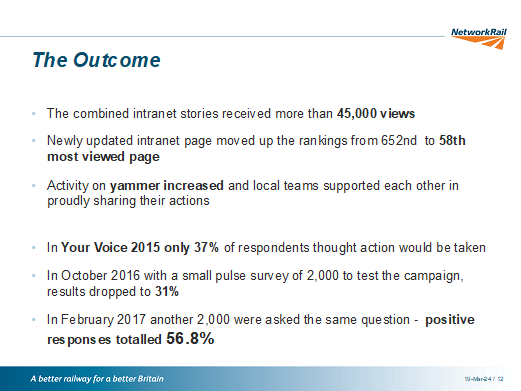
Another key part of this campaign was the opportunity it presented to bring together the HR and Internal Communications teams within Network Rail. While these teams work collaboratively in the national teams, the experience in the routes and business areas before this campaign began had been reported as ‘mixed’. By asking local communications teams and HR teams to use the collateral provided, looking for and publicising local stories, they were drawn together through a shared purpose.
Officially launched at the end of October 2016, a continuous programme of weekly activity and campaign content was delivered. This was supported by a robust plan to maintain momentum through bursts of news stories and videos. The most prominent element of the campaign was the posters, which were hung throughout our 11 busiest offices. This series of storytelling posters highlighted employees from all levels of the organisation alongside their feedback request, beside a senior colleague explaining how this feedback had been acted on. This truly brought the central strapline of “You Said” – “We did” to life.
Supporting these posters was a series of films highlighting in more detail how action had been taken in response to the issues raised in Your Voice which created a ‘mini-series’ that built throughout the campaign.
1. What do you imagine was the reason National Railway implemented the voice principle?
2. Can you describe how they operationalized the principle of voice?
3. Did the National Railway’s approach yield the results they expected?
4. What takeaways can you learn from the National Railway case as you consider putting BS principles to work in your company?

Exercise 2
2. Create your personal agenda for the first meeting.
3. Pair up with a person in the group and take turns role-playing how you would open the meeting, discuss expectations, and then close the meeting. Give each other feedback on how it felt to be the research analyst and how it felt to be the BSPL.

Course Manual 11: Selling Science
The field of Behavioral Science is a fascinating, powerful, and fast-emerging area. It has the potential to make a very large impact on organizations, sometimes in surprising ways, and with relatively minimal resources. And yet, like anything new, it may be difficult for some employees in your organization to jump on board.
This manual will help you prepare to talk to your stakeholders about Behavioral Science and the process of solving challenges using BS. Since many of your stakeholders may not be familiar with BS or what is possible, you’ll need to inform and sell them on the idea, the process, and the exciting possibilities in order to help them engage fully with your project.
You may want to prepare a formal presentation for stakeholders, but you should also be able to speak about BS in a casual conversational manner for hallway and elevator conversations. Since there is some complexity in the way you talk about BS, it’s helpful to commit some phrases or ideas about BS to memory so you aren’t searching for words each time you someone asks you a question or you find an opportunity to advocate for the approach. It is also recommended that you work with your team to align on the language and phrases you want to use when you talk about BS so everyone is sending the same message.
This section will walk you through some of the building blocks you may want to include in your message to others about BS. It will also offer recommendations to do this in a compelling way to help them understand and buy into what is involved. You may want to build multiple decks of slides or different packages of information that will appeal to different audiences. The following information gives you a framework of five important components to include in your message and story.
1. Define BS: The first step is to define the term. It may be helpful to explain the term’s roots and the scope of information included in the field.
2. Guiding Principles: This includes the guiding principles and core elements that are essential in the use of BS.
3. Examples: Next, it will be helpful to share 2-3 brief cases of how BS has made a difference in other business areas. After you have a couple of projects under your belt, you can add your own stories from inside your company.
4. BS Process: Explain the BS process, how to leverage the power of BS to get different results, and why it’s different from the other approaches.
5. Call to Action: This is where you ask for what you need from the individual to move the BS agenda forward.
At the end, we’ll also cover some common objections and how you might address them.
1. Define BS
This is not as easy as it looks. To start with, BS is still a relatively new field. In addition, it’s a very broad disciple. Even experts have different opinions about how to define it. The sheer depth and breadth of the research in this area is mind-boggling. Since it incorporates elements of psychology, neuroscience, economics, and social psychology, definitions may focus on or lean toward an emphasis on one of those areas. This often depends on which field the expert/researcher’s knowledge and work were grounded in. In your situation, you will likely want to leverage a definition that is practical and business focused.
We provide a few brief definitions below for the purposes of this program, along with some extensions you may want to add for a more thorough definition. You could also do some internet research on your own if these definitions don’t resonate with you or meet the needs of your business.
• Behavioral science examines how psychological, social, and environmental factors influence our actions.
• Behavioral science studies decision making in various environments. We interpret and apply the science to create meaningful change in behavior.
• BS is the study of human behavior, which includes how your customers and employees make decisions, and what they do and buy in real-life situations.

Extensions of the definitions:
Where it comes from:
The field started when researchers in economics discovered that people often don’t do what they should do or act in the most rational way. Behavioral Science was born from a desire to understand why and how this happens and what we can do to overcome those limitations.
Business Application:
o Today, in business, we use this science to build a better mousetrap. For example, how can the design of an invoice to influence the accounts receivable payment rates (attention and cognitive load)? Why are employees more willing to try a new process when they learn that their peers are using it (social proof)?
o Behavioral science gives us the tools to uncover how people actually behave. These insights can lead to improvements in products and services that deliver better sales, lower costs, and better experiences.
o Behavioral science helps employees make better choices by guiding them to be precise in identifying their goals, desired behaviors and outcomes.
o The process helps move from relying on assumptions to making data-based decisions.
2. Guiding Principles

Diagnostic: The BS approach includes working to deeply understand the challenge and specify the root causes.
Evidence: Data is the foundation of the BS process. It begins with making an accurate diagnosis of the current state and problem. This emphasis carries through to pilot-testing solutions as well as measuring outcomes and results. BS advocates using evidence to determe how an influence changes.
Focused on Behaviors: In BS, we acknowledge that thoughts and emotions drive behaviors, but our work starts and ends with behavior. We may design solutions to overcome attitude and mindset barriers, but they serve to change behavior.
Environment: The situation and context of a scenario influence behavior. For example, someone who typically speaks up in a meeting may be quieter when their boss is in the room or the topic of conversation is something they don’t know much about. When working to influence behavior, BS targets changing aspects of the environment to make it more conducive to the desired behavior.
3. Vivid Examples
In order to help your audience really understand what all these concepts mean, you’ll need to provide some examples of BS cases or stories that will resonate with them. Some examples are provided below, but you can also use some of the case studies provided in this program or do some research to uncover others that clearly demonstrate the power of BS.
Here are a couple verbal examples, and then several presentation slide examples.
• We’ve learned that even very small psychological pushes, or “nudges,” can have a huge impact on employee performance. For instance, did you know that customers are more likely to choose a more expensive product when presented with two options, but only when a third, even more expensive product is also available (choice architecture)? Similarly, would your web-design team be surprised to find out that repositioning the words and images on your website can increase sales?
• Have you ever wondered why people are willing to pay so much for Apple products? That’s right, Apple used behavioral science to design their products and marketing to create repeat customers.
If you are creating a presentation, which is strongly advocated, it’s helpful to use vivid examples (e.g., large words, bright colors, pictures, graphs). Below are just a few examples of the many principles of behavioral science and how they can have a big impact on your business. We haven’t covered these BS principles yet, but the slides should give you an idea of how to highlight the results that have been achieved with BS with small changes.
Image too detailed
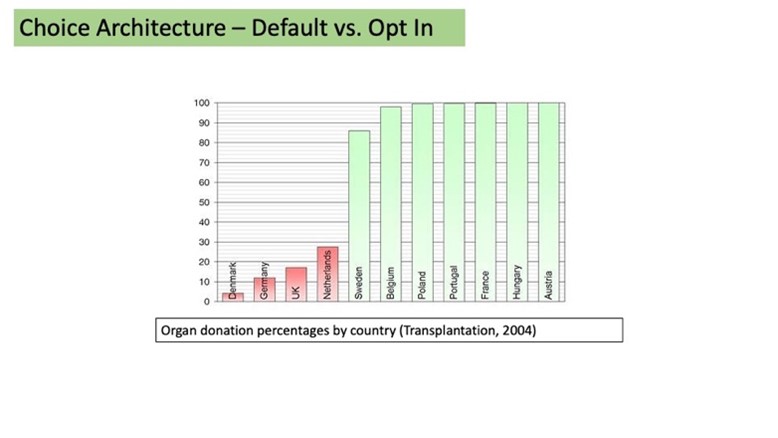
This last study is a popular example of how giving citizens the choice to be an organ donor results in low participation in the program (see countries listed in red on the left). Alternatively, the countries listed in green on the right add their citizens to the program automatically (by default), and citizens can opt out if they decide they don’t want to participate. This simple change in policy obviously let to very significant differences.
Another way to leverage examples is to note other companies that are leveraging BS. This idea leverages the BS principle of FOMO (Fear of Missing Out).
Understanding Fear of Missing Out (FOMO): The title of this principle is pretty clear and obvious. FOMO is a worry that a person is missing out or not being included in a good experience that others are having. No one wants to be excluded or miss a good time. This is a powerful principle that can influence behavior. In our hyper-connected world with endless access to updates on events, posts from friends, and news, there’s a healthy amount of fear that we might be missing something important.
Below is an example of a FOMO message about BS.
Don’t get left behind! Large and small companies like Amazon, Google, Netflix, Wal-Mart, Coca-Cola, IBM, Pepsi, Nestle, Facebook, Snapchat, Bumble, Morningstar, NASDAQ, Headspace, Calm, and Lemonade are just a few of the companies leveraging behavioral insights to succeed. There’s no doubt this field is taking off. Don’t be left behind by your competition.
Stay competitive! Understanding human behavior is becoming increasingly important for remaining relevant with your customers. Their appetite for smart, well-designed, easy-to-use products and services that are smart, designed well, easy to use, and make their lives better is growing. Like you, they are “wowed” by the new features they are exposed to every day on their favorite apps, websites, the services from the hospitals and entertainment venues they visit, and in the products they use. Because your customers are delighted by these changes, they are likely to have even stronger reactions when they experience frustrations with packaging, products that aren’t intuitive, confusing technical terminology, and websites that are difficult to navigate. Can you remain relevant when your competitors are leveraging Behavioral Science and you aren’t?
4. The BS Process
Next, it’s important to clarify what the BS process will include. At this stage in the process, it is helpful to make this fairly high level. An example of the BS process used for this program is included below. In your process, you may want to emphasize or accentuate particular aspects. For example, in this version of the process, experimentation and data analysis are not given a great deal of attention, even though they are critical parts of the process.
Below are a couple of verbal descriptions of the process, followed by a visual example.
o The Behavioral Science process will help you identify small changes that yield big results. It will will help you break your problem down, diagnose gaps between current and future states, identify the most critical behaviors, and put plans in place with the best ROI to get the results you need.
o The process starts with a clear definition of your goals and progresses to an assessment of the current state and gaps from a Behavioral Science lens. The next steps involve identifying what behaviors specifically need to change, what barriers exist, and how to identify strategies and tactics to overcome the obstacles. Finally, the solutions can be pilot tested to determine their effectiveness before being implemented full-scale. Of course, as a scientific discipline, BS includes an emphasis on discovery, testing assumptions, experimentation, and measurement of results. While these steps may not be new to you, working from a Behavioral Science perspective will yield different results.
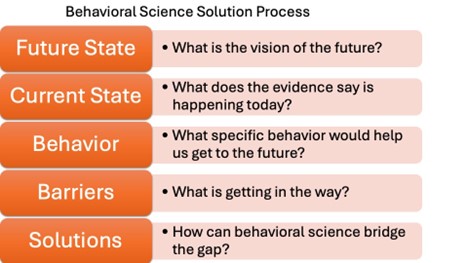
5. Call to Action
After you share your presentation or hallway conversation about BS, be sure to close with a call to action. If you are meeting with a stakeholder, you may be asking them to join your team, provide data, or give you input on your process.
If you are talking with a colleague, you might ask if they would like to try the approach with one of their projects or if you can schedule a follow-up meeting to go into more detail.
Handling Objections:
The next section covers some common objections to BS and how to overcome them:

Optional Advice:
Pointing out the problems with your company’s way of working right now (before BS) could lead to defensiveness. When people take offense, they are less likely to be able to process information in a rational way and may not be able to hear the rest of what you have to say. To avoid negatively triggering your audience, try to frame the current state of the process and methods as a well-intentioned approach that has opportunities for improvement.
One alternative to address this issue is to contrast the current state with what it could be when leveraging BS. A tool that can help with this is a “From and To” table.
Leveraging Behavioral Science:
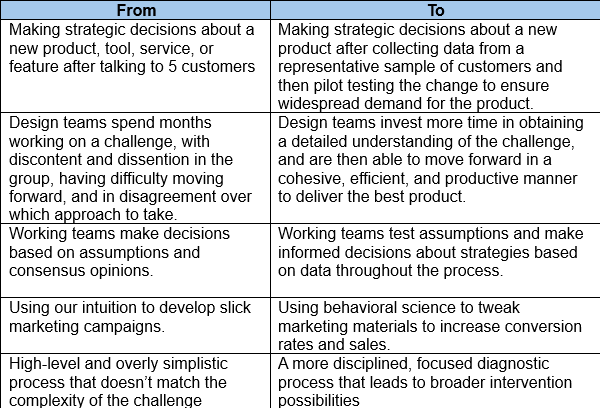

Case Study: FOMO Cases
Source: Click Here
Amazon Prime Day: The Ultimate FOMO Extravaganza
Amazon’s Prime Day is a massive global shopping event that offers Prime members exclusive deals on millions of items. Prime Day is an annual event that celebrates Amazon Prime members and provides them with exclusive deals on millions of products across all categories. It first launched in 2015 and has since become one of the biggest shopping holidays of the year. Prime Day is open to all Prime members, which includes those who have a 30-day free trial or are paying monthly.
What can you expect on Prime Day?
Expect to find deals on everything from TVs and laptops to kitchen appliances and Amazon devices. In fact, there will be more than one million deals available worldwide. Plus, new this year, select small businesses and entrepreneurs will offer their own exclusive deals as part of Amazon’s Prime Day.
How do I get the best deals on Prime Day?
The best way to score great deals on Prime Day is to be prepared. Make sure you’re a Prime member (you can sign up here if you’re not already), download the Amazon App, and create a list of items you’re interested in ahead of time. That way, you can act fast when the deals go live.
-Insight: Amazon’s annual Prime Day sale is a textbook example of FOMO in action. By creating a limited-time event exclusively for Prime members, Amazon taps into consumers’ fear of missing out on incredible deals.
Amazon teases Prime Day weeks in advance, building anticipation. On the day itself, lightning deals with countdown timers create urgency. The result? A frenzy of purchases as consumers rush to snag discounted items before the clock runs out.
Remember, successful FOMO marketing isn’t about creating panic—it’s about tapping into genuine excitement and desire. By understanding your audience and strategically using scarcity, urgency, and social proof, you can create memorable campaigns that resonate with consumers’ deepest fears and aspirations.
Independent Work: In what ways does amazon leverage BS with Amazon Prime Day?
Large group discussion:
1. Do you think most people are aware of their own feelings of FOMO?
2. Does being aware of FOMO make a person less susceptible to the influence of the tactic?
3. Could this tactic be overused? If so, how?
4. Where else have you seen or experienced FOMO?

Exercise
1. How will these definitions go over in your company? Too academic or not scientific enough?
2. It will be very helpful for you to have a common, agreed-upon definition that you use at your company. What will be important to include in the definition you use?
3. Discuss what is going to work best in your company.

Course Manual 12: Next Steps
This course manual completes Module 1 on planning for the BS process to start. As you can see, a lot of behind-the-scenes prep work is needed to get off on the right foot. This manual will allow you to take a step back and pull it all together. In the next module, you’ll focus on setting a future goal and then specific outcomes for the project.
So, let’s review what you’ve accomplished in this module and the work ahead for you in the next month.
Start Planning. In the first manual, you learned about how to think about planning to launch the BS area or project team in your firm. The session covered the types of challenges you can bring to the table and resolve through the BS process. The follow-up action items from this section are to: identify appropriate project for the BS approach, identify risks, develop a high-level project plan and timeline.

Process Leader. As a BSPL, you learned more about your role and the expectations of what is needed to be successful. An important consideration at this point may be to leverage a co-leader, especially during your first couple of projects. It is extremely helpful to have another perspective as you navigate the steps of the project and to carry the load. The co-leader could be someone in the business area or another BSPL. As a matter of fact, you are at a great advantage having multiple people in your organization go through this training. It’s probably a good idea to pair up for your initial projects. If that isn’t possible, you could schedule debrief meetings to discuss what is working and brainstorm possible solutions together as you encounter new challenges. Finally, if you do not feel equipped or confident in any of the areas you need to take on (e.g., project manager, facilitator, research crusader), give some thought to how you can build those skills or if you can leverage someone else on your team to help you with those responsibilities.
Define Problem. You really can’t start this work until you decide which project you are going to tackle. You can also draft your initial problem statement, knowing it is likely to go through several iterations.
Identify your challenge. Below are some considerations for what makes a good challenge for the BS process.
• A challenge that will not be easy to solve
• Has implications for people, not just machines (e.g., customers, employees, users, etc.).
• It may be something that has been a challenge for a long time that no one has been able to solve or make sufficient progress addressing.
• Not too big. It must be manageable (e.g., something that could be addressed in a 12-month timeframe so you can work in parallel with this program).
• A challenge in which you would be able to involve others in the company.
Alternatives. Another great option is to bring an idea for a problem your organization needs to solve or a new product that has not been formally assigned yet. If you have the opportunity to work on a new idea or challenge that isn’t being actively pursued by the organization (e.g., maybe it’s too big to tackle, there are not enough resources now, or it’s not a priority), you should learn and apply the process at your own pace. This allows you to work in a “safe zone” without too much pressure to accelerate in a way that’s not aligned with the learning. Eventually, you can integrate the project into your organization’s processes after you’ve made good progress on a solution.
While it’s always ideal to start from the beginning, it’s often very difficult in real organizations. The process and tools introduced in the program will allow you to contribute in a new way, regardless of the stage of development.
Another option, but not as good as a new project, is to do a post-mortem on a project that didn’t go as well as you would have liked to see what types of different solutions you would arrive at with this process.
Identify Stakeholders. It will be important to begin making a list of the people you will need for your project. In addition, if you do not have the people or skill sets in your company, it will be important to start identifying which external businesses you want to work with to fill those needs. Sometimes it can take a while to qualify a business and work through the sourcing and contracting phases of a project, so it’s a good idea to start that early. It will be helpful to fill out the RASCI table when you put your list together, so you can see where you have gaps that need to be filled. This takes some time because it requires you to also map out the work steps. This would be a good time to engage a project manager if you are able to obtain a resource for your project.
Current Evidence. There are two very important steps needed in this area. First, begin to catalog existing data in your tracking template. Remember, this may include quantitative as well as qualitative data. In fact, at this point, some of your data will be anecdotal. However, it’s still important to capture it, just be sure to note the source. The second critical step is to start documenting the questions you have as well as the stakeholders you are starting to meet.
Attitude Matters. This section provides you with the groundwork to begin thinking about how you are going to answer some of the questions you are compiling. For this step, it will be important to connect with your research stakeholder to learn more about their process for getting work done.
Research Agenda. This section will help you prioritize the many questions and research requests you have uncovered in your work so far. For this work, it may be helpful to meet with your data analyst and include your research expert. You can begin to have discussions about how to secure resources in their areas and their initial thoughts about the scope and scale of some of the data insights you need to answer important questions.
Collect Insights. In this step, you will be starting to consider which data methodology you want to employ to collect the insights you need. You’ll also be able to start investigating what is feasible in your organization. This section will help you understand what is involved, so you can make some estimates about the scope and scale of the research needed. This is the time to get some of the research started.
Analyze Insights. This section provides detail about leveraging the survey data collection methodology, which is likely to be one of your primary tools. It also covers analyzing the data, in particular thematic analysis needed for qualitative data analysis. Finally, you’ll be better prepared with best practices for reporting on the data to help your stakeholders interpret insights in the most useful way.
Engage Stakeholders. This section will help you plan to start having meetings with your stakeholders in the most productive way. Before you start the meetings, you need to make sure you have the following deliverables ready for the meetings: Evidence table, Problem Statement, BS Process, Expectations, Call to Action. In addition, you’ll need to draft your agenda and schedule the meetings.
Selling Science. In this section you learn about how to put together a message about the BS process. You need to decide on a definition, guiding principles, vivid examples, and an overview of the process. A best practice is to align with your team on a common language and message for them to share.
The BSPL’s Attitude and Mindset
As you consider the list of tasks we just reviewed in order to get your project started and off the ground, you may be having some thoughts or emotions. For example, some BSPLs could be very excited about the work ahead and the opportunity to learn more about BS and make a big difference. Others may be feeling less optimistic because they are feeling overwhelmed by the amount of work or less confident about their ability to be successful at some of the tasks.
Alternatively, other BSPLs may be feeling the work is going to be fairly simple and wonder what all the fuss is about. These varied reactions present a great opportunity to introduce additional behavioral science concepts and increase your understanding. We will also provide some tips on how to manage these mindsets.

When people are feeling overwhelmed or fearful, they enter a state of fight/flight, which limits their ability to make good decisions and function effectively. The phenomenon is an example of brain science and the mind-body connection. It is further defined and explained below.
Fight or Flight
Our tendency to pay more attention to bad things and overlook good things is likely a result of evolution. Our ancestors had to scan the environment for danger and threats as a matter of life or death (e.g., predators approaching). When danger was detected, the body reacted with a series of physiological changes designed to prepare for a fight or a “flight” to escape. People were more likely to survive if they paid more attention to negative information because there were bigger consequences than if they didn’t (Baumeister et al., 2001).
For example, a high conflict situation can trigger your heart to pound, muscles to tense, blood to flow away from extremities, and the breath to quicken—all physiological reactions to prepare for fight or flight. Focused attention on dangers kept people alive in the past.
Understanding Fight or Flight Response: The instinctive sequence of hormonal and physiological responses to a threatening situation, which readies one either to resist forcibly or run away.
Source: Understanding the Stress Response, Harvard Health Publishing (2020).
Although those same types of physical threats don’t exist, the brain continues to scan for and focus on the negative as a way of keeping us safe. The fight-flight response is also triggered by threats of potential emotional “dangers.” When it comes to a quick survival reaction, your brain is operating on automatic, and doesn’t differentiate between physical and emotional stimuli. When we feel overwhelmed by learning a new process or lack confidence and fear of failure, we can experience the fight-flight response. Likewise, when we experience stakeholders’ criticism or an upcoming change, it can put us in fight-flight mode. Once more, our survival instincts program our brains to detect danger, prompting us to switch into protective mode.
What is the impact of the fight-flight response activation? In these situations, our ability to objectively perceive information, listen clearly, and process information effectively may be impaired due to the body’s reprioritization and mobilization of its most critical resources, from your perception and thought processes to your fight/flight needs.
As a side note, this physiological response to emotional “threats” can be triggered by something as simple as an argument over whose turn it is to cook dinner. It is essentially an overreaction by the body. Over time, this repeated activation of the stress response can take an unhealthy toll on the body.

Exercise 1
• What are the implications of the fight-flight response for your clients? For your employees?
• What considerations should you make regarding changes or new products and services for clients and employees?
• Are you familiar with or aware of any of your bodily stress responses (e.g., tight chest, stiff neck, short breath)?
• Can you point to any situations that may have triggered your fight-flight response?
• What can you do if you become aware that you are triggered?
• What are the implications of the fight-flight response for the project team?
• What can you do to eliminate any negative impacts from the response?
Overconfidence Bias
A second BS principle that will be introduced is the Overconfidence bias. This may apply to a BSPL who is feeling extremely confident about their ability to prepare for and launch the BS process.
The Overconfidence Bias is fairly straightforward and highlights the tendency to be overconfident in our abilities and decisions. For example, in one research study, participants were asked to rate their driving skills. In a typical sample of the population, you would expect most people to be average and only a small proportion to be above and below average (i.e., normal distribution curve). However, this research found that almost 80% of participants thought they were above-average drivers (McCormick, et al., 1986). By definition, it is impossible for the majority of drivers to be above average. Clearly, these drivers were biased about their own driving abilities. This bias extends well beyond driving abilities. The same effect has been shown to occur in self-ratings of job and academic performance, estimates of IQ, healthy behaviors, memory, and even our own popularity.
Understanding Overconfidence: This bias is the tendency to overestimate our abilities and talent. We mistakenly believe that we are better than we actually are.

The tendency to be overconfident doesn’t necessarily mean that you are arrogant; rather, we all like to think the best of ourselves and don’t like to think we aren’t as good as others. The goal of introducing the overconfidence bias is not to challenge your skills or talents. What’s relevant here is to remember that we are all subject to errors in judgment due to biases.
Overcoming Biases
To start to move forward, we have to find ways to combat these brain biases. You will need to take additional steps to rewire your brain and challenge your automatic conclusions. Below are some steps to help you move in that direction:
1) Awareness: Be aware of these biases that influence your thinking and decisions. Begin to spot them so you can slow the automatic processes.
2) Seek Truth: Test your assumptions.
• Ask questions to confirm your judgments.
• Look for: Alternative explanations – why else could this have happened?

Exercise 2
• What are the implications of the overconfidence bias for your clients? For your employees?
• What considerations should you make regarding changes or new products and services for clients and employees?
• Are you familiar with or aware of any situations where you may be demonstrating an overconfidence bias?
• What can you do if you become aware that you are operating in that space?
• What are the implications of the overconfidence bias for the project team?
• What can you do to eliminate any negative impacts from their bias?
Closing comments:
As you finalize the planning phase of the BS process and begin to officially launch it, there are a couple of things to keep in mind.
Stay flexible and adapt. Unlike other projects, this one will likely be in a regular state of flux. For example, it is not uncommon to add, lose, and replace people throughout the course of the project. Keeping a good, updated listing of source documents (problem statement, evidence tracking form, question log, etc.) can help you prepare to onboard new stakeholders regularly.
As you’ve probably figured out, implementing a BS program in your organization is a challenging task. As a BSPL, you will need to be a resilient change agent. Try not to take any opposition personally. It is just the normal process of change. Hold the course and be a confident, strong change agent.
Finally, try to enjoy the journey. You will definitely be learning a lot, but it’s a very rewarding process to lead.

Case Study
The Big Idea: Before You Make That Big Decision…
Dangerous biases can creep into every strategic choice. Here’s how to find them—before they lead you astray.
By Daniel Kahneman, Dan Lovallo, and Olivier Sibony; From the Magazine (June 2011)
Source: https://hbr.org/2011/06/the-big-idea-before-you-make-that-big-decision
Note: This is an excerpt from a longer article.
A major acquisition.
Devesh is the CEO of a diversified industrial company. His business development team has proposed purchasing a firm whose offerings would complement the product line in one of the company’s core businesses. However, the potential deal comes on the heels of several successful but expensive takeovers, and the company’s financial structure is stretched.
Is the base case overly optimistic?
Most recommendations contain forecasts, which are notoriously prone to excessive optimism. One contributing factor is overconfidence, which could, say, lead Devesh’s team to underestimate the challenge of integrating the acquired company and capturing synergies. Groups with a successful track record are more prone to this bias than others, so Devesh should be especially careful if the business development team has been on a winning streak.
These biases are exacerbated in most organizations by the inevitable interplay (and frequent confusion) between forecasts and estimates on the one hand, and plans or targets on the other. Forecasts should be accurate, whereas targets should be ambitious. The two sets of numbers should not be confused by senior leadership.
Correcting for optimistic biases is difficult, and asking teams to revise their estimates will not suffice. The decision maker must take the lead by adopting an outside view, as opposed to the inside view of the people making proposals.
Several techniques help promote an outside view. Lisa could construct a list of several similar investment projects and ask her team to look at how long those projects took to complete, thus removing from the equation all inside information on the project at hand. Sometimes, removing what appears to be valuable information yields better estimates. In some situations, decision makers might also put themselves in the shoes of their competitors.
1. What are the risks of overconfidence in an organization?
2. What challenges could arise if customers are overconfident about a product or a competitor’s product?
3. Recognizing that overconfidence is not a result of deficient analysis or a personality flaw, but instead it’s just a bias, how can we help others’ recognize their opportunities to reduce the bias?
What strategies might help to address overconfidence?
Project Studies
Project Study (Part 1) – Customer Service
The Head of this Department is to provide a detailed report relating to the Successful Planning process that has been implemented within their department, together with all key stakeholders, as a result of conducting this workshop, incorporating process: planning; development; implementation; management; and review. Your process should feature the following 12 parts:
01. Start Planning
02. Process Leader
03. Define Problem
04. Identify Stakeholders
05. Current Evidence
06. Attitudes Matter
07. Research Agenda
08. Collect Insights
09. Analyze Insights
10. Engage Stakeholders
11. Selling Science
12. Next Steps
Please include the results of the initial evaluation and assessment.
Project Study (Part 2) – E-Business
The Head of this Department is to provide a detailed report relating to the Successful Planning process that has been implemented within their department, together with all key stakeholders, as a result of conducting this workshop, incorporating process: planning; development; implementation; management; and review. Your process should feature the following 12 parts:
01. Start Planning
02. Process Leader
03. Define Problem
04. Identify Stakeholders
05. Current Evidence
06. Attitudes Matter
07. Research Agenda
08. Collect Insights
09. Analyze Insights
10. Engage Stakeholders
11. Selling Science
12. Next Steps
Please include the results of the initial evaluation and assessment.
Project Study (Part 3) – Finance
The Head of this Department is to provide a detailed report relating to the Successful Planning process that has been implemented within their department, together with all key stakeholders, as a result of conducting this workshop, incorporating process: planning; development; implementation; management; and review. Your process should feature the following 12 parts:
01. Start Planning
02. Process Leader
03. Define Problem
04. Identify Stakeholders
05. Current Evidence
06. Attitudes Matter
07. Research Agenda
08. Collect Insights
09. Analyze Insights
10. Engage Stakeholders
11. Selling Science
12. Next Steps
Please include the results of the initial evaluation and assessment.
Project Study (Part 4) – Globalization
The Head of this Department is to provide a detailed report relating to the Successful Planning process that has been implemented within their department, together with all key stakeholders, as a result of conducting this workshop, incorporating process: planning; development; implementation; management; and review. Your process should feature the following 12 parts:
01. Start Planning
02. Process Leader
03. Define Problem
04. Identify Stakeholders
05. Current Evidence
06. Attitudes Matter
07. Research Agenda
08. Collect Insights
09. Analyze Insights
10. Engage Stakeholders
11. Selling Science
12. Next Steps
Please include the results of the initial evaluation and assessment.
Project Study (Part 5) – Human Resources
The Head of this Department is to provide a detailed report relating to the Successful Planning process that has been implemented within their department, together with all key stakeholders, as a result of conducting this workshop, incorporating process: planning; development; implementation; management; and review. Your process should feature the following 12 parts:
01. Start Planning
02. Process Leader
03. Define Problem
04. Identify Stakeholders
05. Current Evidence
06. Attitudes Matter
07. Research Agenda
08. Collect Insights
09. Analyze Insights
10. Engage Stakeholders
11. Selling Science
12. Next Steps
Please include the results of the initial evaluation and assessment.
Project Study (Part 6) – Information Technology
The Head of this Department is to provide a detailed report relating to the Successful Planning process that has been implemented within their department, together with all key stakeholders, as a result of conducting this workshop, incorporating process: planning; development; implementation; management; and review. Your process should feature the following 12 parts:
01. Start Planning
02. Process Leader
03. Define Problem
04. Identify Stakeholders
05. Current Evidence
06. Attitudes Matter
07. Research Agenda
08. Collect Insights
09. Analyze Insights
10. Engage Stakeholders
11. Selling Science
12. Next Steps
Please include the results of the initial evaluation and assessment.
Project Study (Part 7) – Legal
The Head of this Department is to provide a detailed report relating to the Successful Planning process that has been implemented within their department, together with all key stakeholders, as a result of conducting this workshop, incorporating process: planning; development; implementation; management; and review. Your process should feature the following 12 parts:
01. Start Planning
02. Process Leader
03. Define Problem
04. Identify Stakeholders
05. Current Evidence
06. Attitudes Matter
07. Research Agenda
08. Collect Insights
09. Analyze Insights
10. Engage Stakeholders
11. Selling Science
12. Next Steps
Please include the results of the initial evaluation and assessment.
Project Study (Part 8) – Management
The Head of this Department is to provide a detailed report relating to the Successful Planning process that has been implemented within their department, together with all key stakeholders, as a result of conducting this workshop, incorporating process: planning; development; implementation; management; and review. Your process should feature the following 12 parts:
01. Start Planning
02. Process Leader
03. Define Problem
04. Identify Stakeholders
05. Current Evidence
06. Attitudes Matter
07. Research Agenda
08. Collect Insights
09. Analyze Insights
10. Engage Stakeholders
11. Selling Science
12. Next Steps
Please include the results of the initial evaluation and assessment.

Project Study (Part 9) – Marketing
The Head of this Department is to provide a detailed report relating to the Successful Planning process that has been implemented within their department, together with all key stakeholders, as a result of conducting this workshop, incorporating process: planning; development; implementation; management; and review. Your process should feature the following 12 parts:
01. Start Planning
02. Process Leader
03. Define Problem
04. Identify Stakeholders
05. Current Evidence
06. Attitudes Matter
07. Research Agenda
08. Collect Insights
09. Analyze Insights
10. Engage Stakeholders
11. Selling Science
12. Next Steps
Please include the results of the initial evaluation and assessment.

Project Study (Part 10) – Production
The Head of this Department is to provide a detailed report relating to the Successful Planning process that has been implemented within their department, together with all key stakeholders, as a result of conducting this workshop, incorporating process: planning; development; implementation; management; and review. Your process should feature the following 12 parts:
01. Start Planning
02. Process Leader
03. Define Problem
04. Identify Stakeholders
05. Current Evidence
06. Attitudes Matter
07. Research Agenda
08. Collect Insights
09. Analyze Insights
10. Engage Stakeholders
11. Selling Science
12. Next Steps
Please include the results of the initial evaluation and assessment.

Project Study (Part 11) – Logistics
The Head of this Department is to provide a detailed report relating to the Successful Planning process that has been implemented within their department, together with all key stakeholders, as a result of conducting this workshop, incorporating process: planning; development; implementation; management; and review. Your process should feature the following 12 parts:
01. Start Planning
02. Process Leader
03. Define Problem
04. Identify Stakeholders
05. Current Evidence
06. Attitudes Matter
07. Research Agenda
08. Collect Insights
09. Analyze Insights
10. Engage Stakeholders
11. Selling Science
12. Next Steps
Please include the results of the initial evaluation and assessment.

Project Study (Part 12) – Education
The Head of this Department is to provide a detailed report relating to the Successful Planning process that has been implemented within their department, together with all key stakeholders, as a result of conducting this workshop, incorporating process: planning; development; implementation; management; and review. Your process should feature the following 12 parts:
01. Start Planning
02. Process Leader
03. Define Problem
04. Identify Stakeholders
05. Current Evidence
06. Attitudes Matter
07. Research Agenda
08. Collect Insights
09. Analyze Insights
10. Engage Stakeholders
11. Selling Science
12. Next Steps
Please include the results of the initial evaluation and assessment.
Program Benefits
Marketing
- Customer Experience
- New Customers
- Customer Retention
- Evidence Based
- Resource Optimization
- Emotional Drivers
- Increased Conversions
- Brand Loyalty
- Successful Campaigns
- Competitive Advantage
Information Technology
- User Experience
- Intuitive Navigation
- Increased ROI
- User Engagement
- Gamified Experience
- User Engagement
- Technology enabled
- Self-Service
- Client Centric
- Secure Interface
Product Development
- Competitive Advantage
- Reduced Costs
- Innovative Design
- Value Added
- Enhanced Performance
- Increased Revenue
- Better Understanding
- Reduced Friction
- Amplify Benefits
- Identified Biases
Client Telephone Conference (CTC)
If you have any questions or if you would like to arrange a Client Telephone Conference (CTC) to discuss this particular Unique Consulting Service Proposition (UCSP) in more detail, please CLICK HERE.





























